Moon & Stars
Nighttime photography is one of the more surreal aspects of photography. Technology literally allows the camera to see in the dark, with for more depth and precisions than the human eye possibly could.
This unseen world is a world that is dominated by stars, and most specifically the Galactic Core of our very own Milky Way. It’s a world a love to venture into, often, and in the remotest and coldest spots. There are so many sights I have yet to capture, but I hope these introductory images can help you see with your eyes the things that I see with mine.


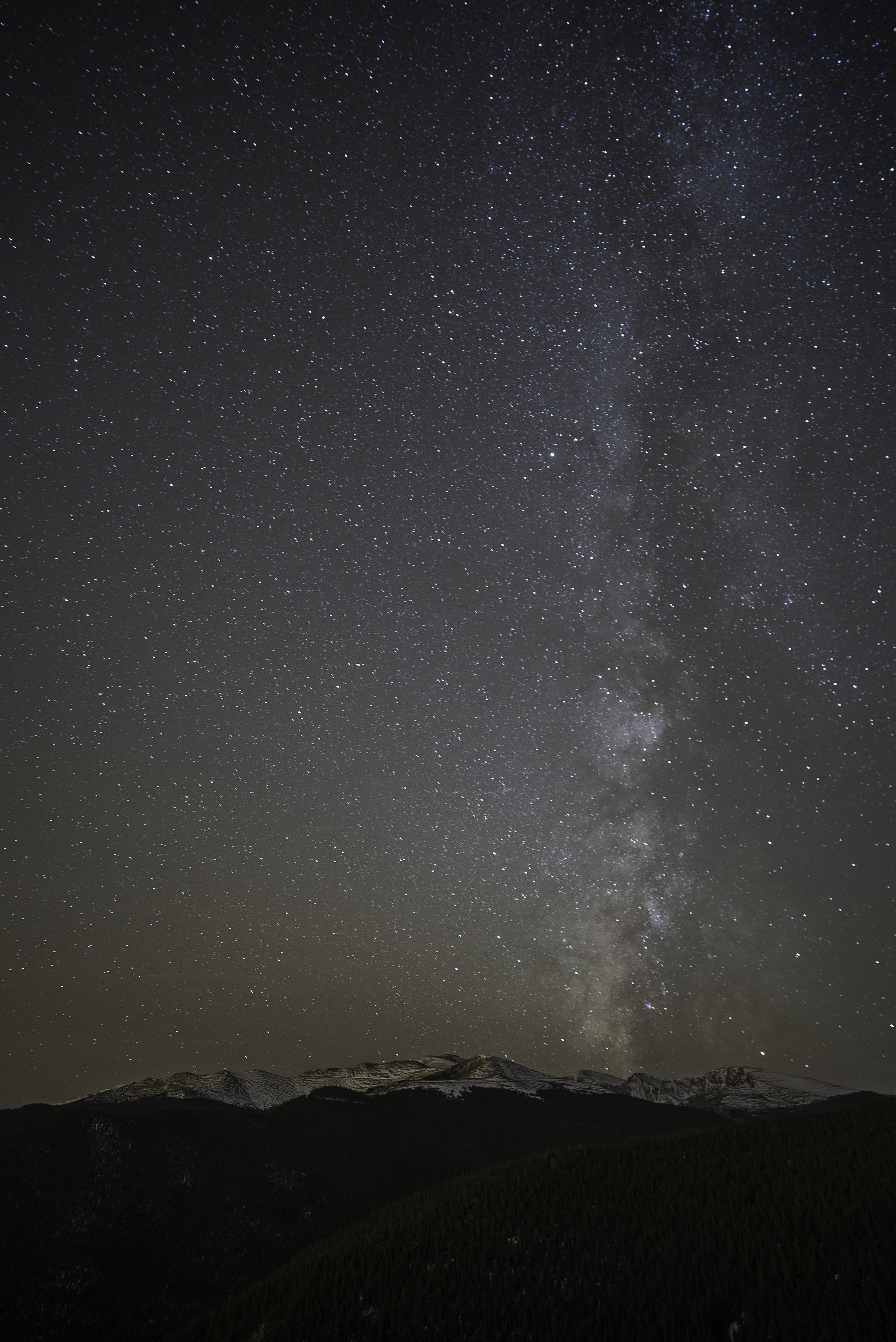
First "stacked" image of the Milky Way. Eight individual frames stacked together to create clarity in the final image. Quite happy with the results.
Sony a7s w/ Batis FE 18/2.8
Made from 8 light frames (captured with a SONY camera) by Starry Landscape Stacker 1.4.5.

Squaw Pass road, from Evergreen to Idaho Springs, cuts along the spine of a ridge on the north flank of Mt. Evans. It is a beautiful overlook and I need to remember how accessible it is, but because of it's proximity to the city the ambient light is very difficult to capture clean, detailed Milky Way images.
I have about two hours worth of images from March 10th and I have edited and reedited them multiple times. I wasn't careful enough when setting my camera up, so getting a final, clean image has been a challenge.
Made from 20 light frames (captured with a SONY camera) by Starry Landscape Stacker 1.5.1.

Nighttime photography is one of the more surreal aspects of photography. Technology literally allows the camera to see in the dark, with for more depth and precisions than the human eye possibly could.
This unseen world is a world that is dominated by stars, and most specifically the Galactic Core of our very own Milky Way. It’s a world a love to venture into, often, and in the remotest and coldest spots. There are so many sights I have yet to capture, but I hope these introductory images can help you see with your eyes the things that I see with mine.

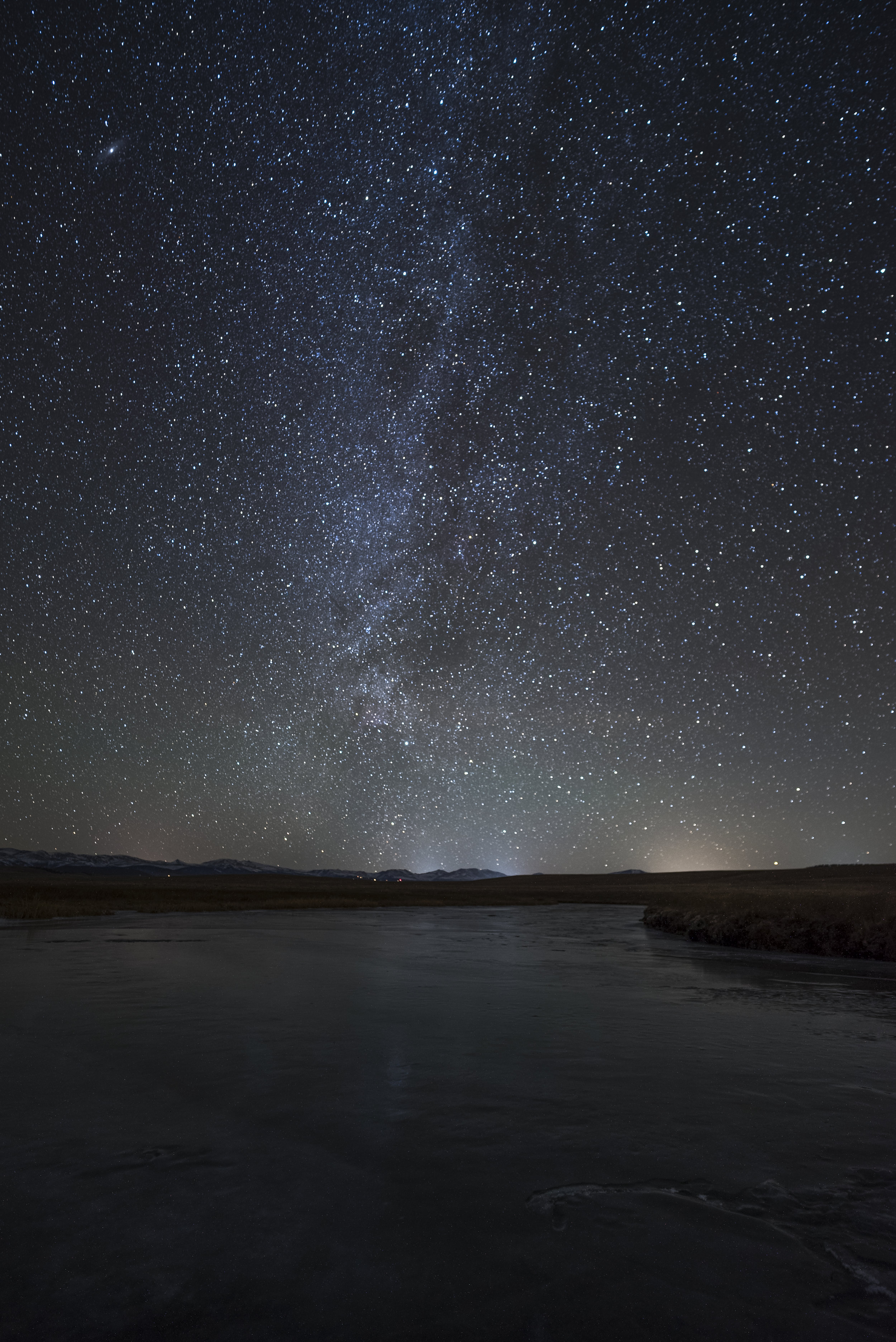
The frozen South Platte made for a perfect compliment to the the mid-winter Milky Way. Though most photographers and astronomers prefer to peer into the core, and I do too, the dark skies could not be ignored here.
Made from 30 light frames (captured with a SONY camera) by Starry Landscape Stacker 1.4.5.
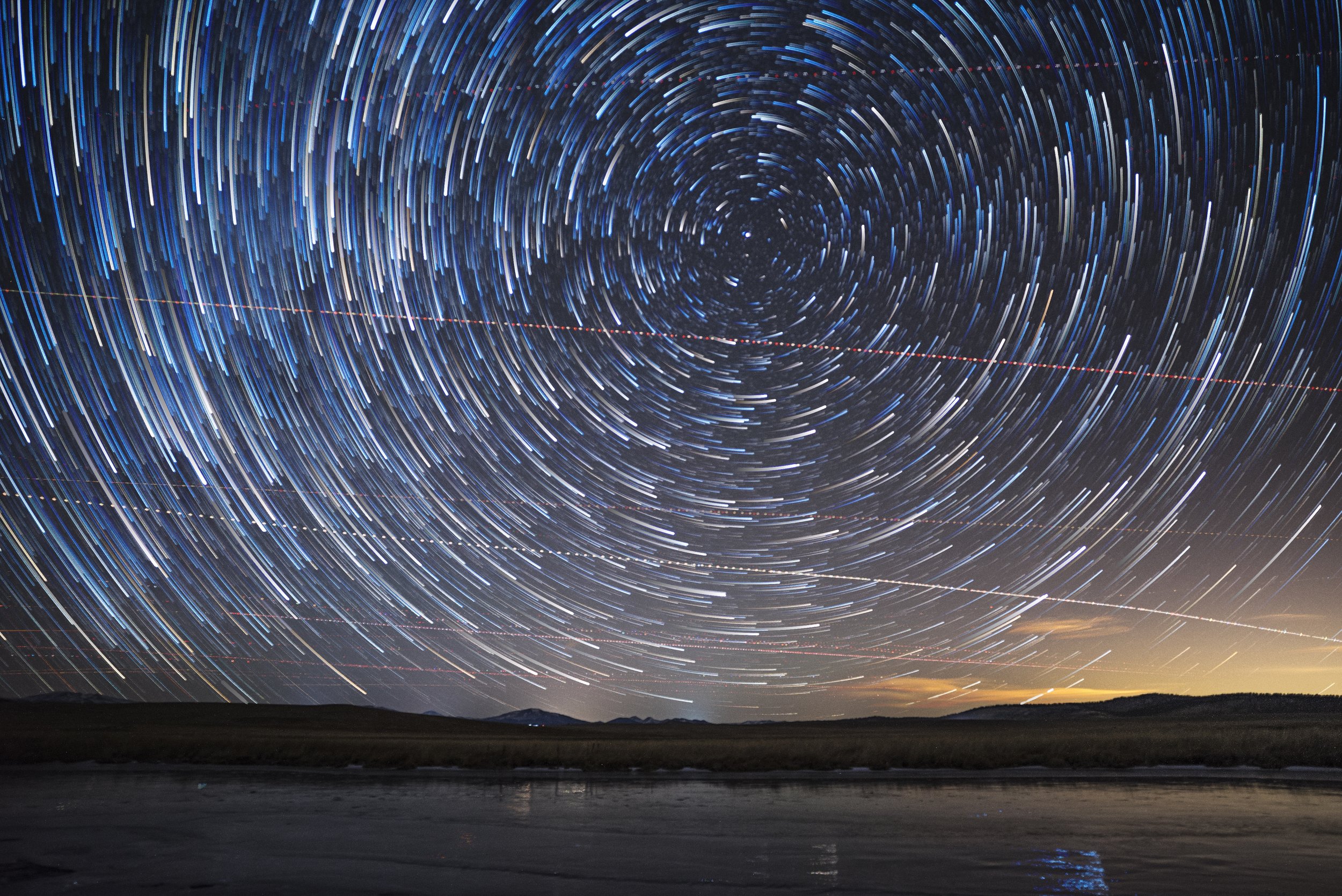
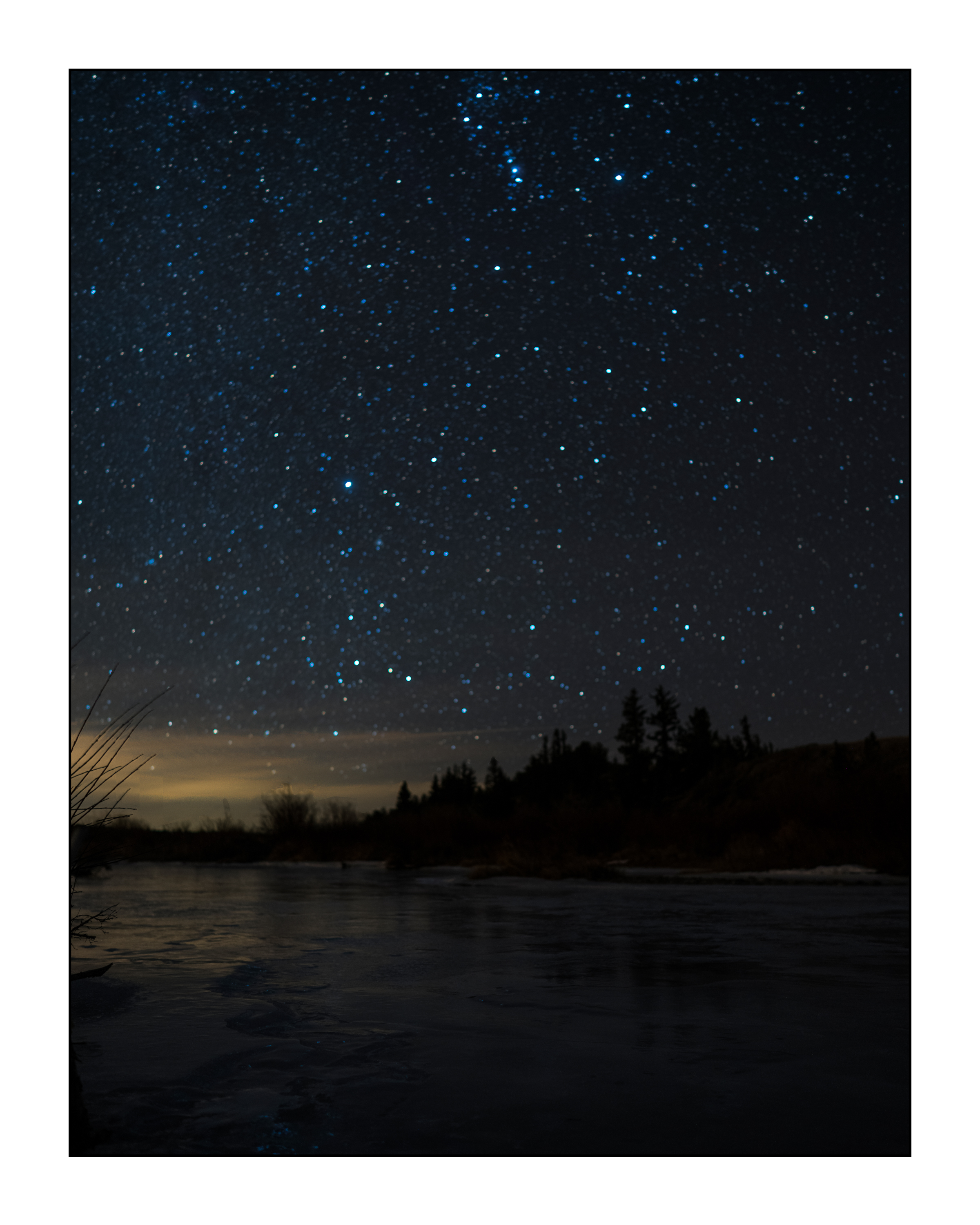


I had planned for a time lapse of the rising Milky Way. The clouds were too thick initially, and I was later than I had intended to be finding this location. I just hadn't planned well enough for this first outing.
Single image exposure, taken from about 100 hundred images of the sky that morning.
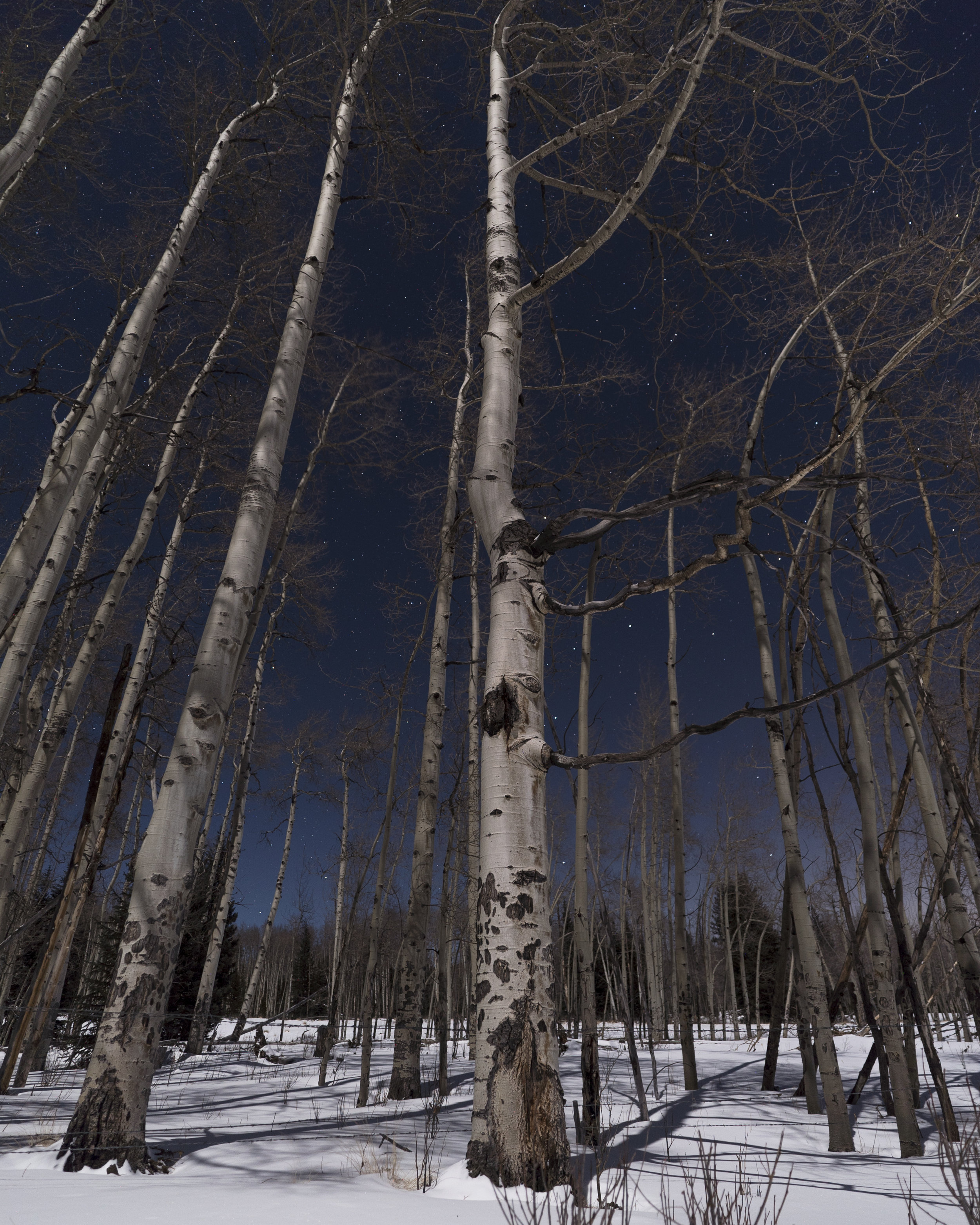
Find the Big Dipper, find your way home...
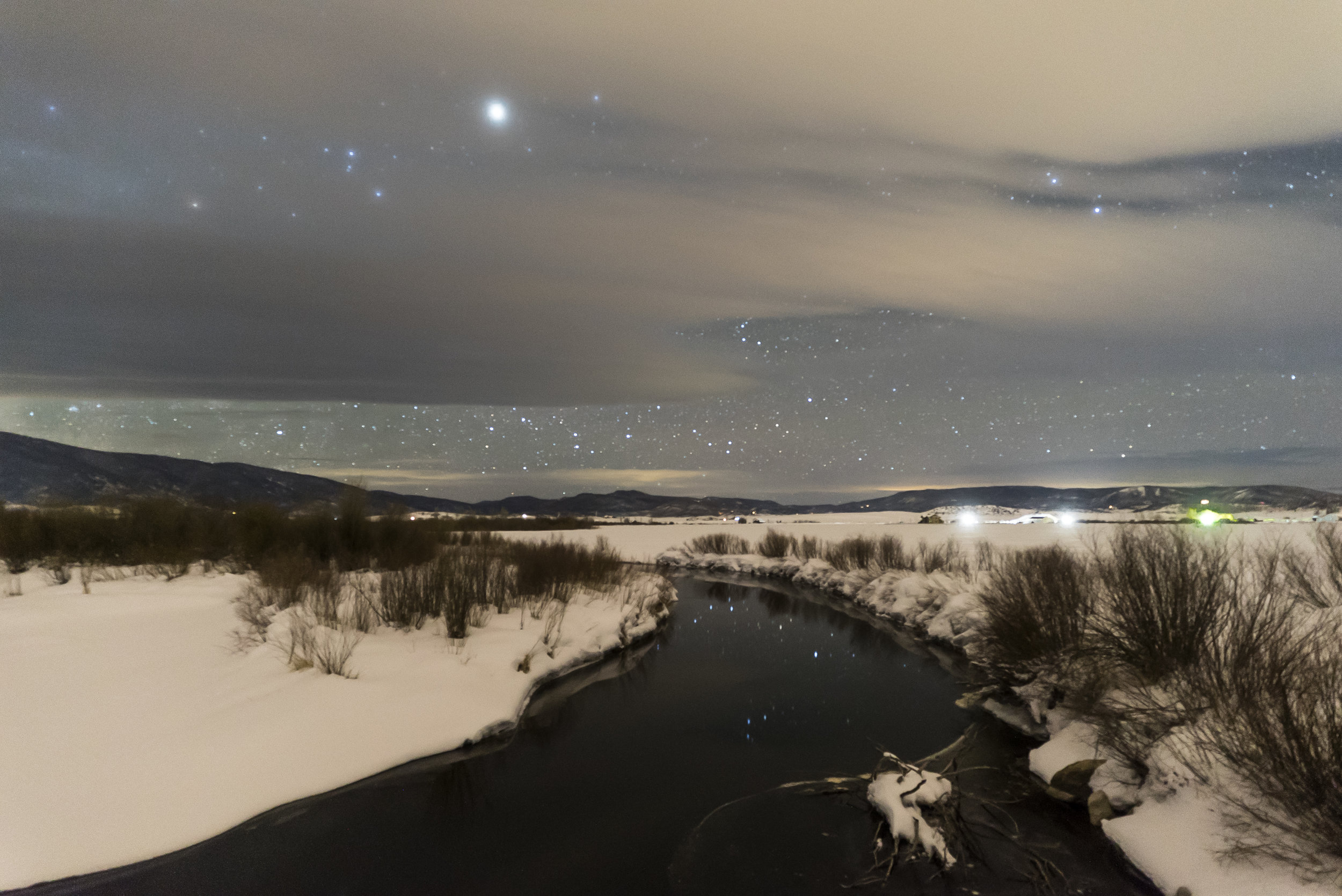
The first night of the Milky Way season found me in Steamboat Springs, but it also found me in the clouds. I wasn't able to capture the images I had hoped for, but the results are still beautiful.
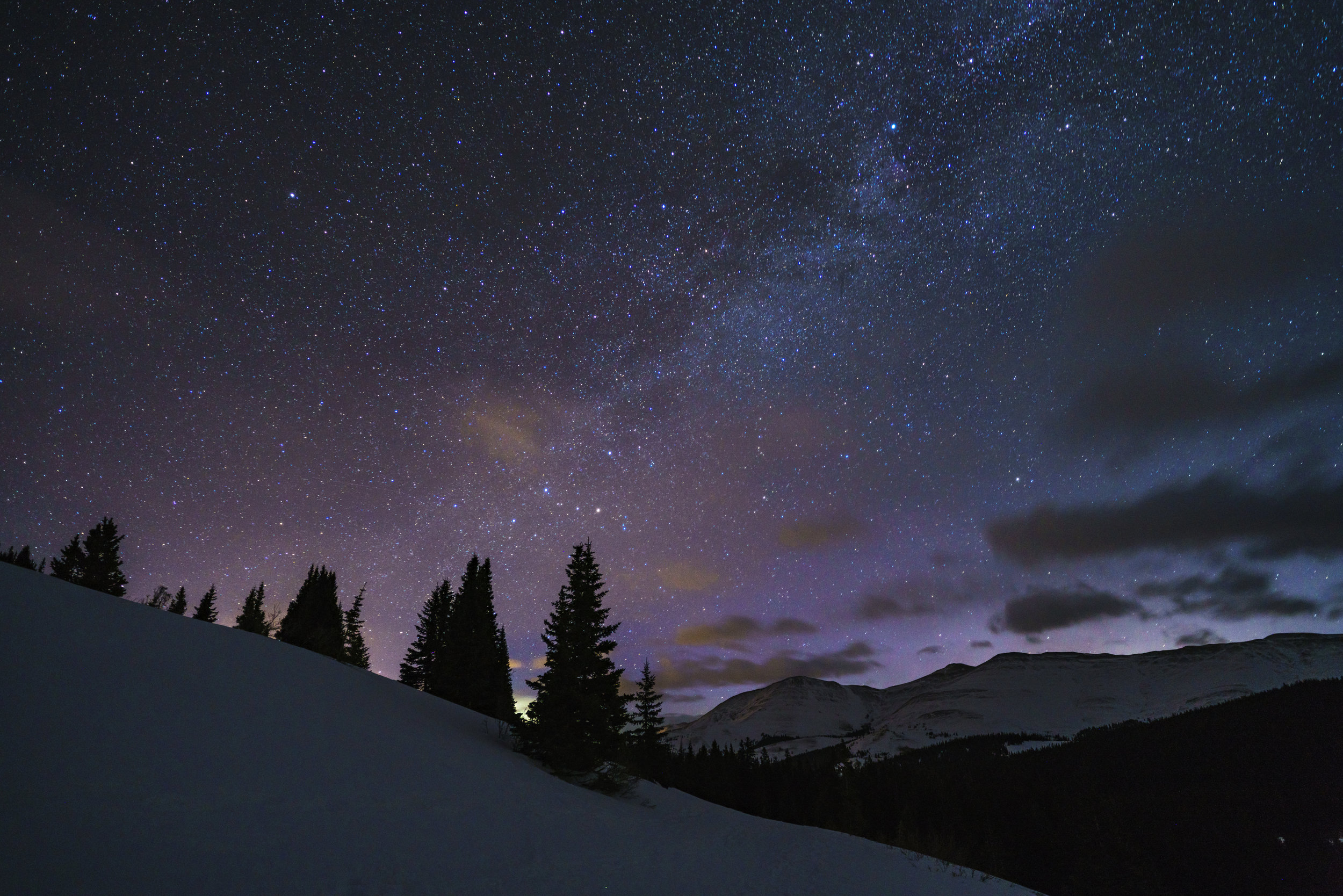
This is the far left panel of the panomram, looking to the north as Hoosier Pass drops over into Summit County from the crest of the Continental Divide
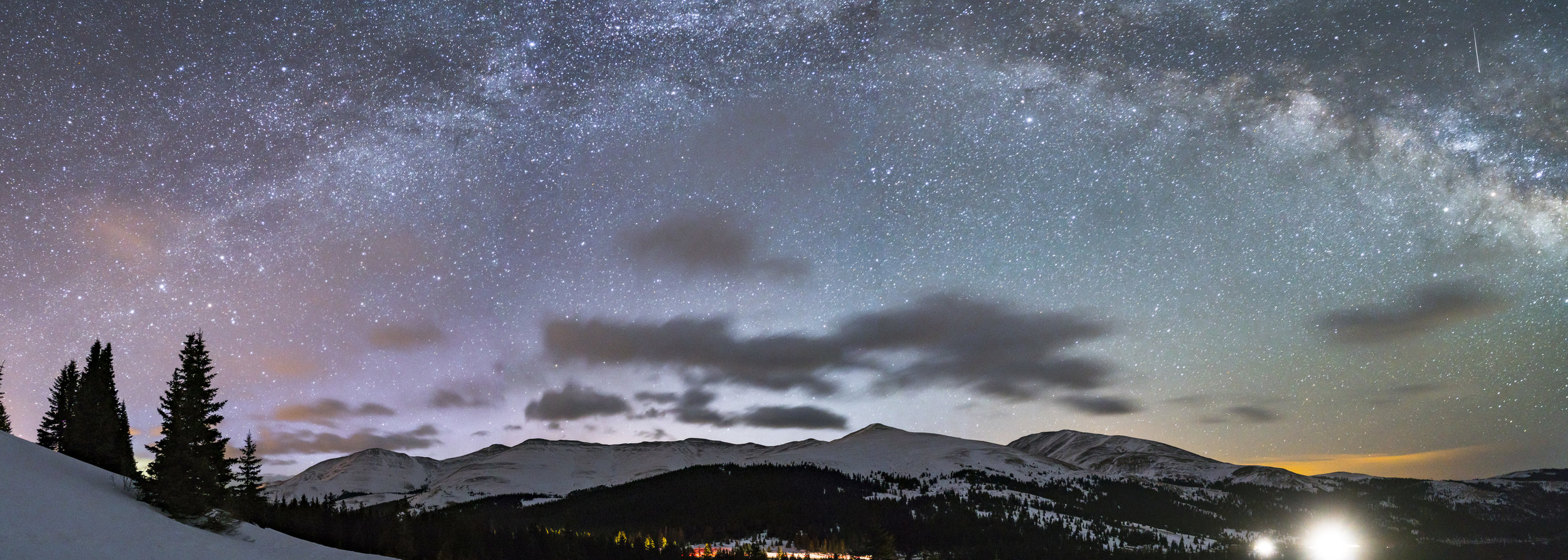
Milky Way season has begun in the Northern Hemisphere, and it seems to be a good thing so far!
This image is a set of 3 images stitched together on the morning of March 26th, 2018. I hiked out the forest road on the west side of Hoosier Pass to capture the Milky Way before the morning light drowned it out.
This is a smaller version of the original work. The full size is 7 images, and over 150 MB. Wondering what that will cost to print, large.
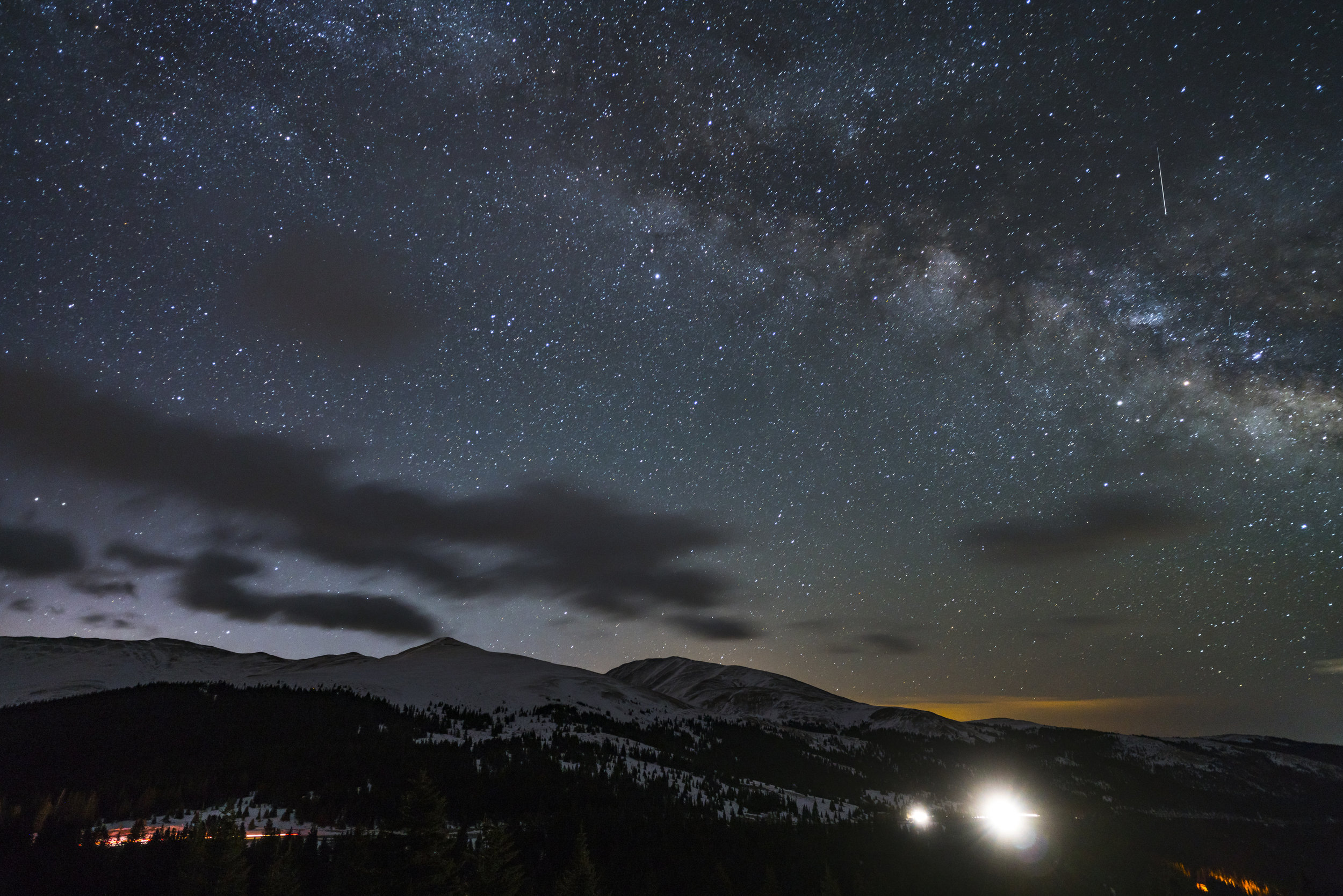
Milky Way season has begun in the Northern Hemisphere, and it seems to be a good thing so far!
This image is a set of 7 images stitched together on the morning of March 26th, 2018. I hiked out the forest road on the west side of Hoosier Pass to capture the Milky Way before the morning light drowned it out.
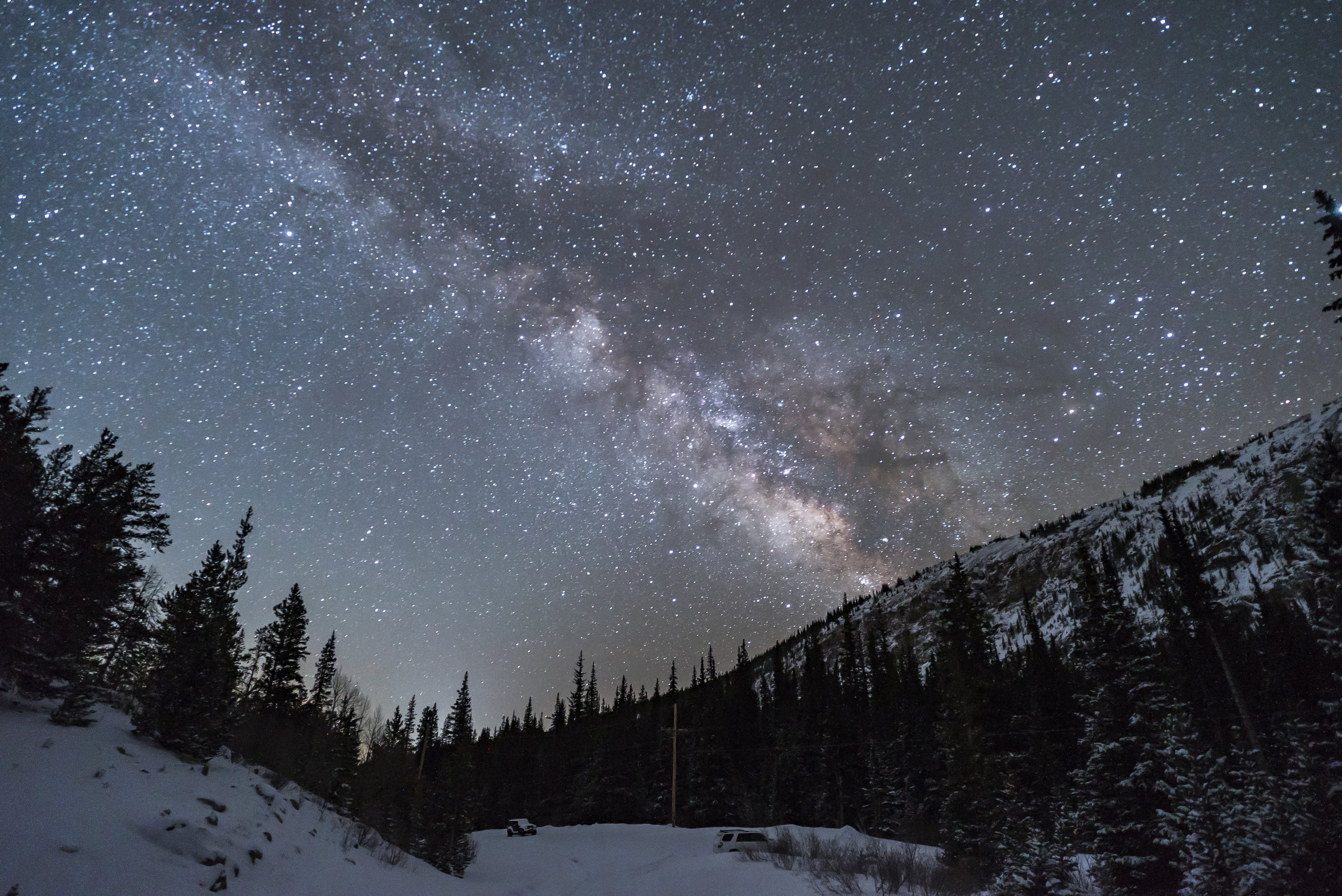
The Rocky Mountains are synonymous with "boom and bust," unfortunately so. The Paris Mill is just one of the many relics that dot the landscape. The rich loads of Buckskin Gulch fueled the economy and a like so many other mining regions, the population receded as quickly as it grew.
This detail of the Milky Way taken near the ghost town of Buckskin Joe. The Paris Mine was just one of many to thrive and crash, along with with the so many lives. The largest sample of the Colorado's gemstone, rhodochrosite, was found in Buckskin Gulch. Remnants of the Sweet Home Mine, Hungry Five Mine, Paris Mine and many more still dot the mountain's walls.
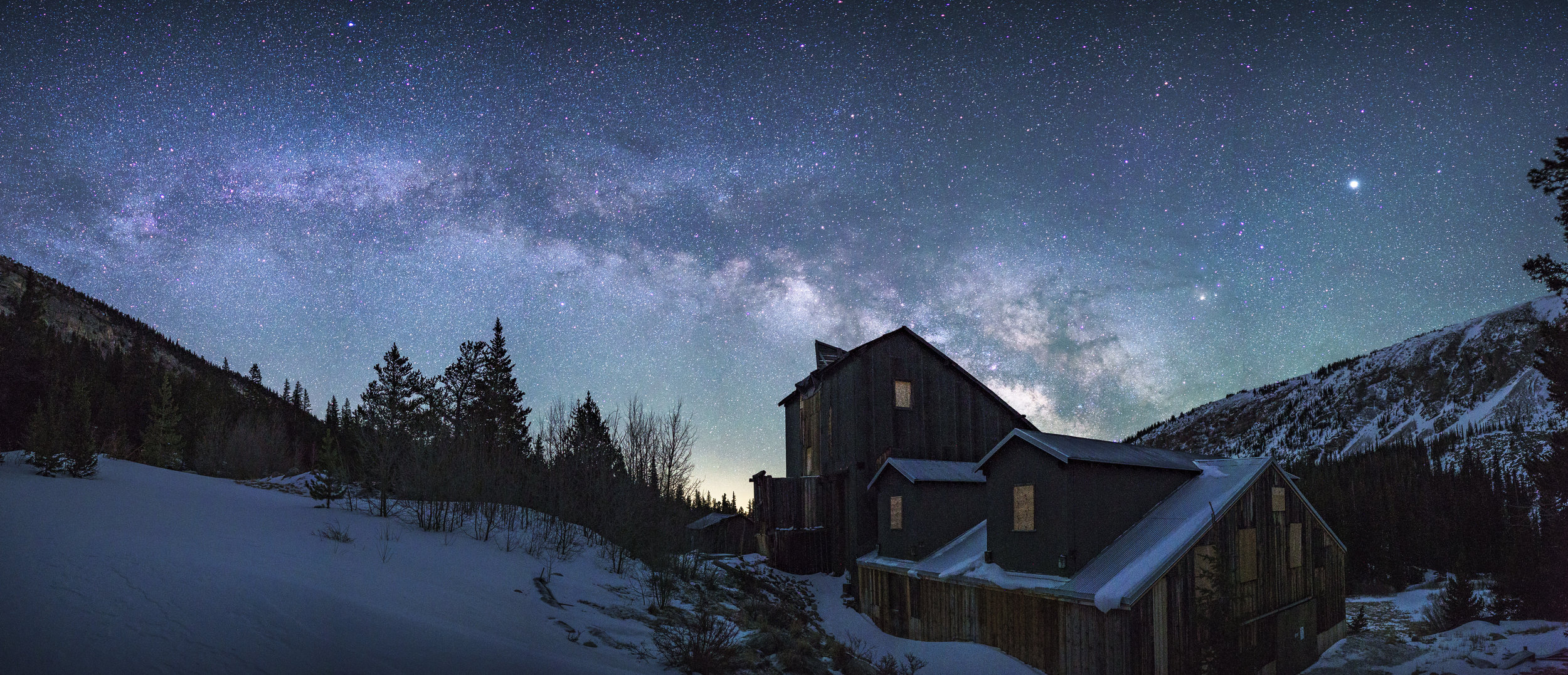
The Rocky Mountains are synonymous with "boom and bust," unfortunately so. The Paris Mill is just one of the many relics that dot the landscape. The rich loads of Buckskin Gulch fueled the economy and a like so many other mining regions, the population receded as quickly as it grew.
The relic of the Paris Mill is in a preservation trust, and will hopefully stand for many more to see. But please, respect the signs and stay out of the structure.

The Rocky Mountains are synonymous with "boom and bust," unfortunately so. The Paris Mill is just one of the many relics that dot the landscape. The rich loads of Buckskin Gulch fueled the economy and a like so many other mining regions, the population receded as quickly as it grew.
This is a image was created by stacking 10, long exposure images together to create one, highly detailed images and is the smaller version of the original work. The full size is over 150 MB.
The relic of the Paris Mill is in a preservation trust, and will hopefully stand for many more to see. But please, respect the signs and stay out of the structure.
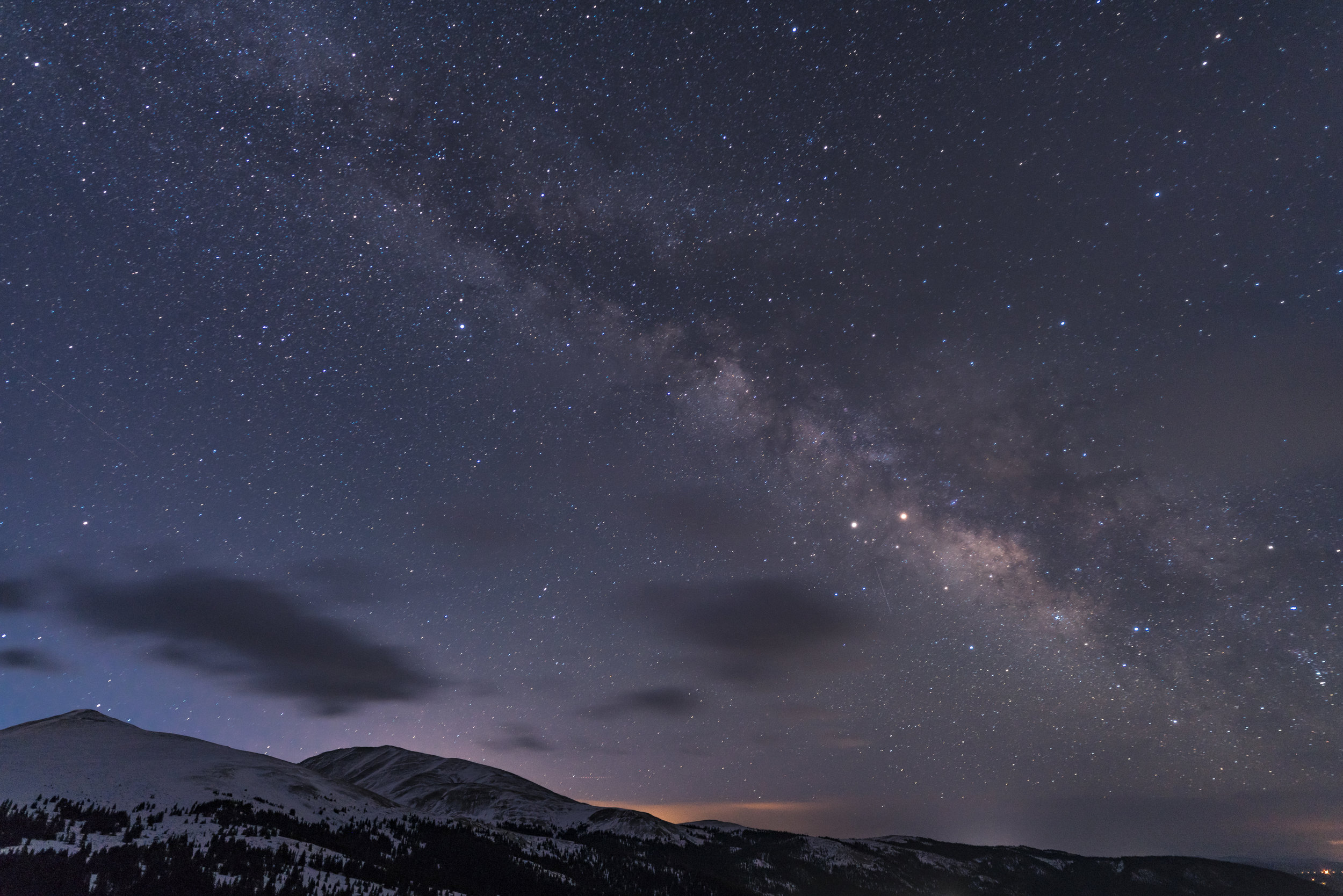
Rocky Mountain National Park, Loveland Pass, and Maroon Bells get an incredible amount of publicity, and its understandable why. But honestly, any place away from the excessive city light can create a gorgeous Milky Way setting, and adding in some snow, and trees, for me makes an even more compelling site.
This is a single image that is part of the larger panorama, taken on the morning of March 26th, 2018. I hiked out the forest road on the west side of Hoosier Pass to capture the Milky Way before the morning light drowned it out.
This is a smaller version of the original work. The full size is 7 images, and over 150 MB. Wondering what that will cost to print, large. I created two different sets of images in fading night, simply because I could.

Rocky Mountain National Park, Loveland Pass, and Maroon Bells get an incredible amount of publicity, and its understandable why. But honestly, any place away from the excessive city light can create a gorgeous Milky Way setting, and adding in some snow, and trees, for me makes an even more compelling site.
This panorama is a set of 4 images stitched together on the morning of March 26th, 2018. I hiked out the forest road on the west side of Hoosier Pass to capture the Milky Way before the morning light drowned it out.
This is a smaller version of the original work. The full size is 7 images, and over 150 MB. Wondering what that will cost to print, large. I created two different sets of images in fading night, simply because I could.
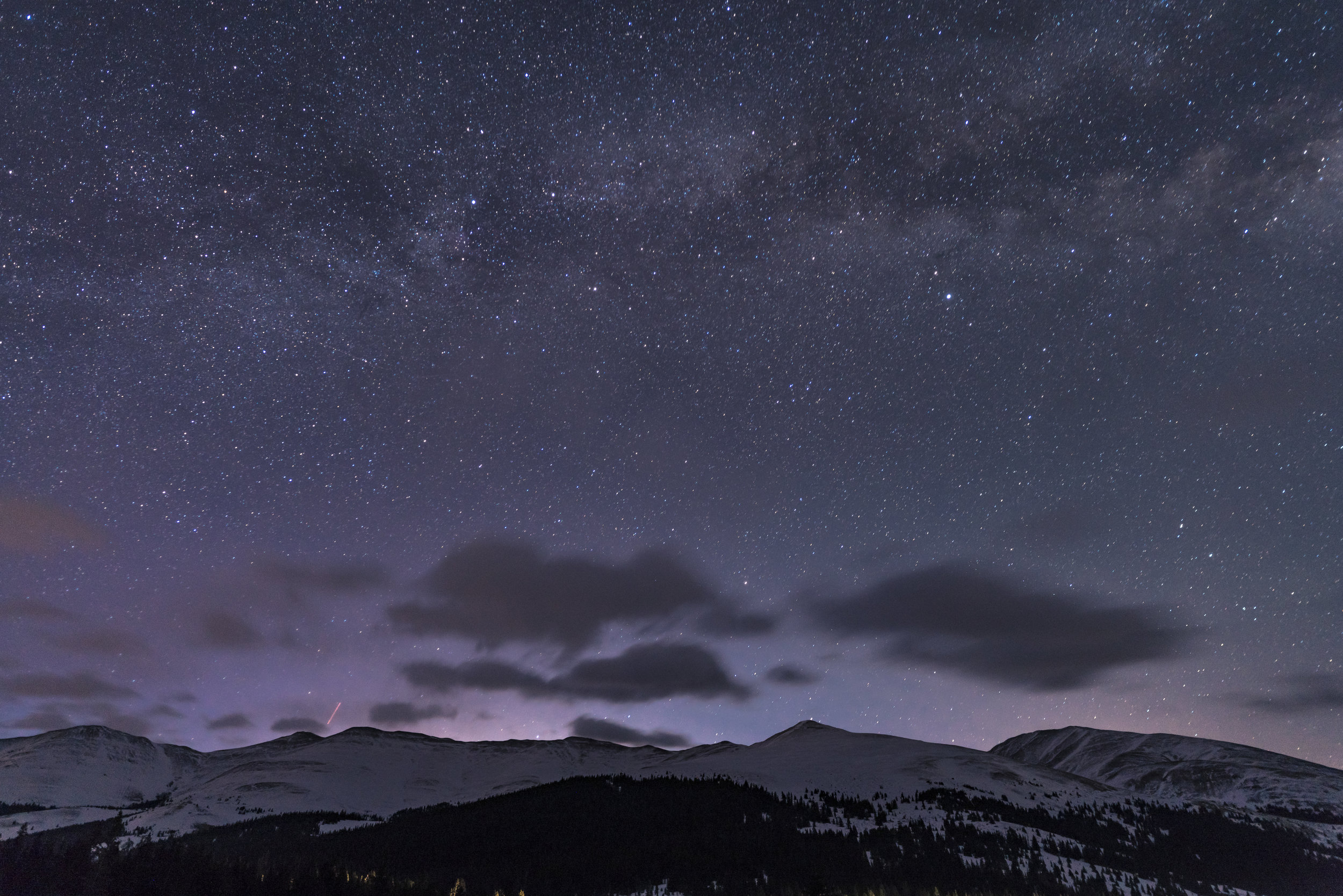
Rocky Mountain National Park, Loveland Pass, and Maroon Bells get an incredible amount of publicity, and its understandable why. But honestly, any place away from the excessive city light can create a gorgeous Milky Way setting, and adding in some snow, and trees, for me makes an even more compelling site.
This is a single image that is part of the larger panorama, taken on the morning of March 26th, 2018. I hiked out the forest road on the west side of Hoosier Pass to capture the Milky Way before the morning light drowned it out.
This is a smaller version of the original work. The full size is 7 images, and over 150 MB. Wondering what that will cost to print, large. I created two different sets of images in fading night, simply because I could.

I have a hard time NOT taking pictures when I get outside. But know that all of this is fleeing and not wanting to give up on the perfect conditions and light, I do often over shoot. This panorama is probably a result of "just one more shot," more than being a really spectacular one.
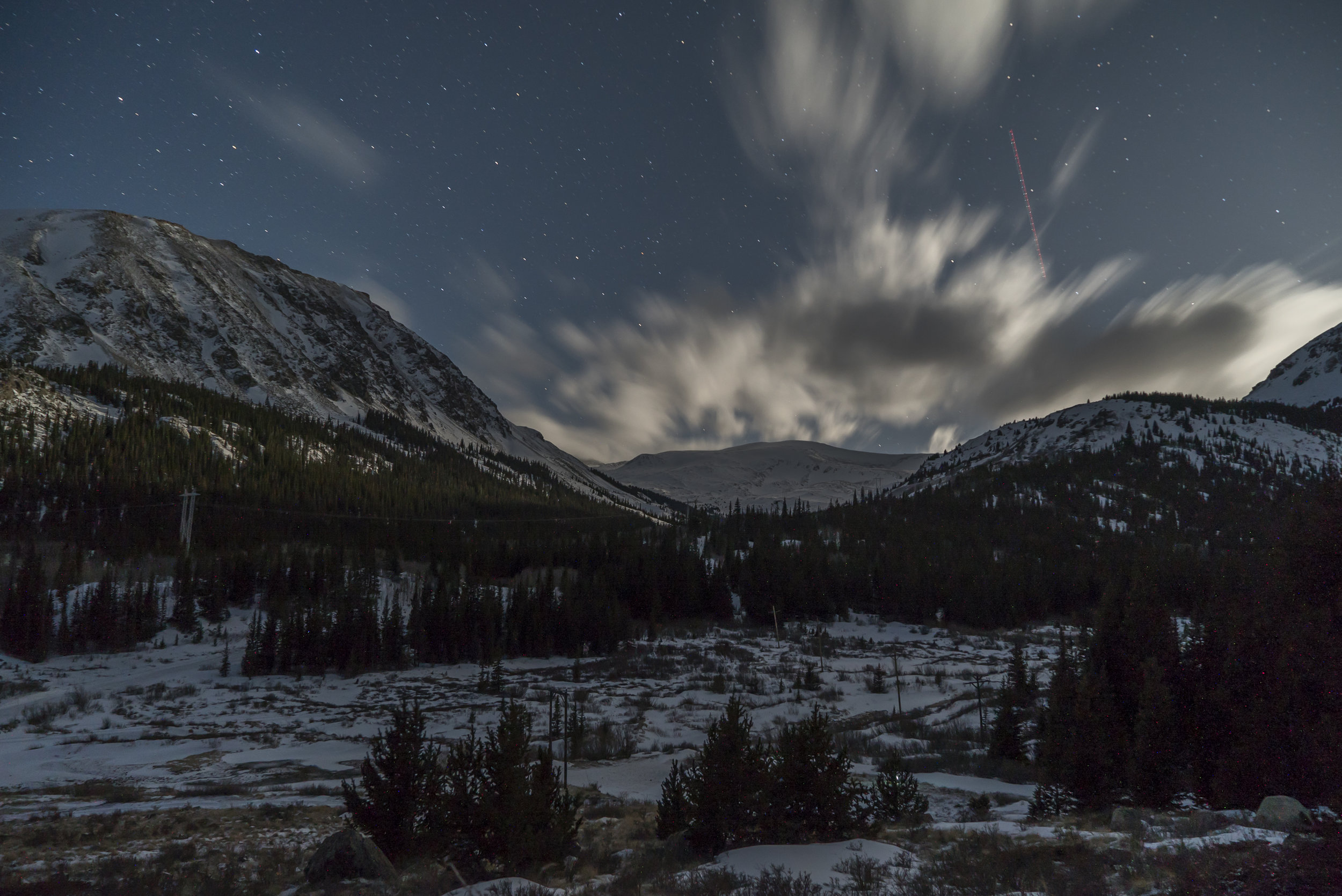
Mt. Evans is another favorite subject. At the end of Mosquito Gulch, this cirque stands with the history of derelict mining mills at its feet. Snow and moonlight amplify its beauty.
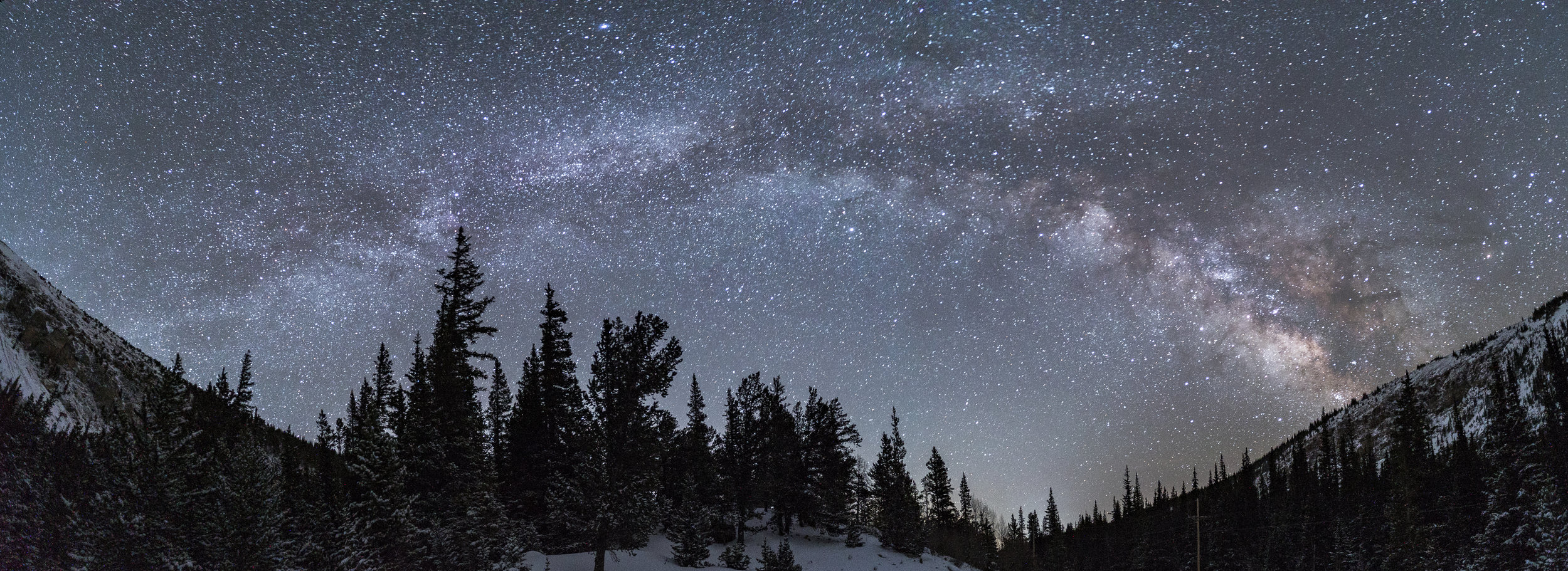
March, 2018

The Milky Way can make nearly any roadside attraction more beautiful. It did this on Hoosier Pass, rising above the Continental Divide.
Made from 9 light frames (captured with a SONY camera) by Starry Landscape Stacker 1.5.1.

I've struggled with the light on this one. I wasn't careful when I set my camera up and one of the settings was in auto mode. This mode kept shifting through the imaging sequence, so nothing was consistent.
Lesson learned.

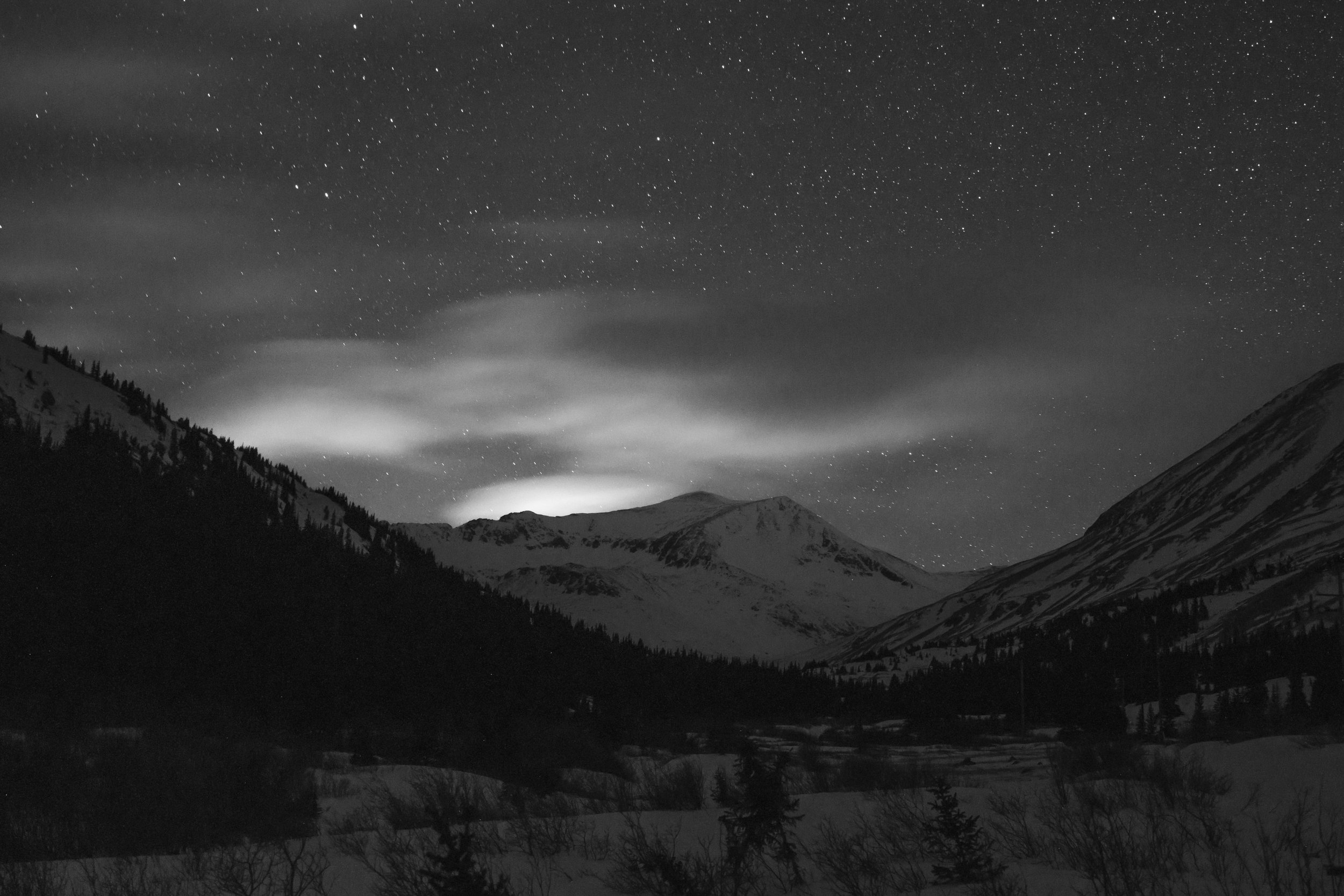
The stars do actually come out, even if it's in black and white. The light in the clouds is from Leadville, just on the other side of the mountain.
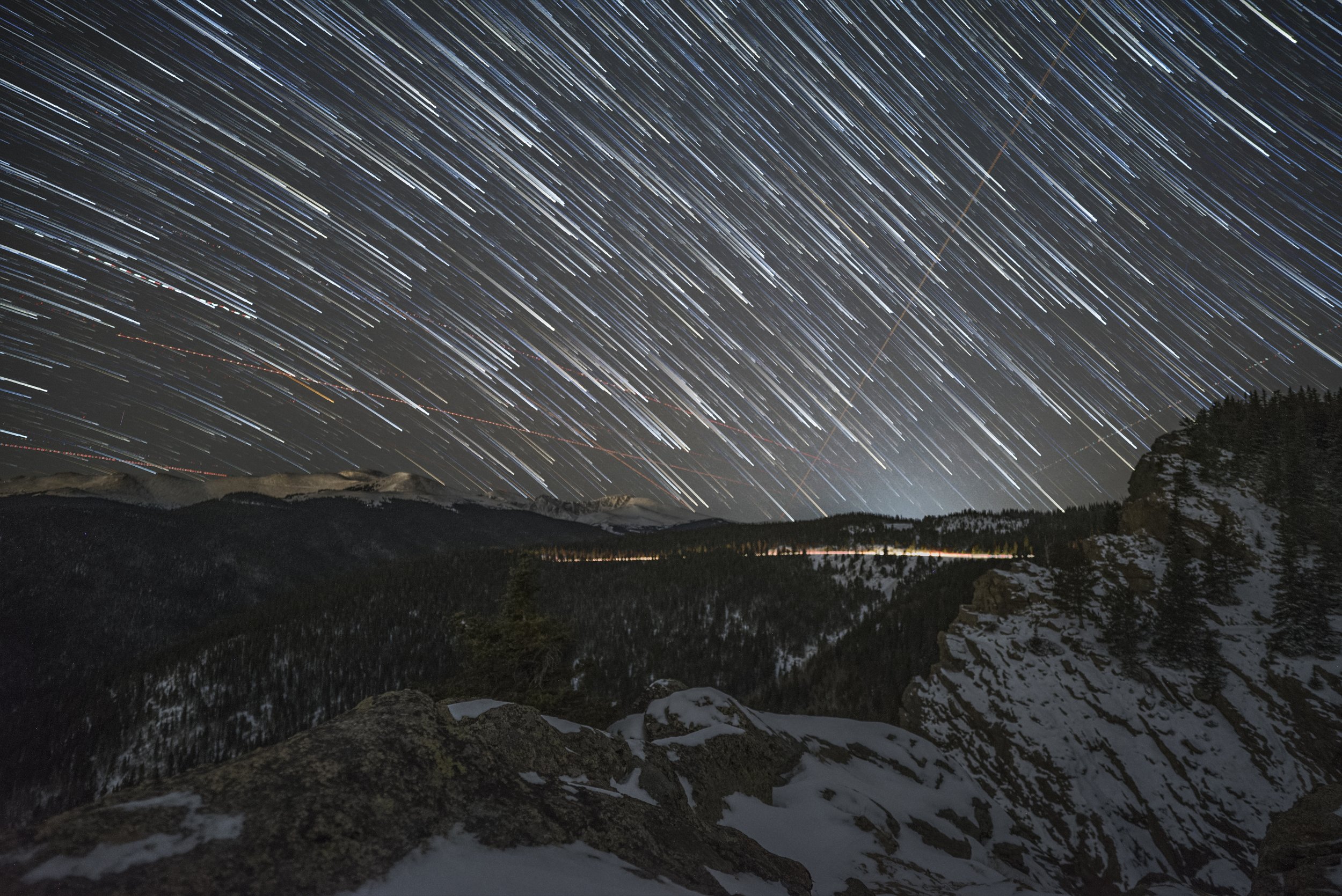
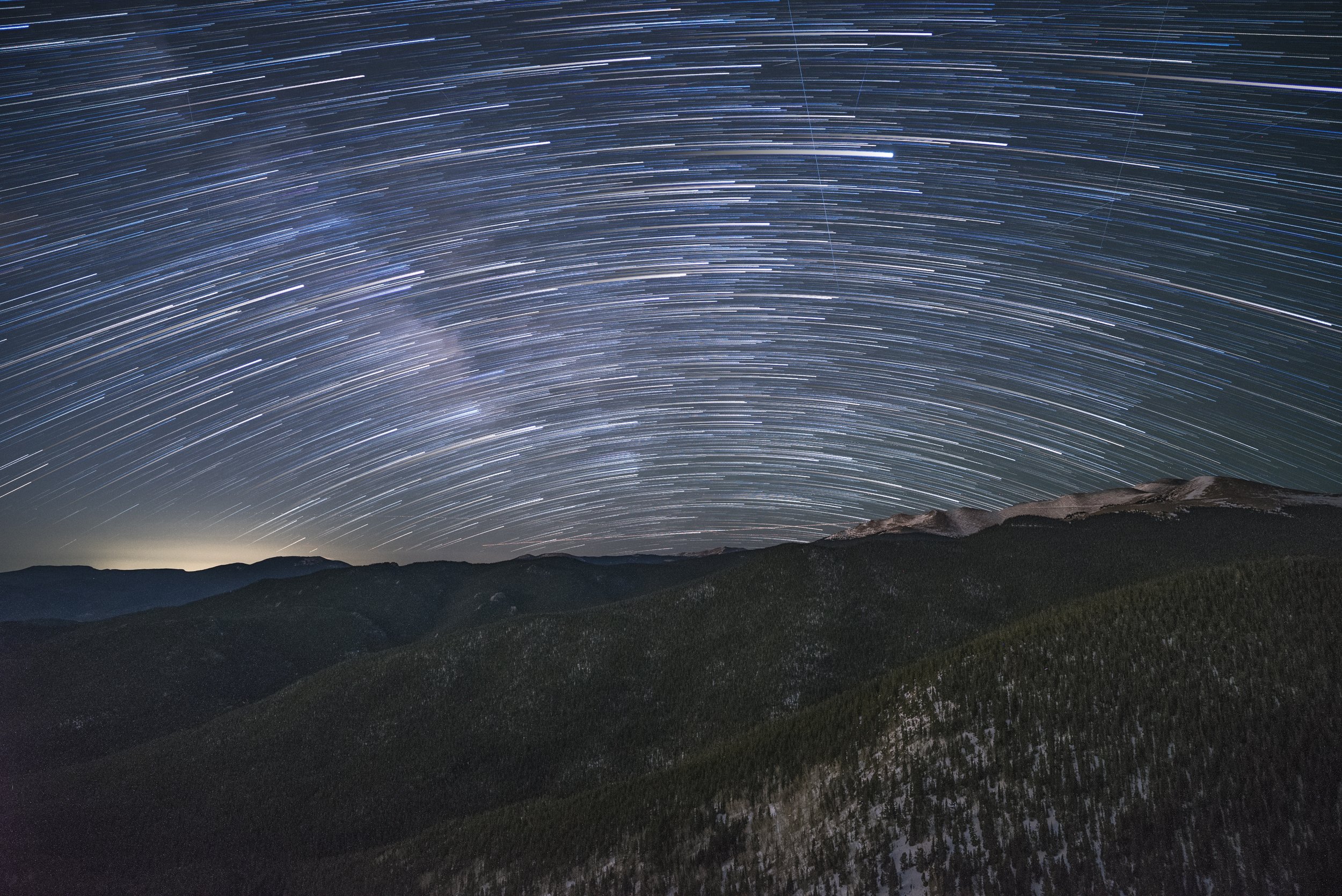
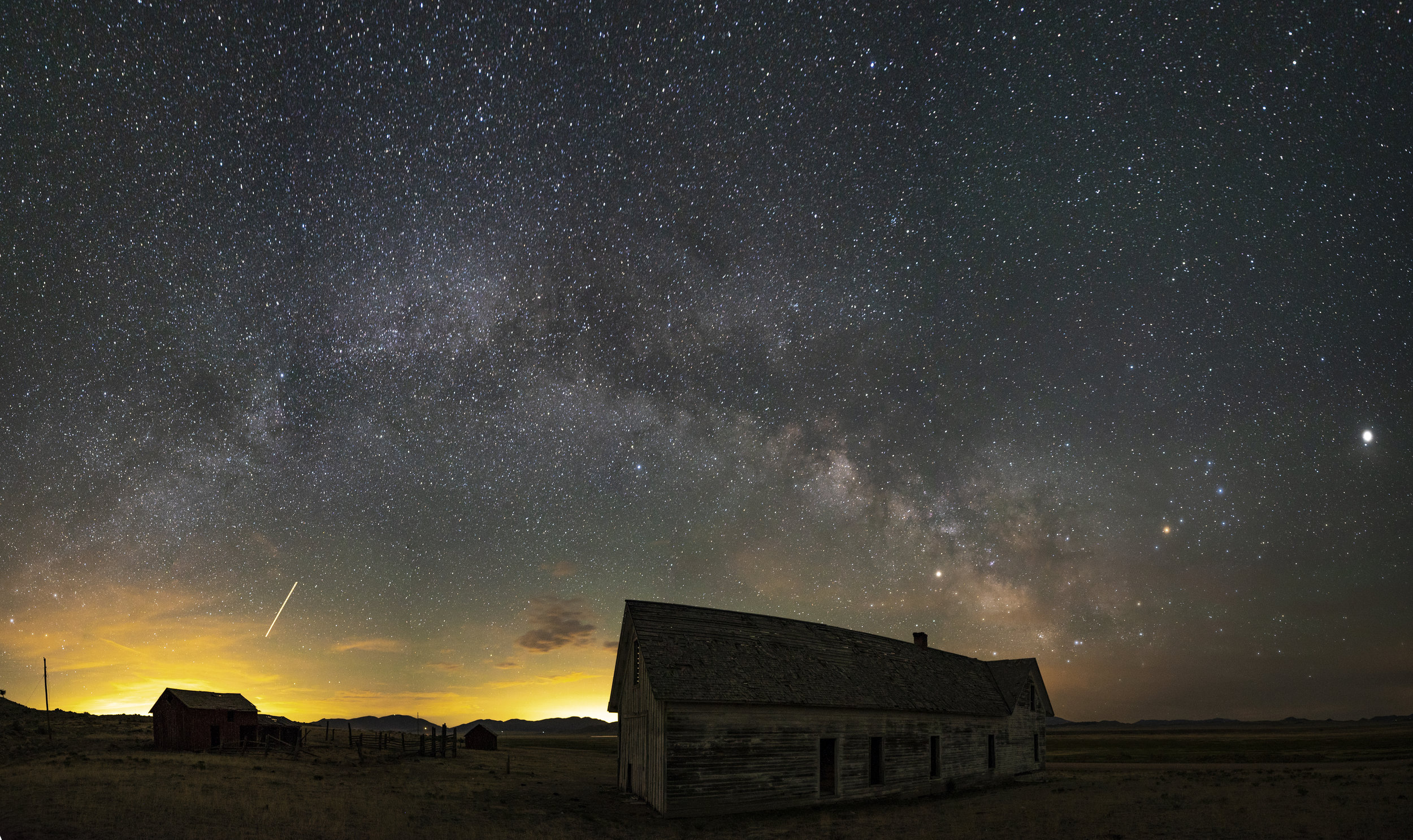
A common subject for the Milky Way, this stage stop near the town of Hartsel plays the reminder to a different time, but one still firmly planted in our present existence.
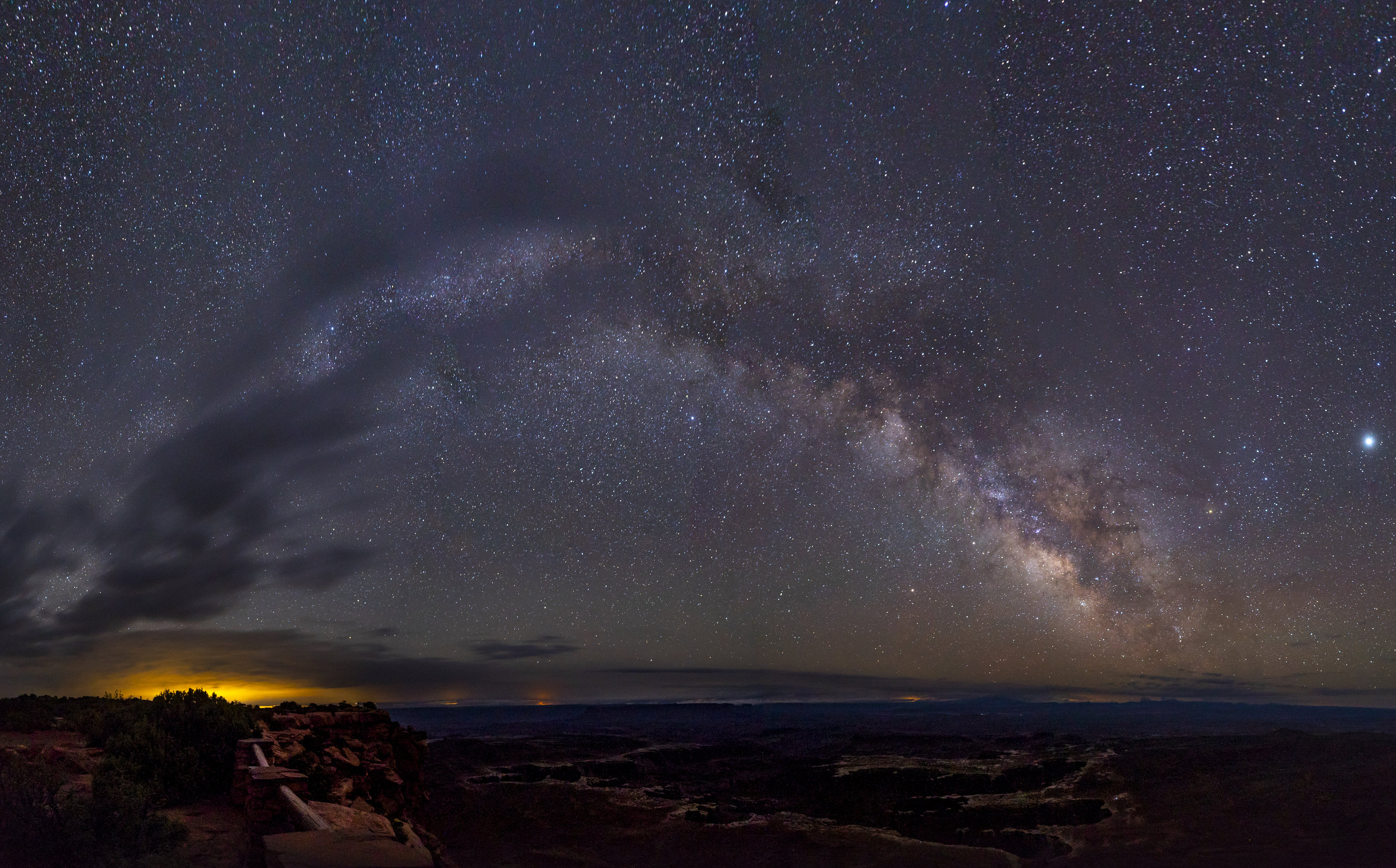
Milky Way season is fairly long, from March to October, but each month because of the moon there about 10 really good nights to shoot. Add problematic weather into the mix and you may have to skip a month. This almost happened for April, but a harried trip to Canyonlands National Park brought me some success for April!

Clouds almost got the best that night. But, in fact, they really added to Milky Way rise.

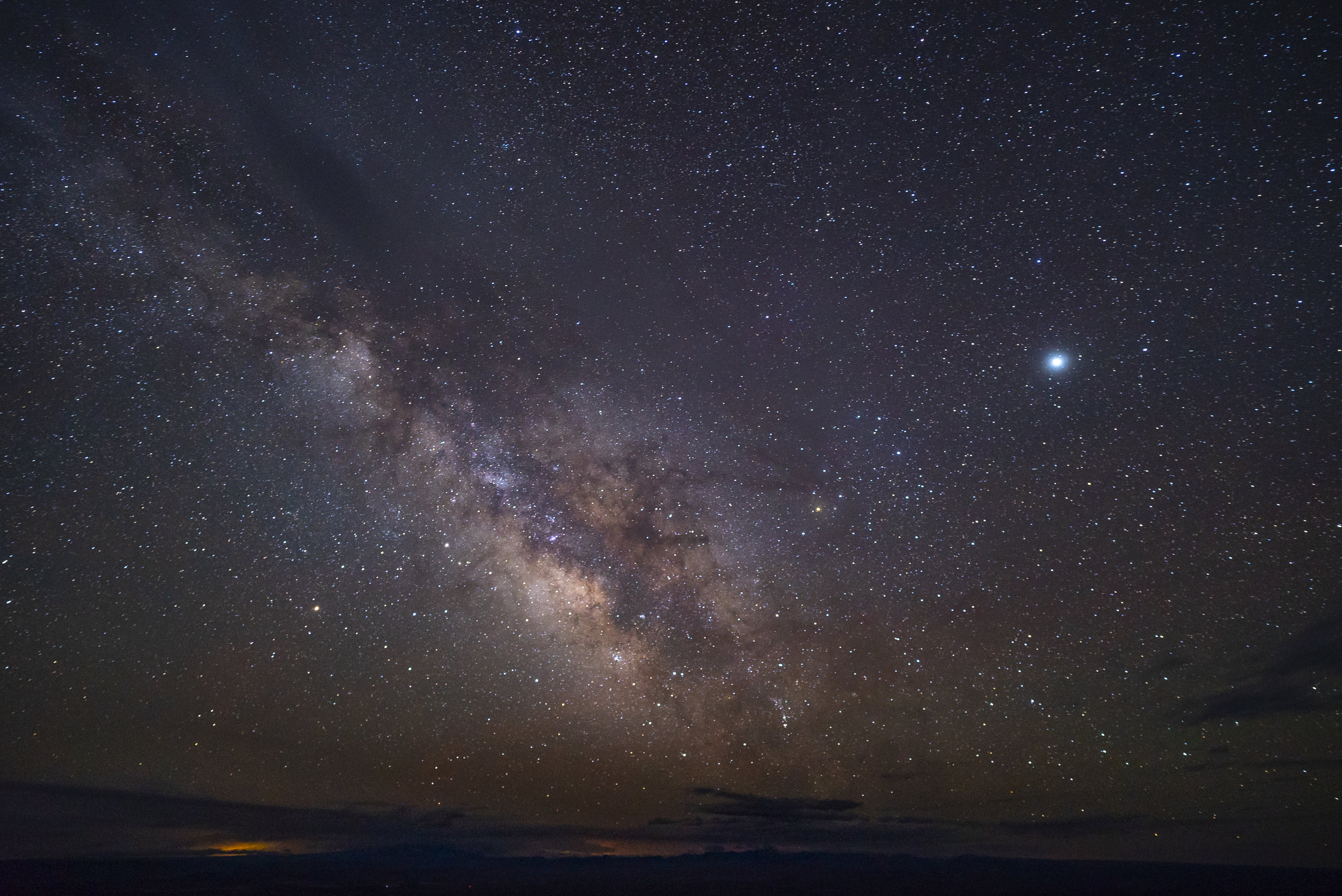
Milky Way season is fairly long, from March to October, but each month because of the moon there about 10 really good nights to shoot. Add problematic weather into the mix and you may have to skip a month. This almost happened for April, but a harried trip to Canyonlands National Park brought me some success for April!
This is one of eight images used to construct the panorama.
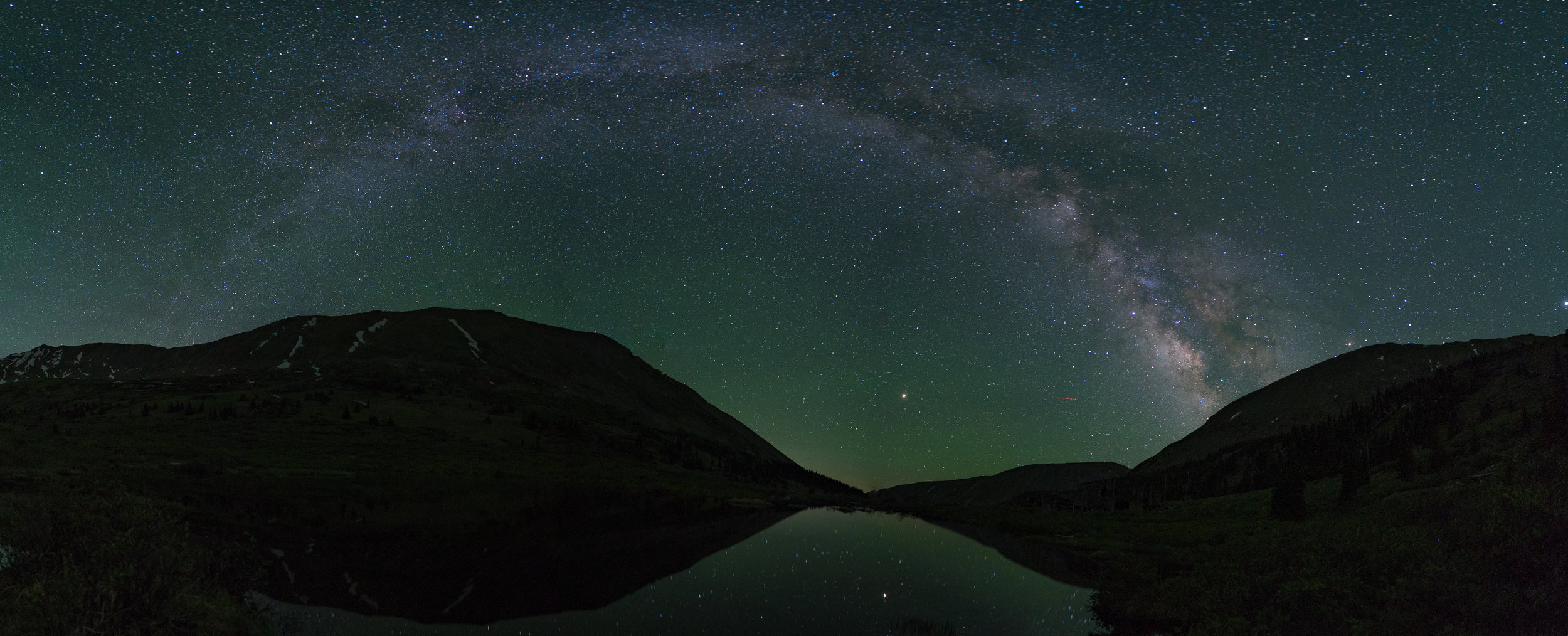
The pond was a happy accident. There is a mine near here that I have been composing, but the run-off waters kept me from getting there. Happily, I shoot the reflections off of the water. Lightning flashes from the Front Range storms lit the sky as unidentified animals bedded down nearby. A late night adventure that I won’t soon forget.
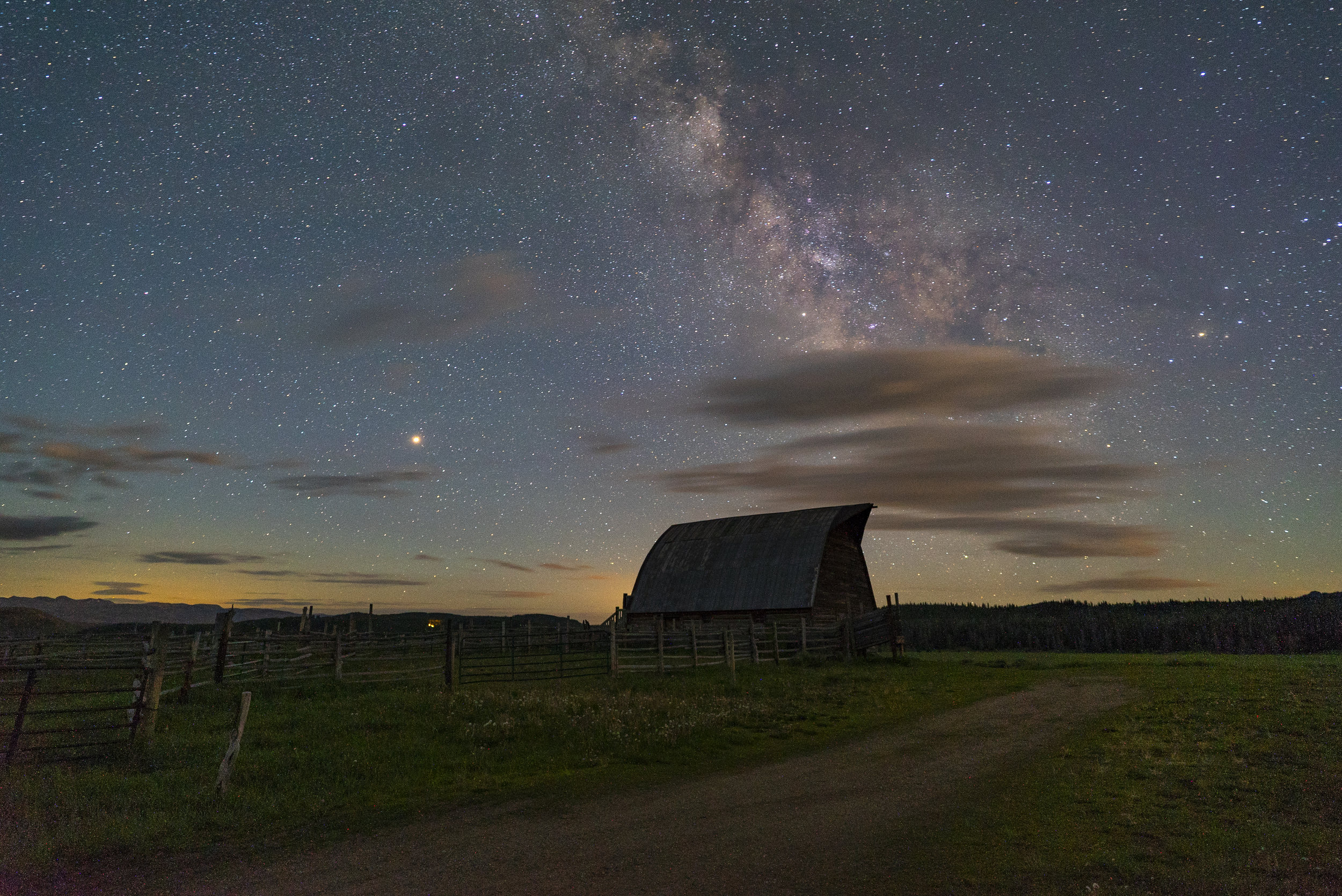
This set of compositions has been on my mind for a while. Historic structures, truly dark skies, and a rising Milky Way just add up. This and the accompanying panorama were shot at 18mm, with ISO 3200 | F2.8 | 25 secs. settings. Using the Sony a7s, and a Ziess Batis 18mm, these settings continue to produce stunning results.
The composition centers on the Fetcher Brother’s barn, which overlooks the southern shore of the lake.
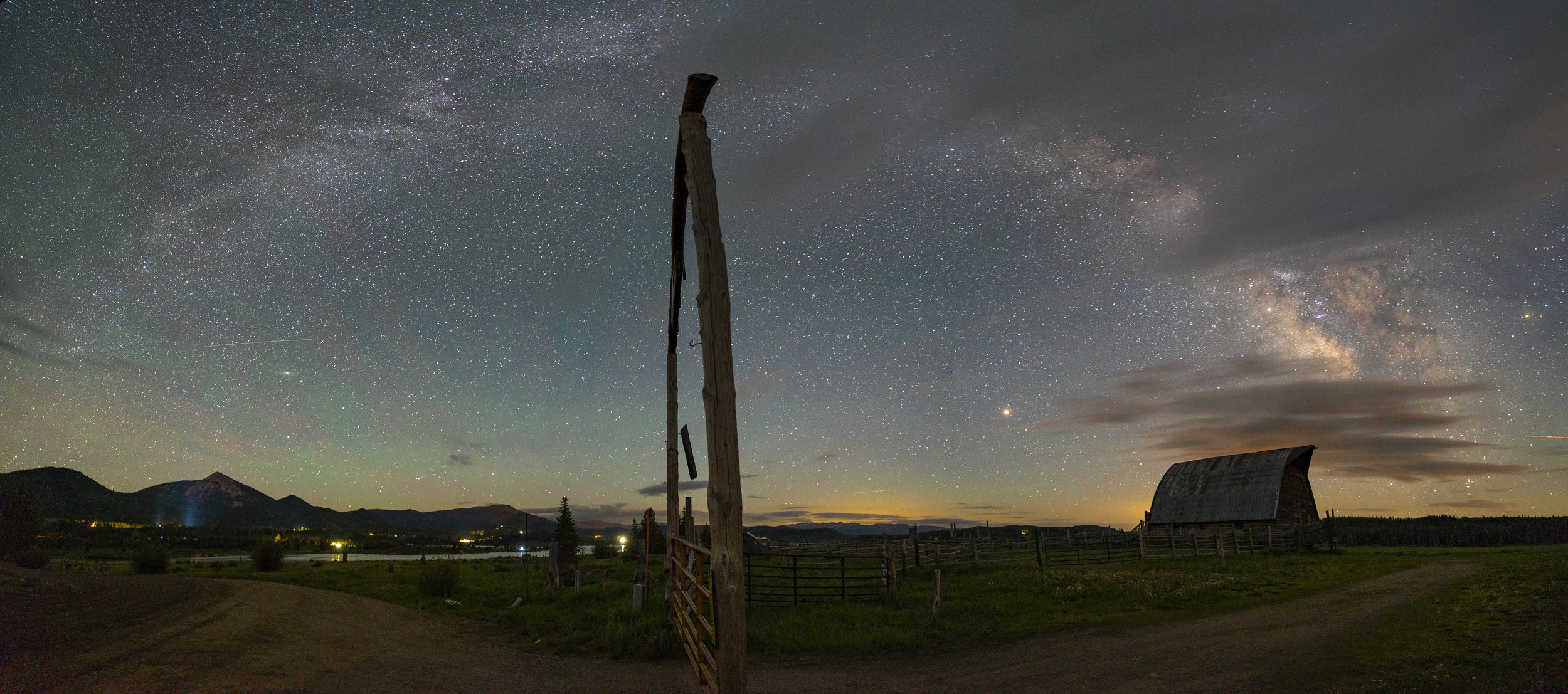
This set of compositions has been on my mind for a while. Historic structures, truly dark skies, and a rising Milky Way just add up. This and the accompanying panorama were shot at 18mm, with ISO 3200 | F2.8 | 25 secs. settings. Using the Sony a7s, and a Ziess Batis 18mm, these settings continue to produce stunning results. This image is a composite of six images stitched together in Lightroom.
The composition centers on the Fetcher Brother’s barn, which overlooks the southern shore of the lake.
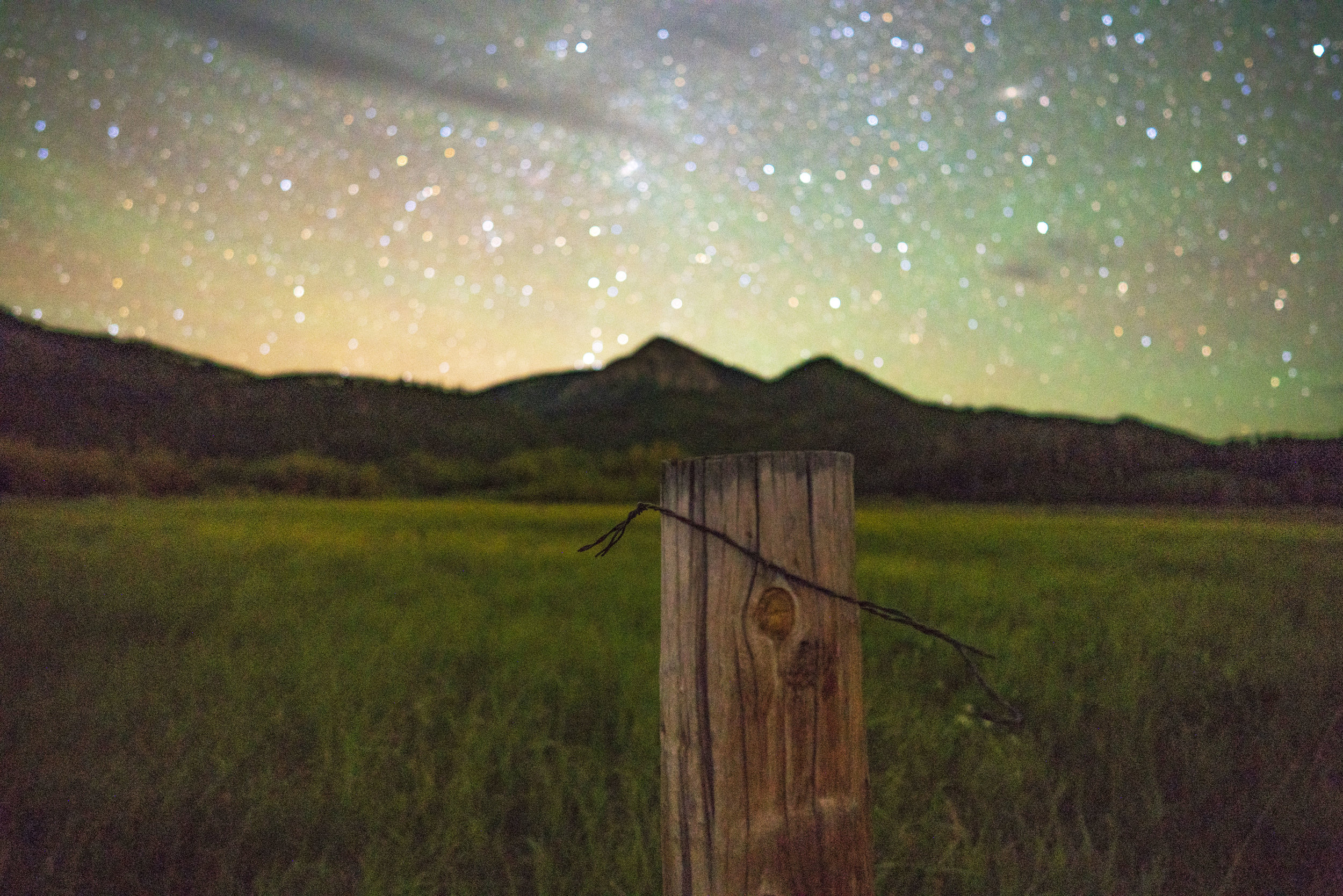
This set of compositions has been on my mind for a while. Historic structures, truly dark skies, and a rising Milky Way just add up. This was shot at 25mm, with ISO 3200 | F2 | 15 secs. settings. Using the Sony a7rii, and a Ziess Batis 25mm, these settings continue to produce stunning results.
This post is another favorite subject. I first shoot it during the winter, when is was buried in snow with on the top 18 inches exposed. Looking backing, that is still a favorite image, and capturing it during the summer, under the stars proves the value of going back to composition again and again can be just has gratifying.

Finding unique subjects to place in Milky Way images possess some interesting challenges. The biggest challenge usually involves the lighting of subject; mainly from an esthetic standpoint you have to ask yourself, do you or do you not want the subject to be lit? Since photography is really about finding the light, shooting in the absence of it means your creativity has to be pushed just a bit further.
Fortunately modern cameras to such an amazing job of “seeing in the dark,” that it’s rarely the case that you really need to worry about lighting. In some instances, banks and panels of lights are brought in to illuminate the subject, while at other times just the silhouette is emphasized so no additional lighting is required. And, because this is how life goes, sometimes you are able to take advantage of ambient light and atmospheric conditions which effectively light up your subject.
I’d been focusing on the Milky Way this particular night, but since the clouds came in and I couldn’t get the dark sky and compositions I wanted, it seemed like a good opportunity to try out a technique I’d been seeing lately on social media; blur the starry sky out in the background to create a dreamy, more playful composition. This bunch of wild sunflowers seemed up to the task for posing, so I gladly obliged them with a few quick images.
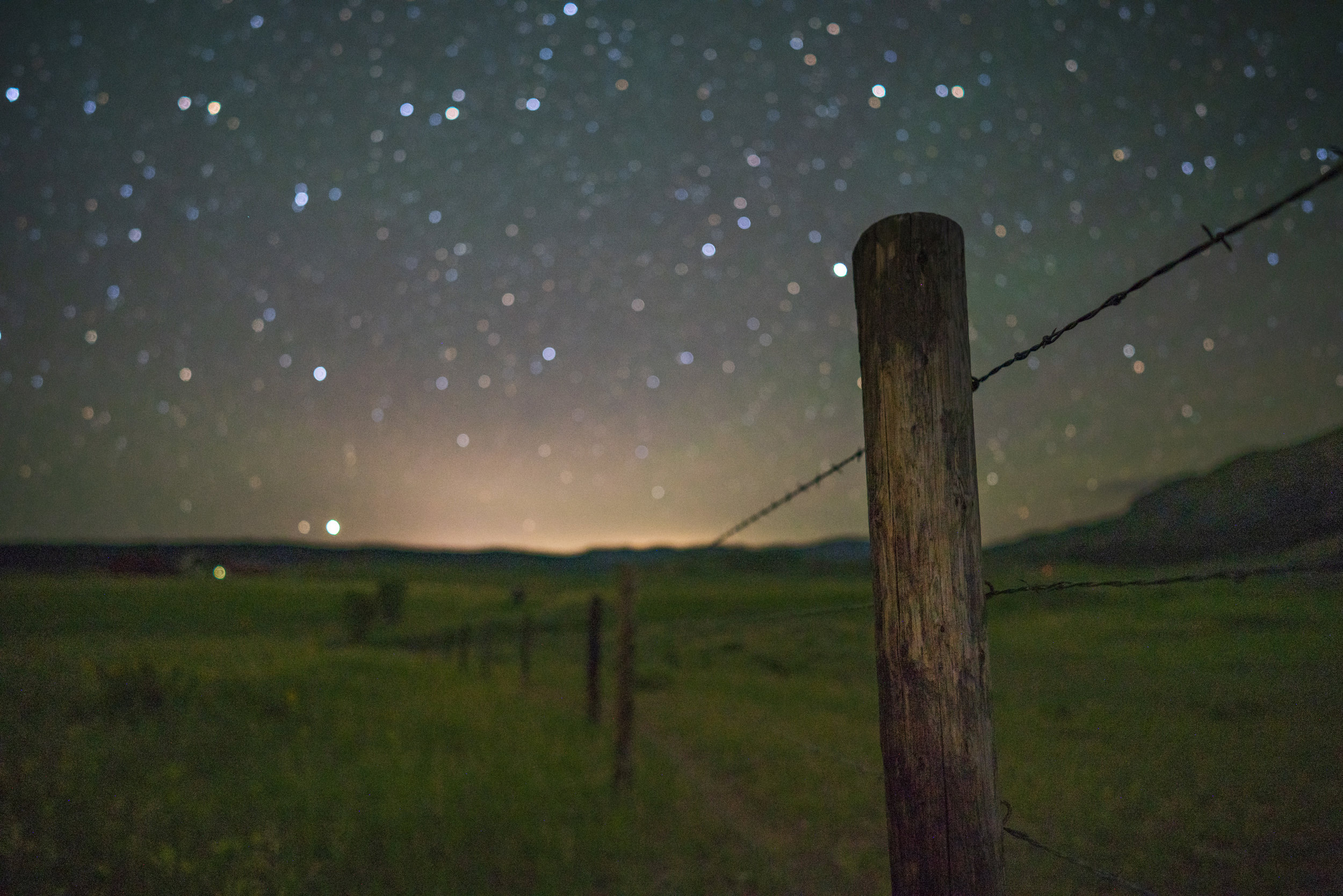
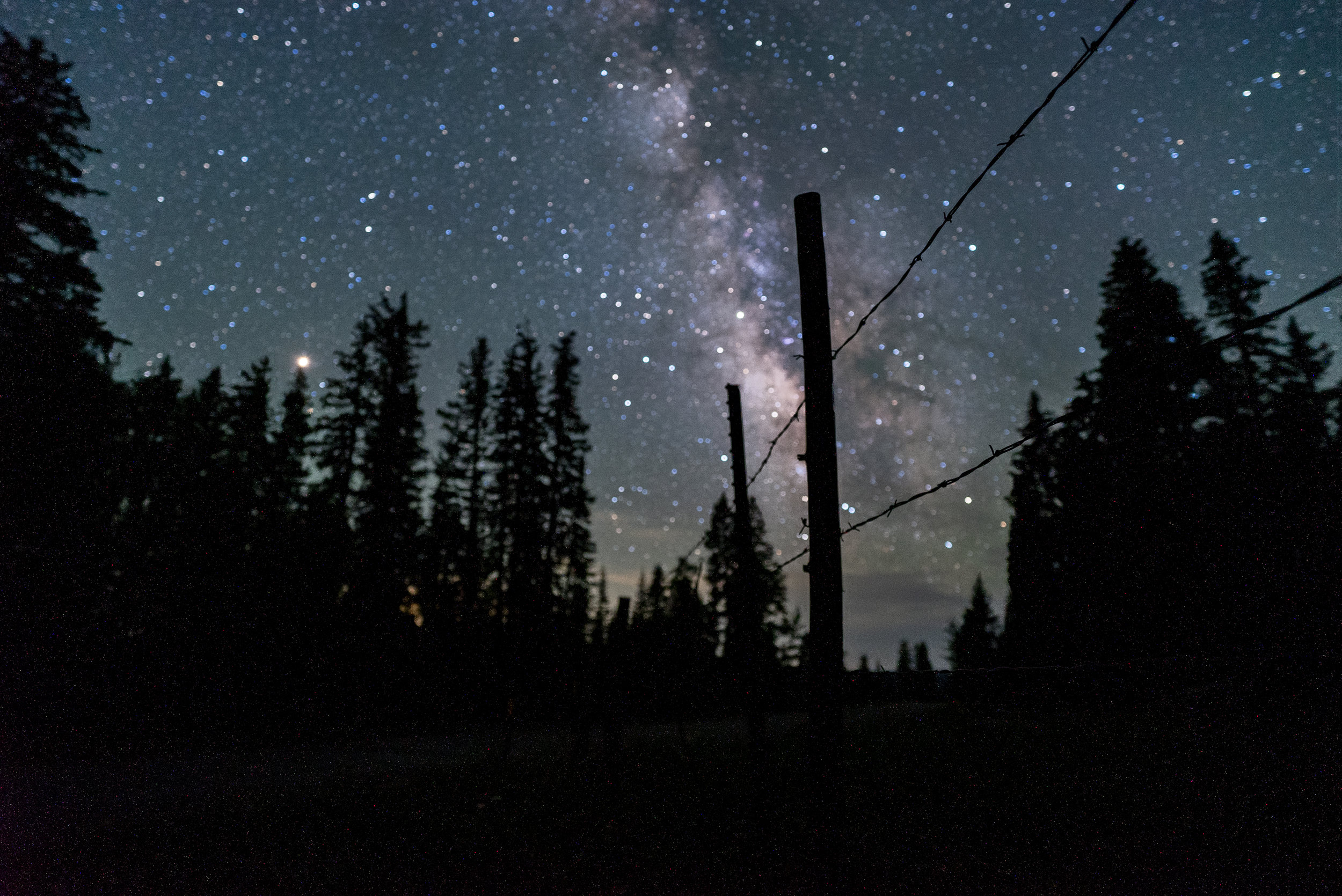
The solitude of the night sky has me captivated this summer.
The lonely and broken fence line on the Grand Mesa in Western Colorado seems a simple reminder of the futility of trying to reign the world in.


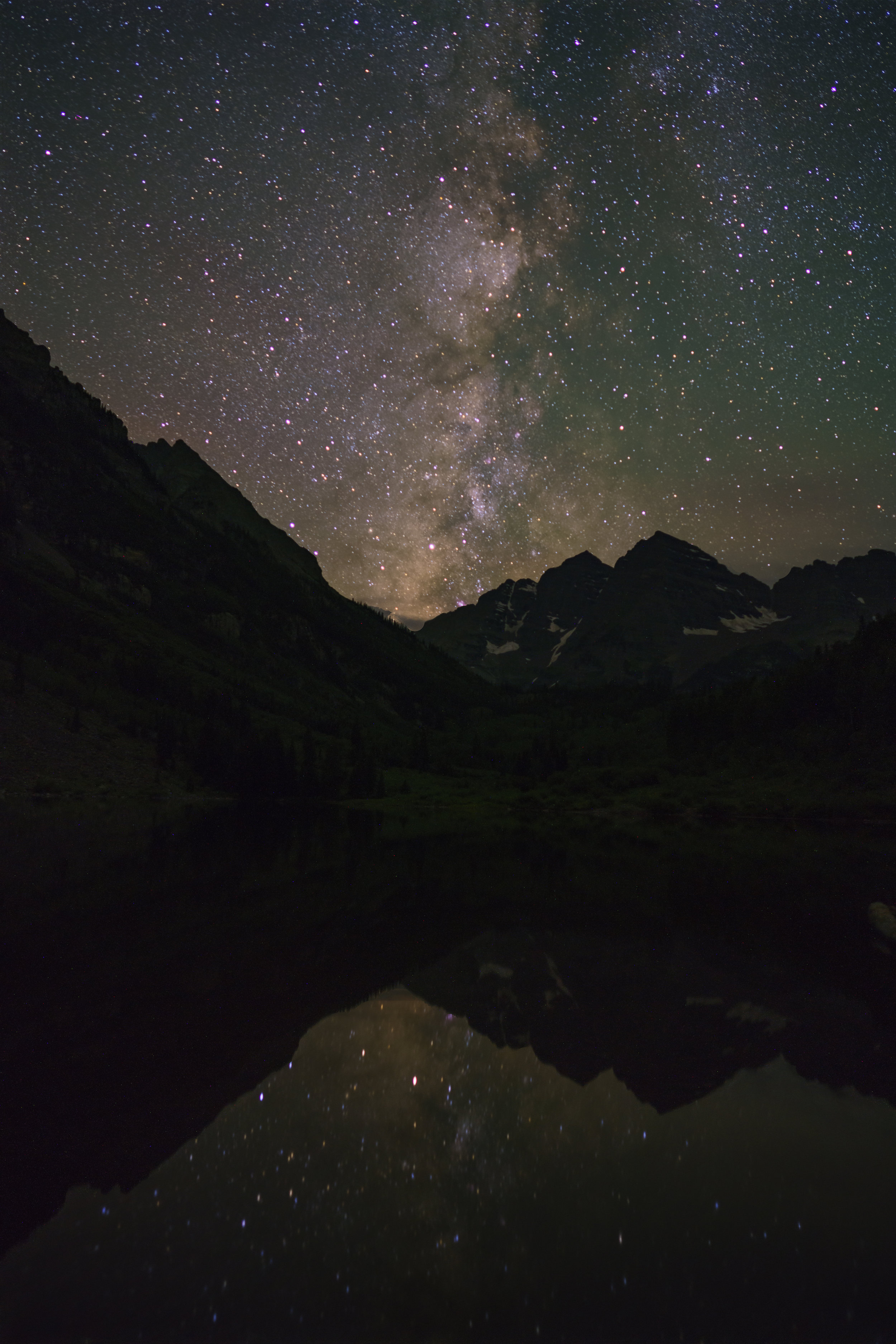
An icon, over an icon. I couldn’t not attempt the shot. This was an amazing night of walking and shooting and being out under the stars. I’m learning that astrophotography is demanding, and not very forgiving. But, when everything works, it is very, very rewarding. Images like this make me want to go back for more and more.
Made from 30 light frames (captured with a SONY camera) by Starry Landscape Stacker 1.6.1. Algorithm: Median
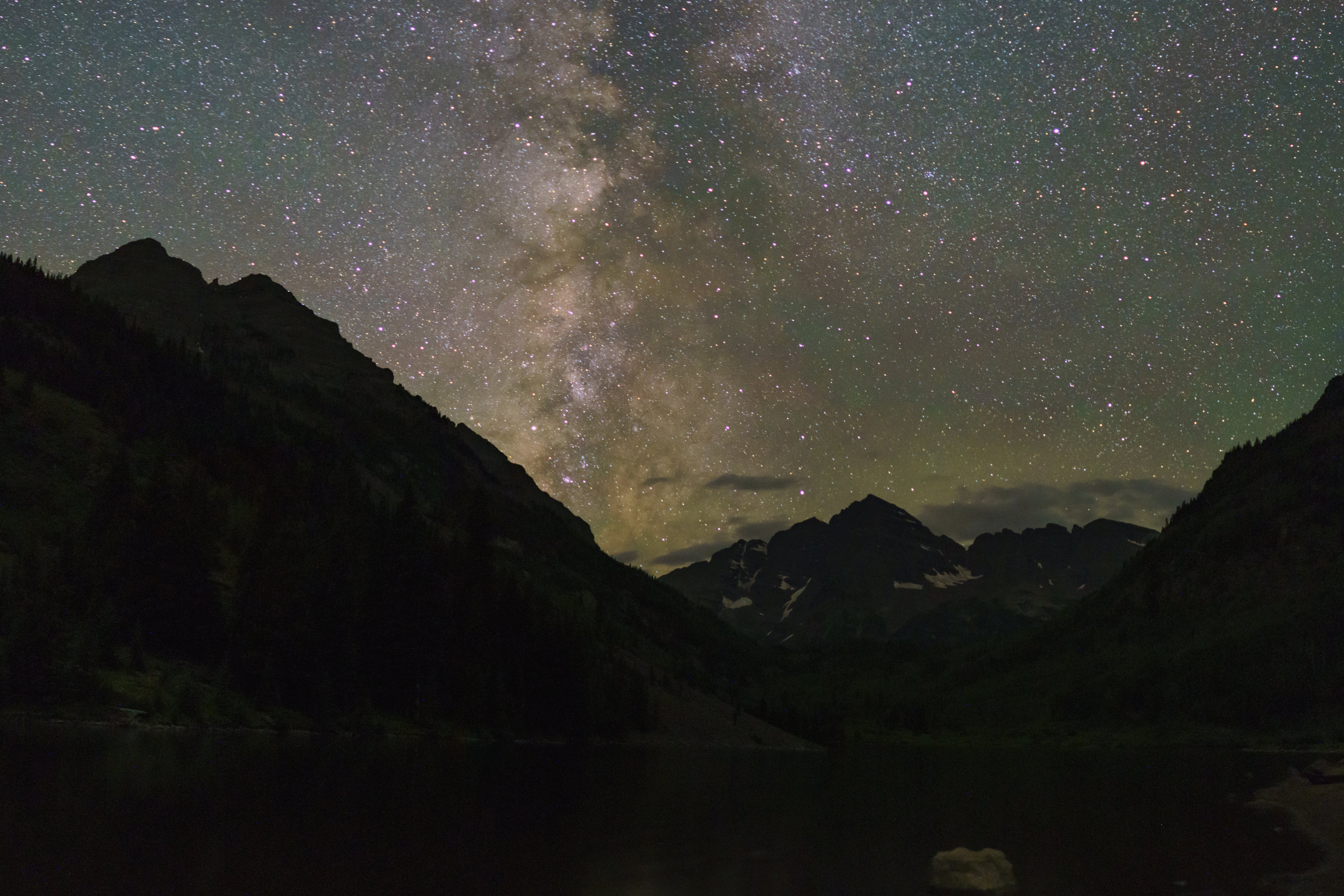
This was an amazing night of walking and shooting and being out under the stars. I’m learning that astrophotography is demanding, and not very forgiving. But, when everything works, it is very, very rewarding. Images like this make me want to go back for more and more.
I will definitely be back as this shooting season continues.



Trying to make use of some of the downtime. Going back to some photos from Labor Day, 2018. This is Lincoln Lake, the Snowy Range in Southern Wyoming, on a remarkably calm and clear night.
60 images were captured to create this one photo, along with a couple of hours of computer work to put it all together, definitely a labor of love.
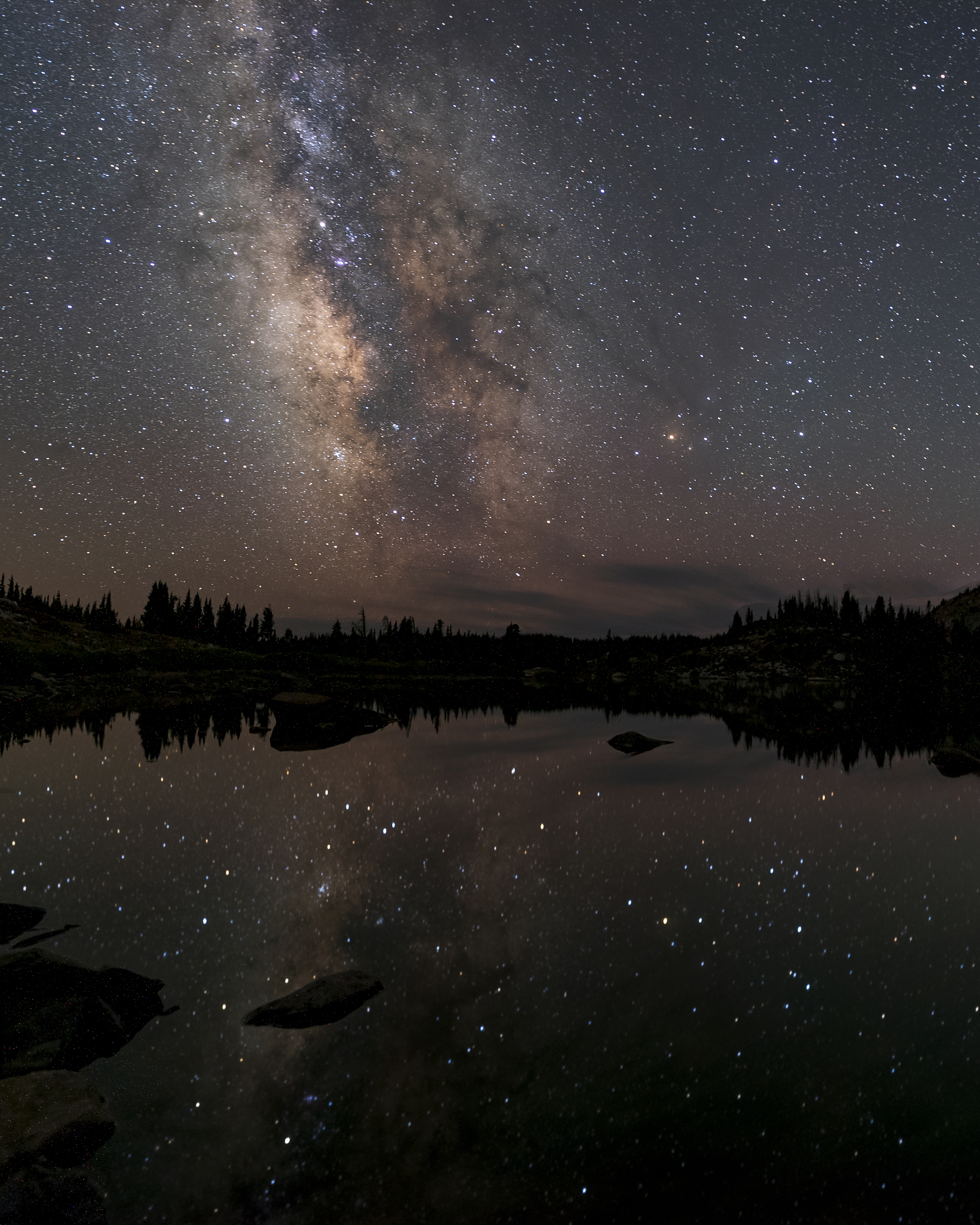
I’ve been working on shooting the Milky Way for close to a year now and while these still aren’t the compositions I was aiming for, they are such a radical improvement over what I was shooting, and I’m really happy with this composition in particular.
I’m hoping for a tracker in the next year, which will allow for even more color and contrast in these images, but until then, I’ll find some different nighttime locations!
Made from 24 light frames (captured with a SONY camera) by Starry Landscape Stacker 1.6.2. Algorithm: Median

An oddly beautiful and lonely evening. The first four hours spent under the rising Milky Way, then moving to this pristine patch of water to watch the New Moon do the same thing.


I’d originally intended to shoot the rising Milky Way over Mirror Lake, but wasn’t satisfied with the composition and the relationship to the Milky Way. I decided to comeback though, to shoot star trails, but again was foiled by not enough planning ahead of time, and the lower aspect of the North Star.
The tail end of the Milky Way, reflecting in the lake is worth compensation for this night’s outing.
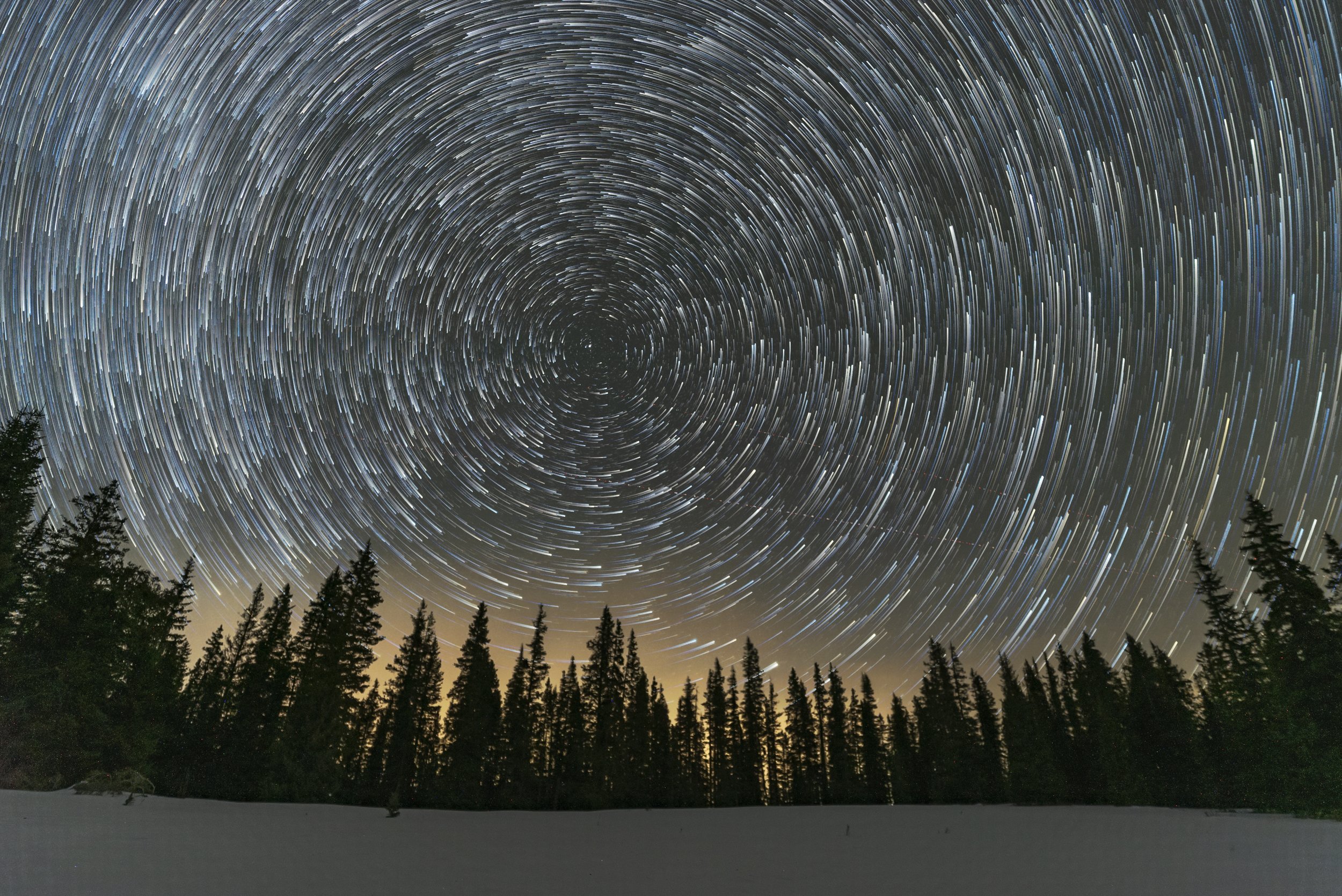
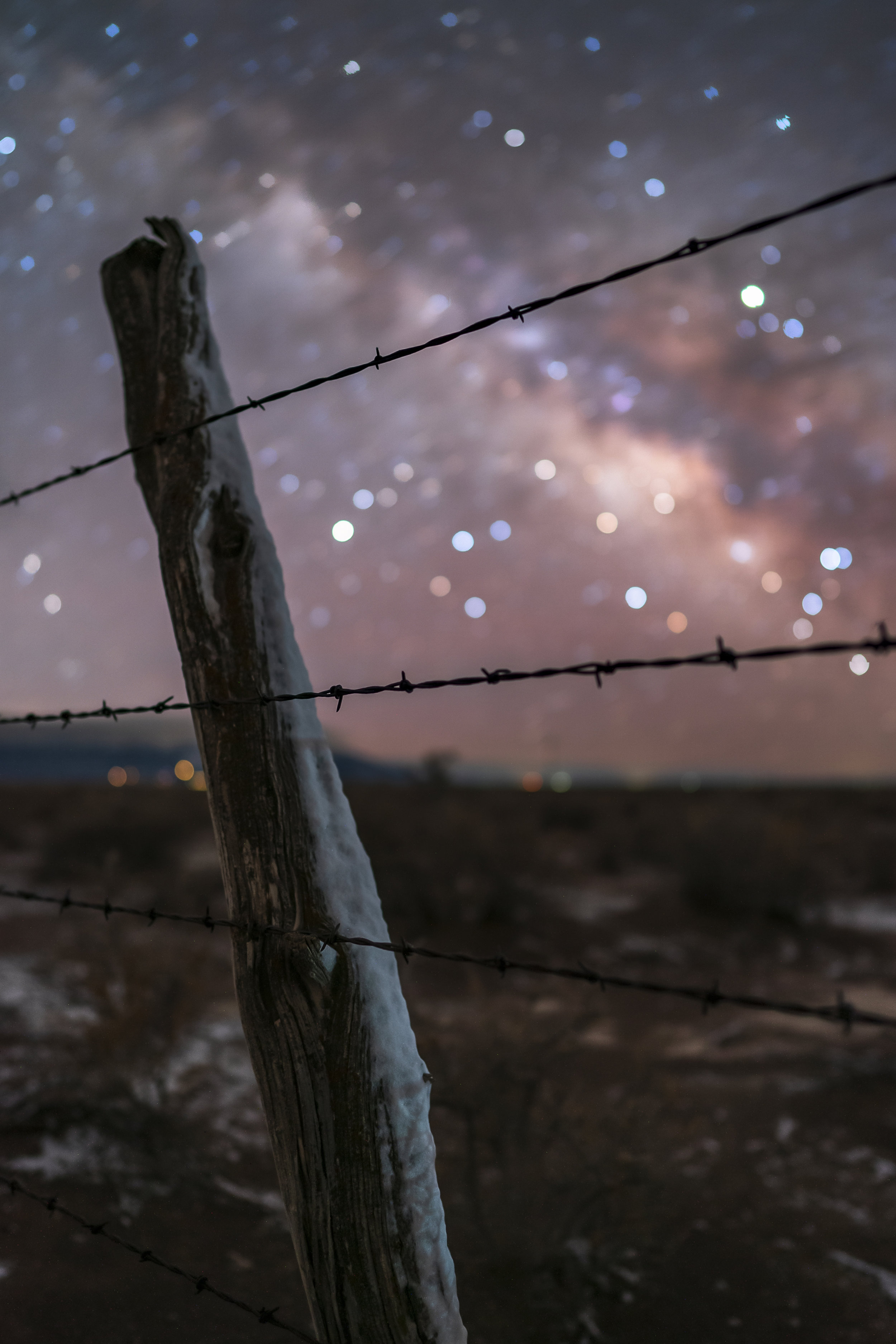
I have to admit that I really, really do like this image. I have attempted this format before, but can honestly say that the results were not what I’d hoped for. A year later, and a little better understanding of the process, and more favorable conditions gave me the chance to shoot multiple frames so that they could be stacked to reduce image imperfections and bring out detail that a single image in low light just can’t produce.

Early season Milky Way, arriving just before dawn, climbing over the Continental Divide.
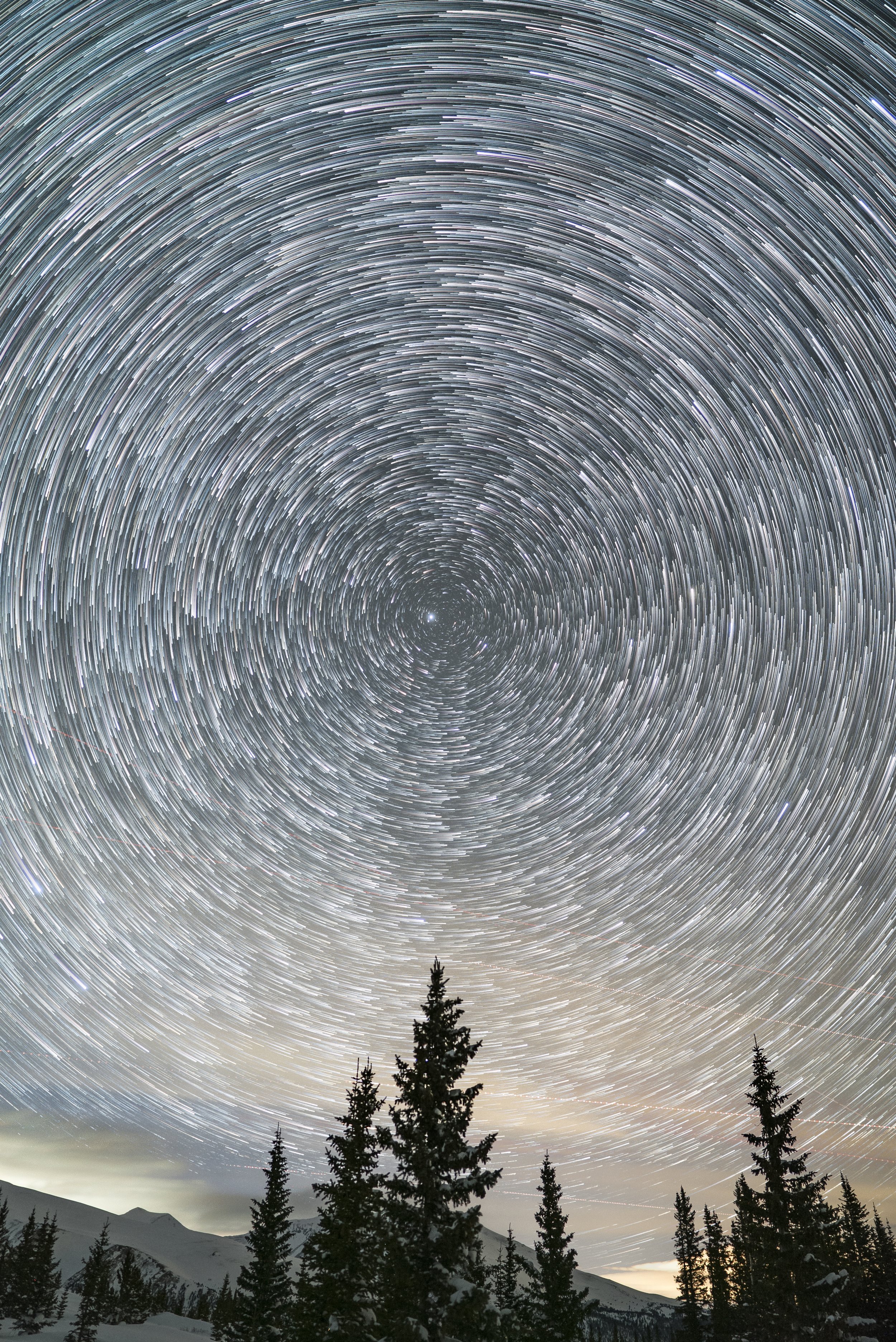
Another star trail composition shot over the Valley of the Sun, with Mt. Bross in the distance. This is 560 images stacked together to show nearly three hours of passing time.
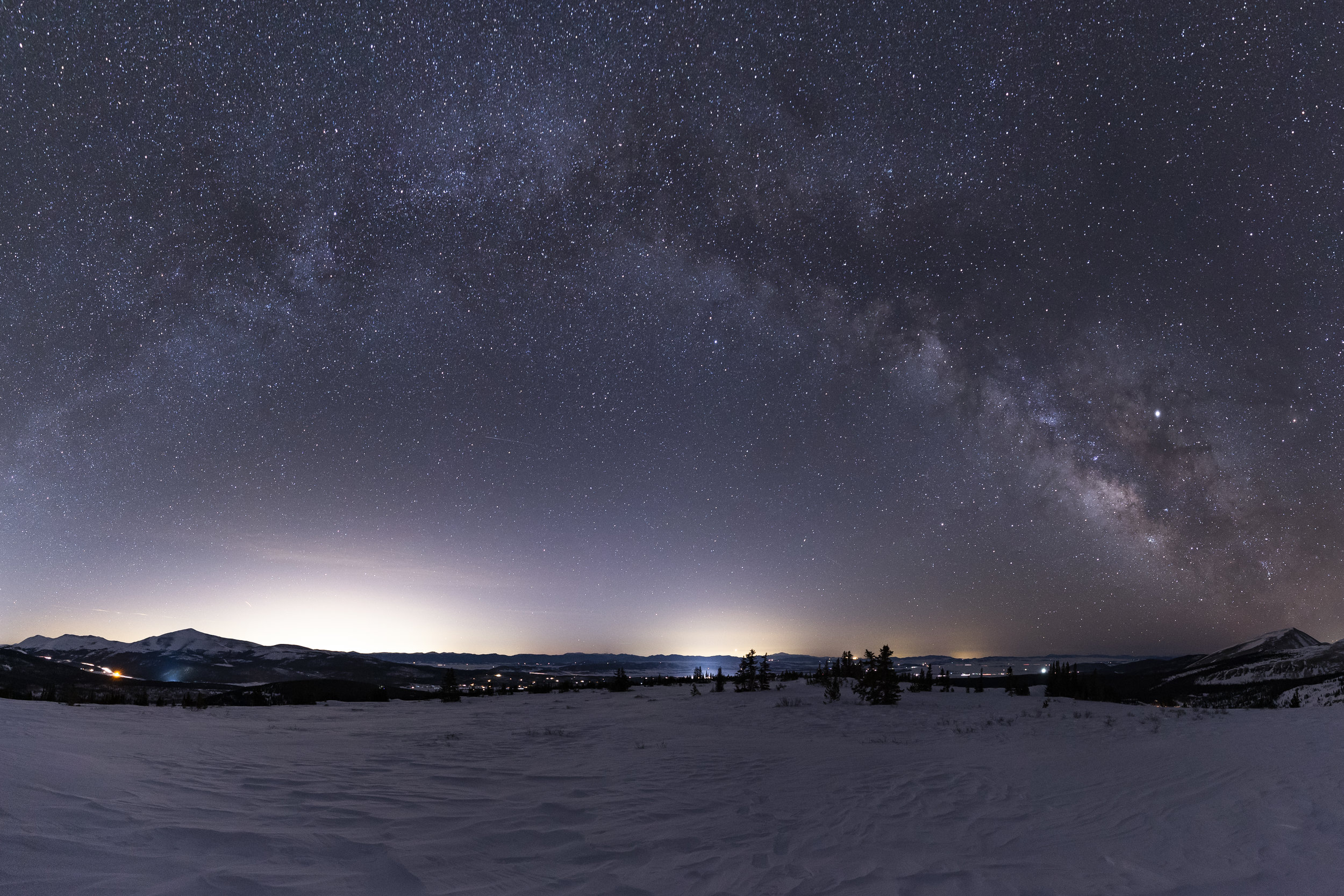

A similar composition to a shot last month from the San Luis Valley. It’s been three weeks since I was able to take advantage of the Milky Way, and I hope to have many, many more nights under the stars this summer. But right now, with the end of the school year approaching, there are so many things to accomplish and so little time for planning.
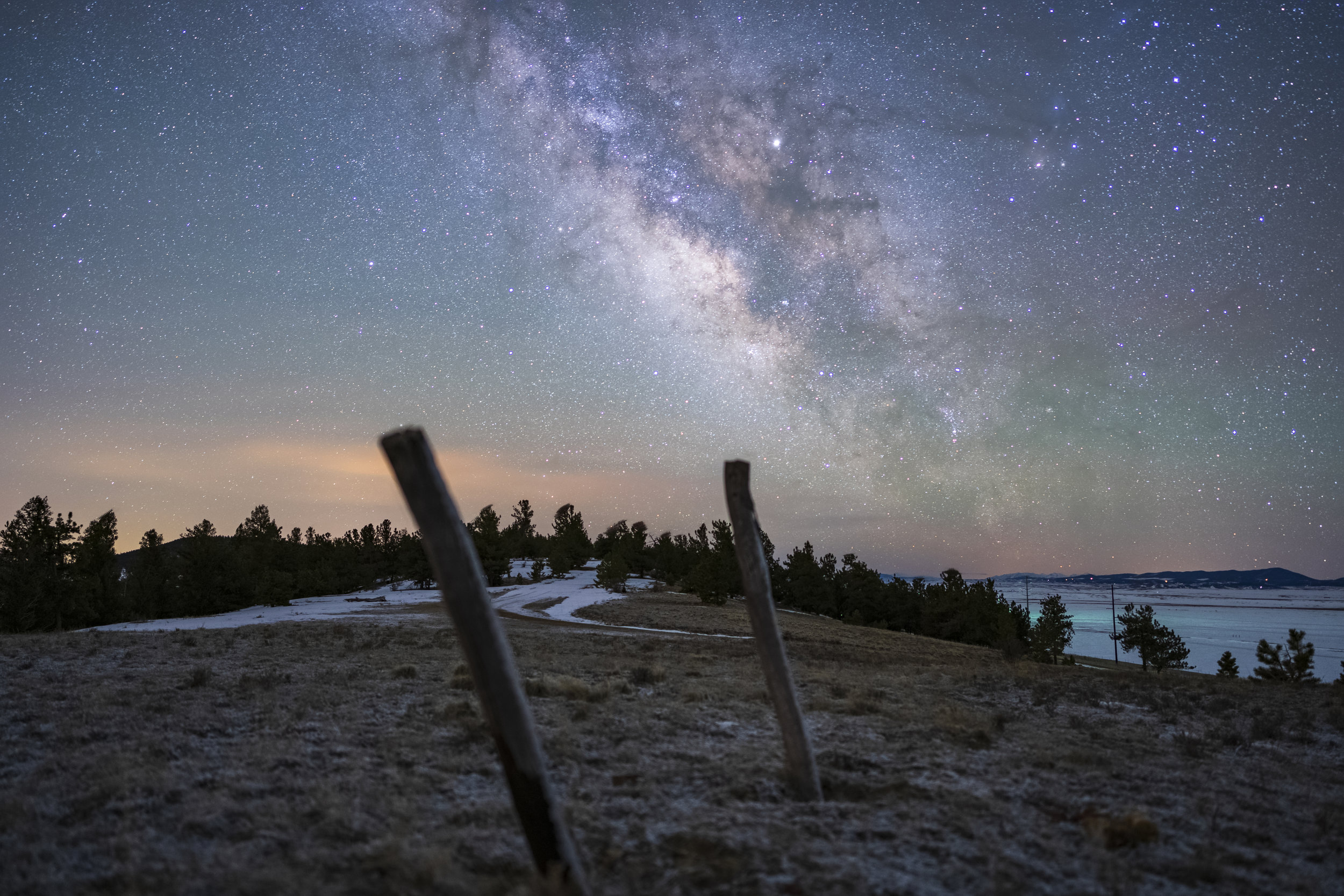
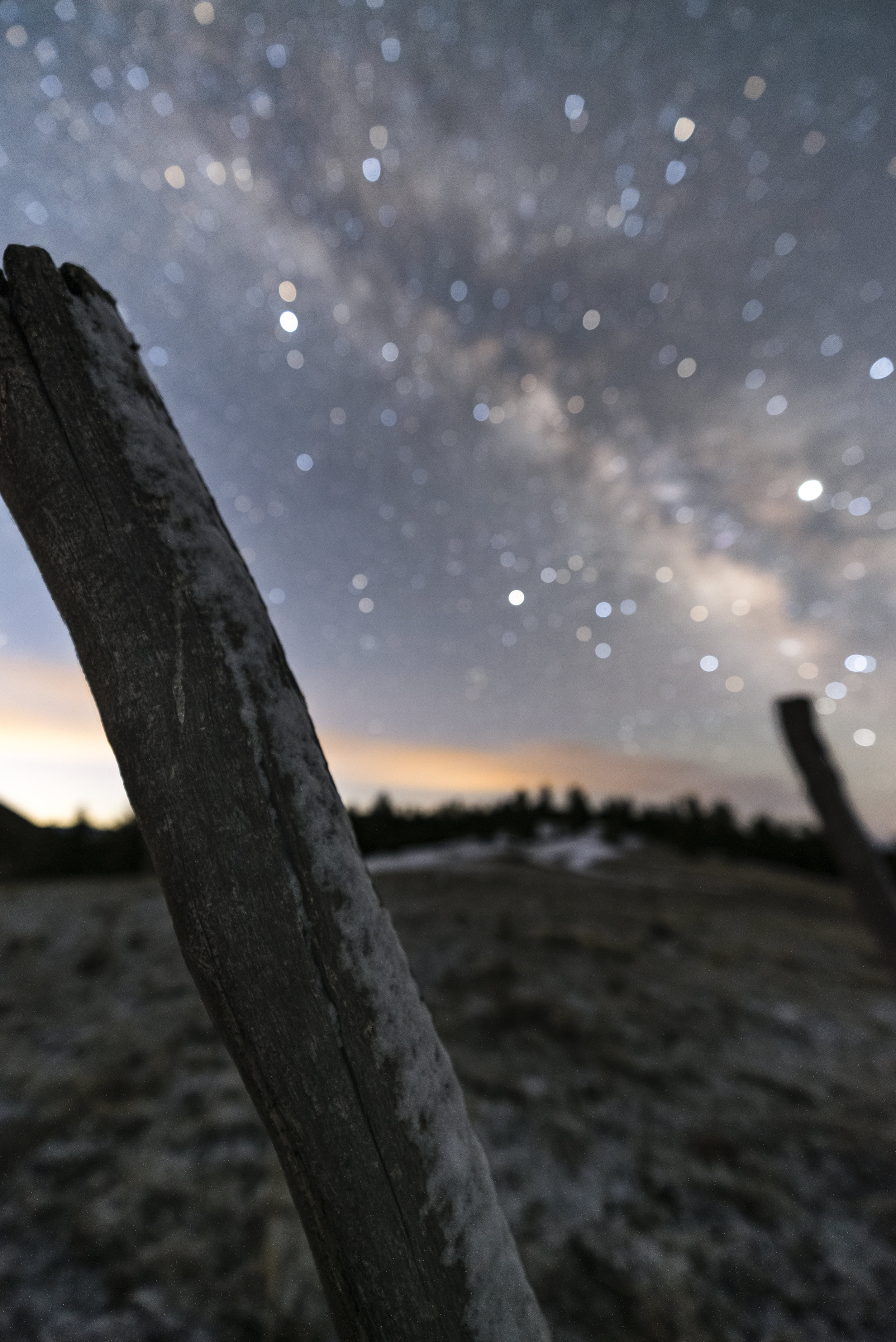
A similar composition, but a completely different location. Strange weather, it was extremely windy up high, and the blown snow created more diffraction than normal. The coloring was hard to correct, but the effect is still apparent.
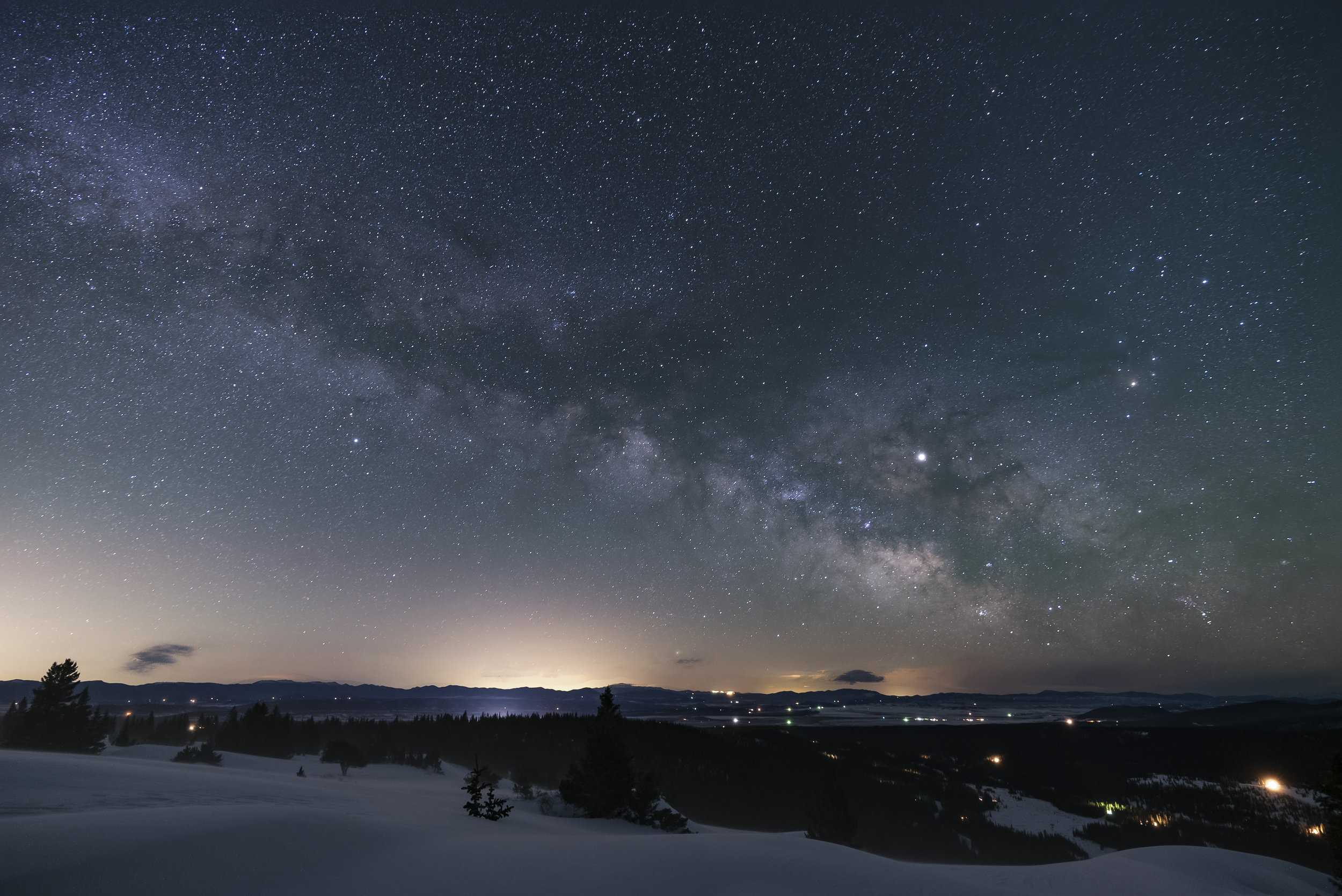
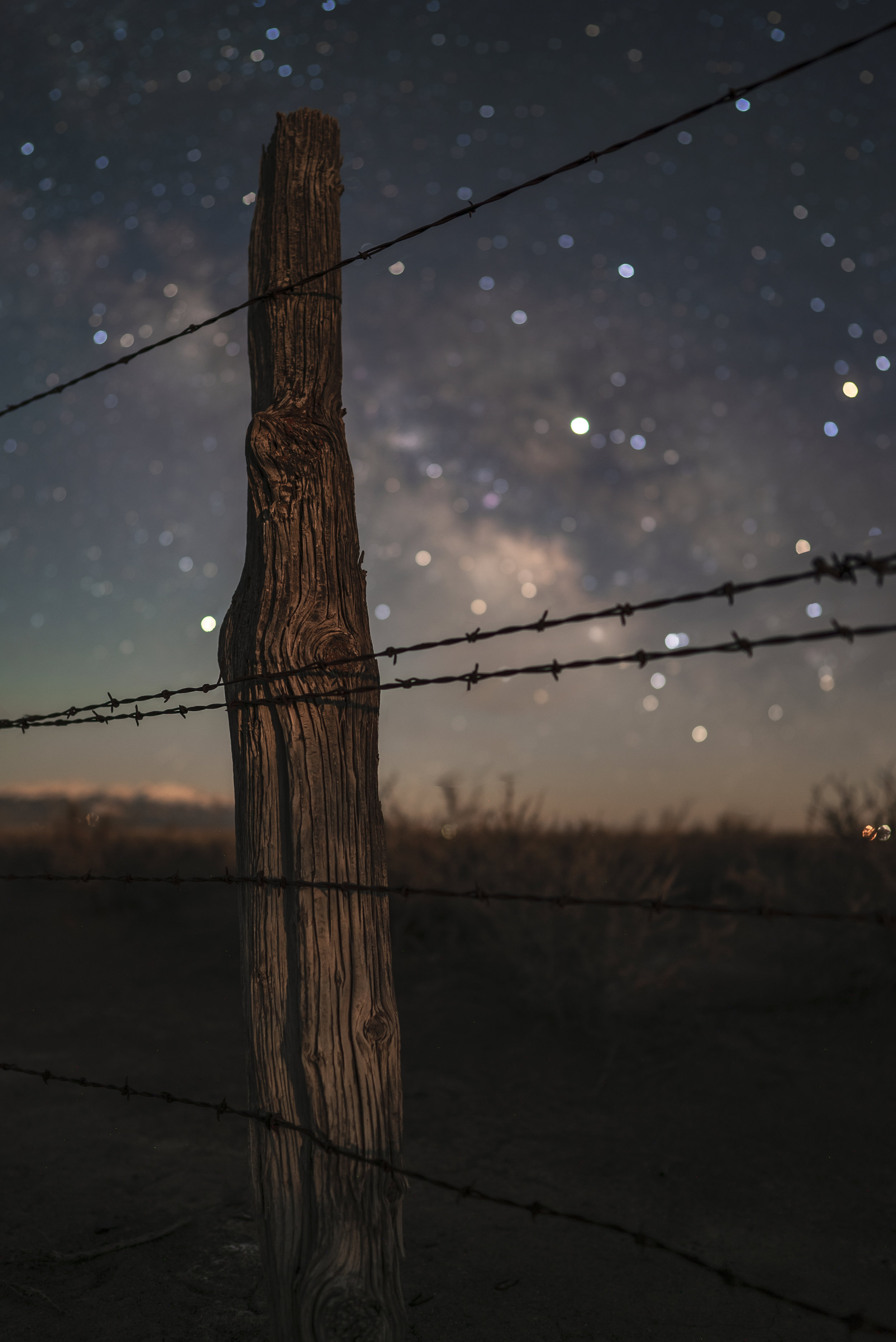
This style of composition is quickly becoming a favorite for me. Another overnight drive to the San Luis Valley to catch the Milky Way as thrown off by the moon. Somehow in the week I’d missed the moon phase and didn’t realize it was setting in the early morning. BUT, that allowed for this framing, with the Milky Way well above the horizon and the Moon just about to set, the glow of the illuminated the post, and gave an amazing brilliance to the scene.
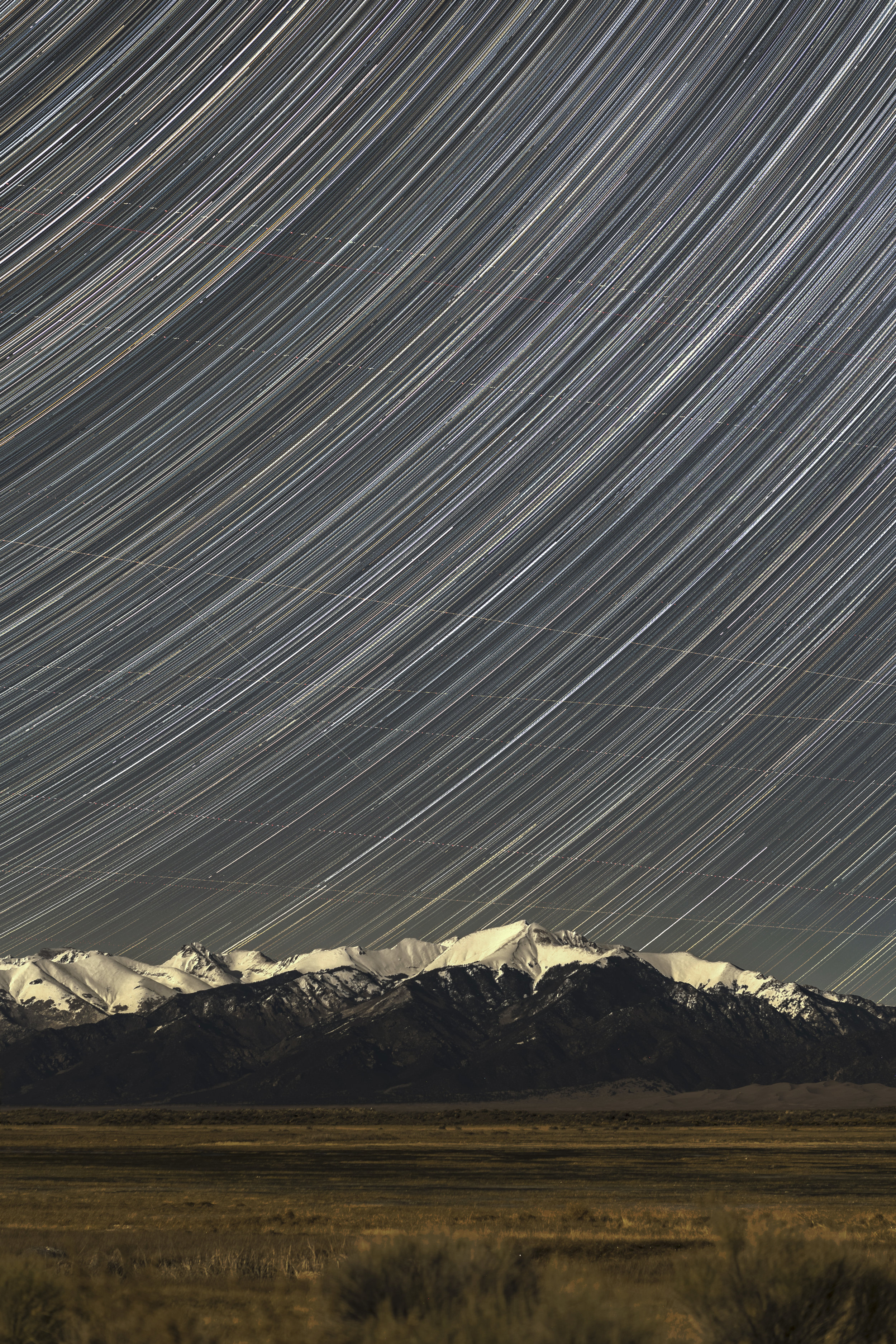
Most often star trail compositions are shot using a wide angle lens, one that allows you to center on the North Star and then take in the full arch of the stars as we spin under them in the night sky. I decided to try something different by using a longer focal length, 85mm this time, and only record a portion of that arch. Shooting north and west into the Sangre de Cristo mountains, the scale of the night sky becomes more evident, especially when your eyes catch the lower right portion of the frame and realize that is Star Dune, the tallest dune in North America.
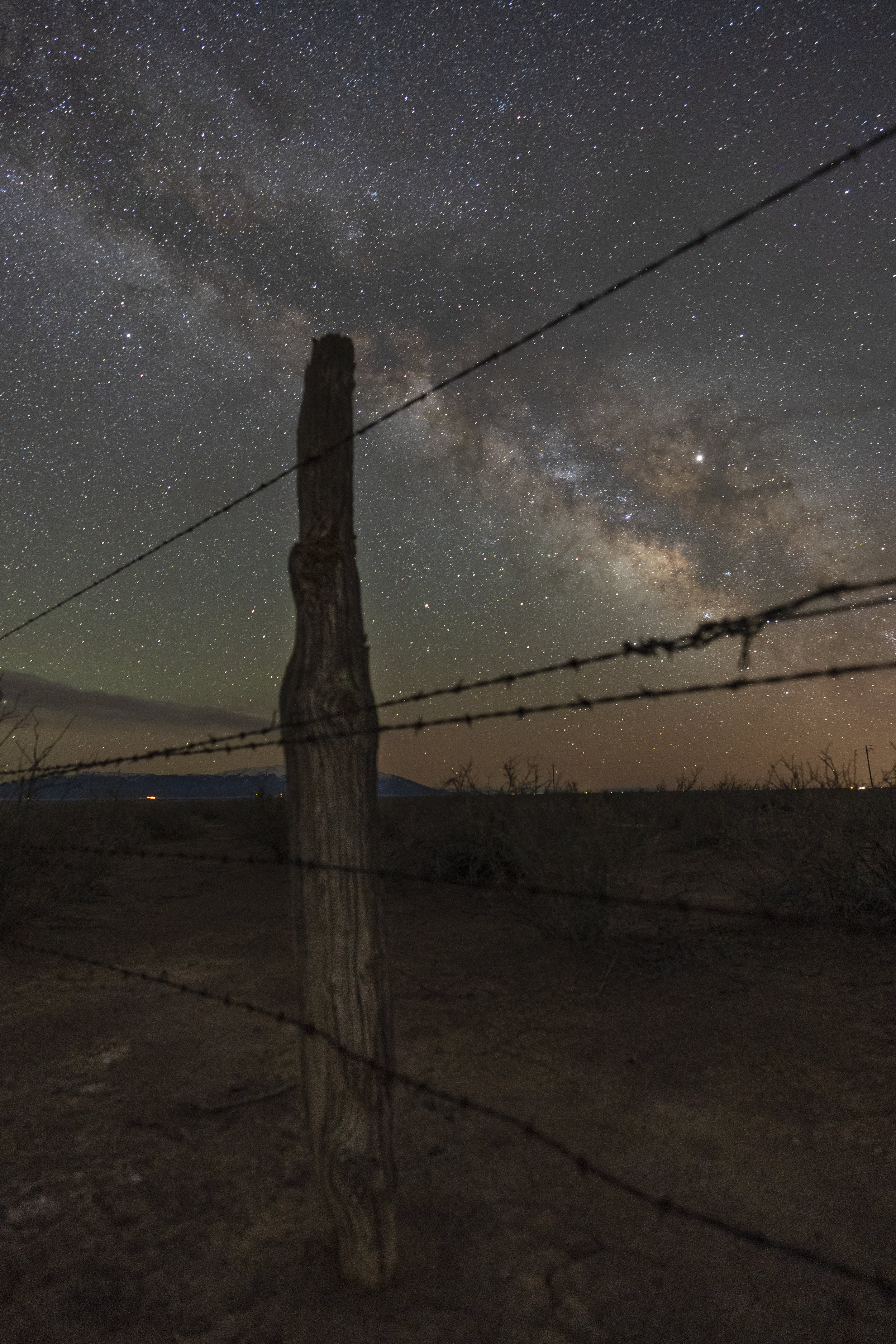
This is the more common composition of the Milky Way, clear, pinpoint sharp stars, a less focused foreground subject (if you haven’t created a composite image, which I haven’t) and the the glow of the star clouds and nebula being the thing that draws you attention.
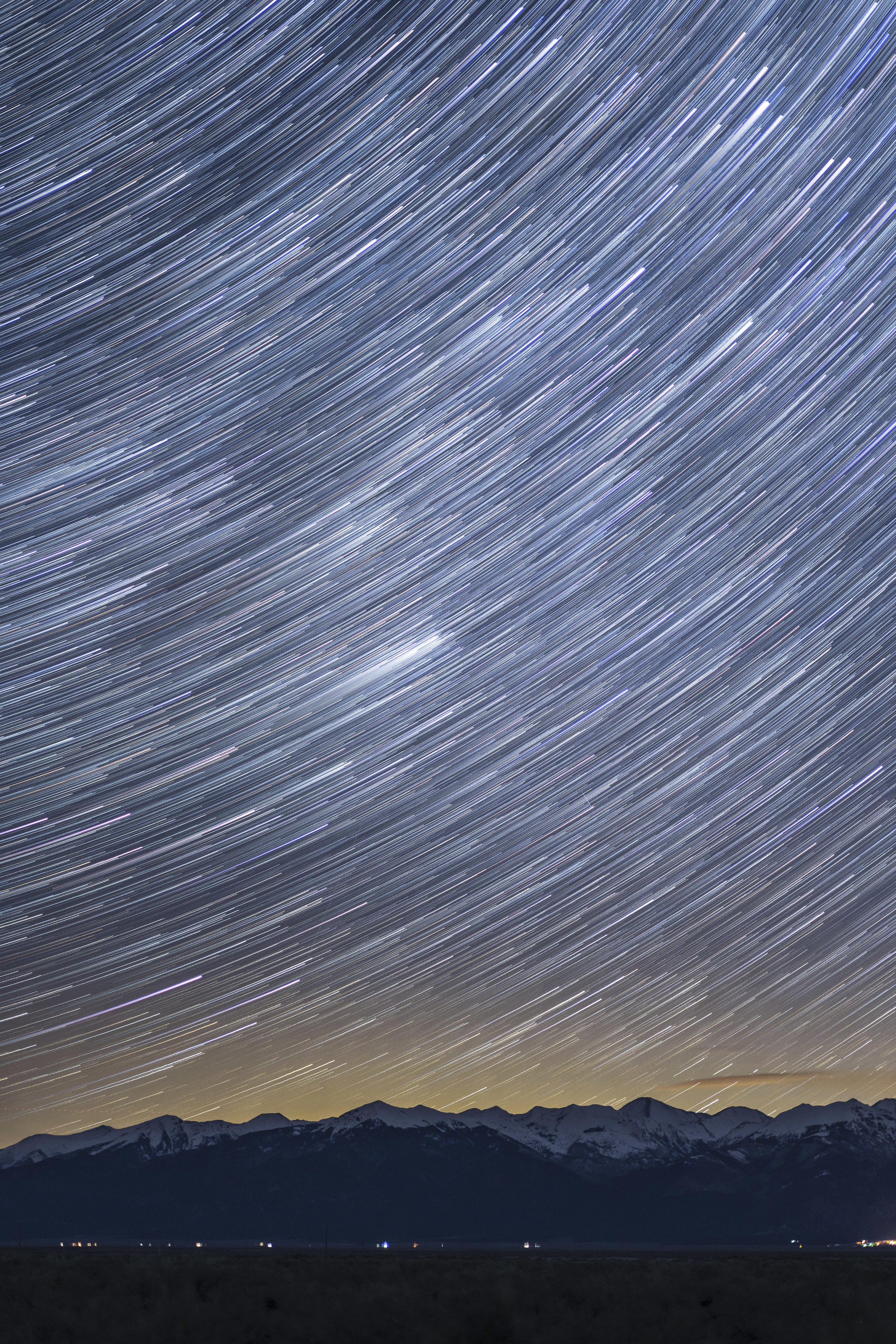
The difference a few hours can make is really remarkable with night time photography. The moon had fully set by the time I start to shoot these frames. In all there are a little over 150, stacked together to create another sweeping arch in the night sky over the Sangre de Cristo mountains.
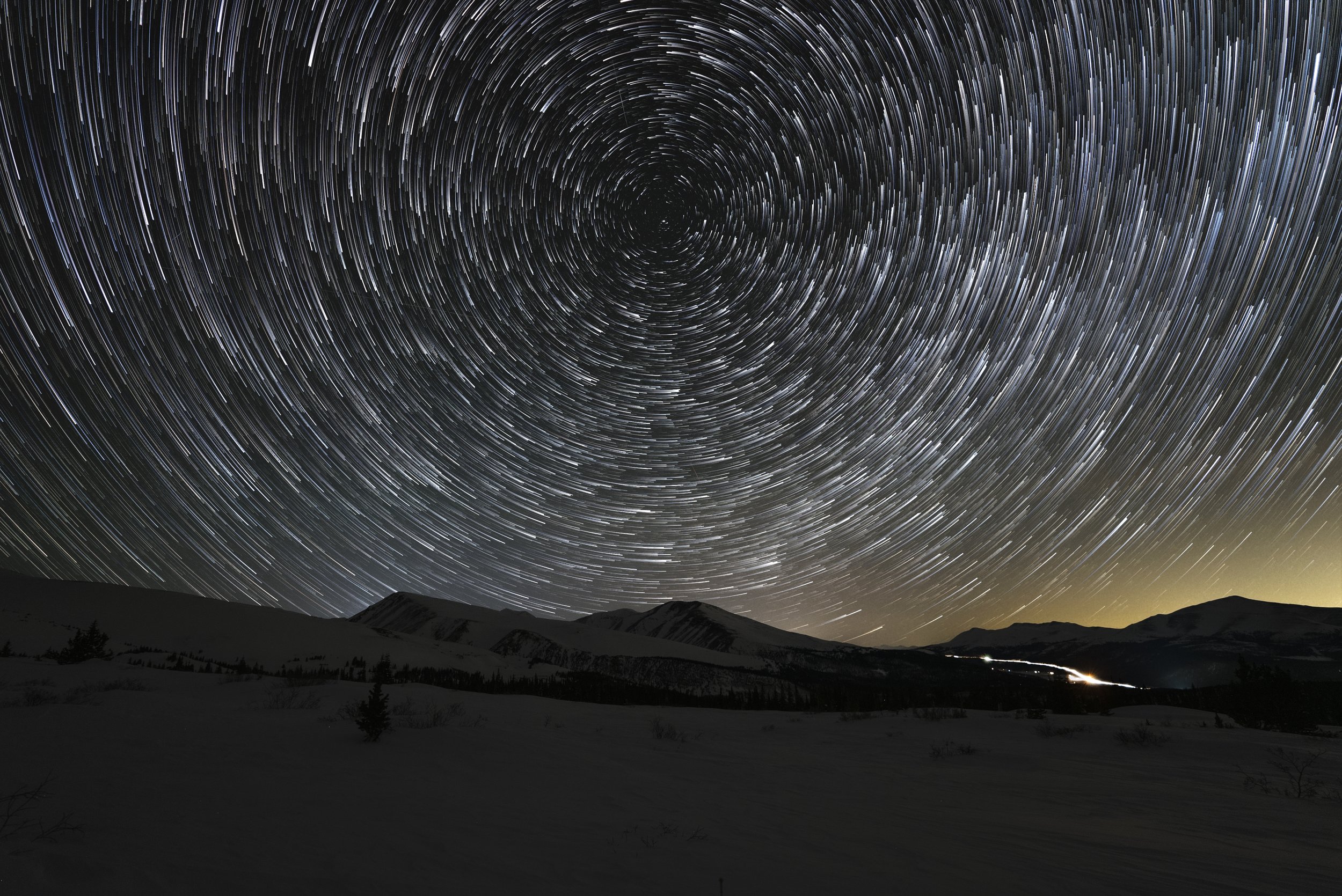
Star Trails over the DECALABRON, Mosquito Range. I re-edited this to remove the trails left by passing planes. Kind of a tedious task, but the skies are clear and the lights from traffic descending Hoosier Pass convey the passage of time.
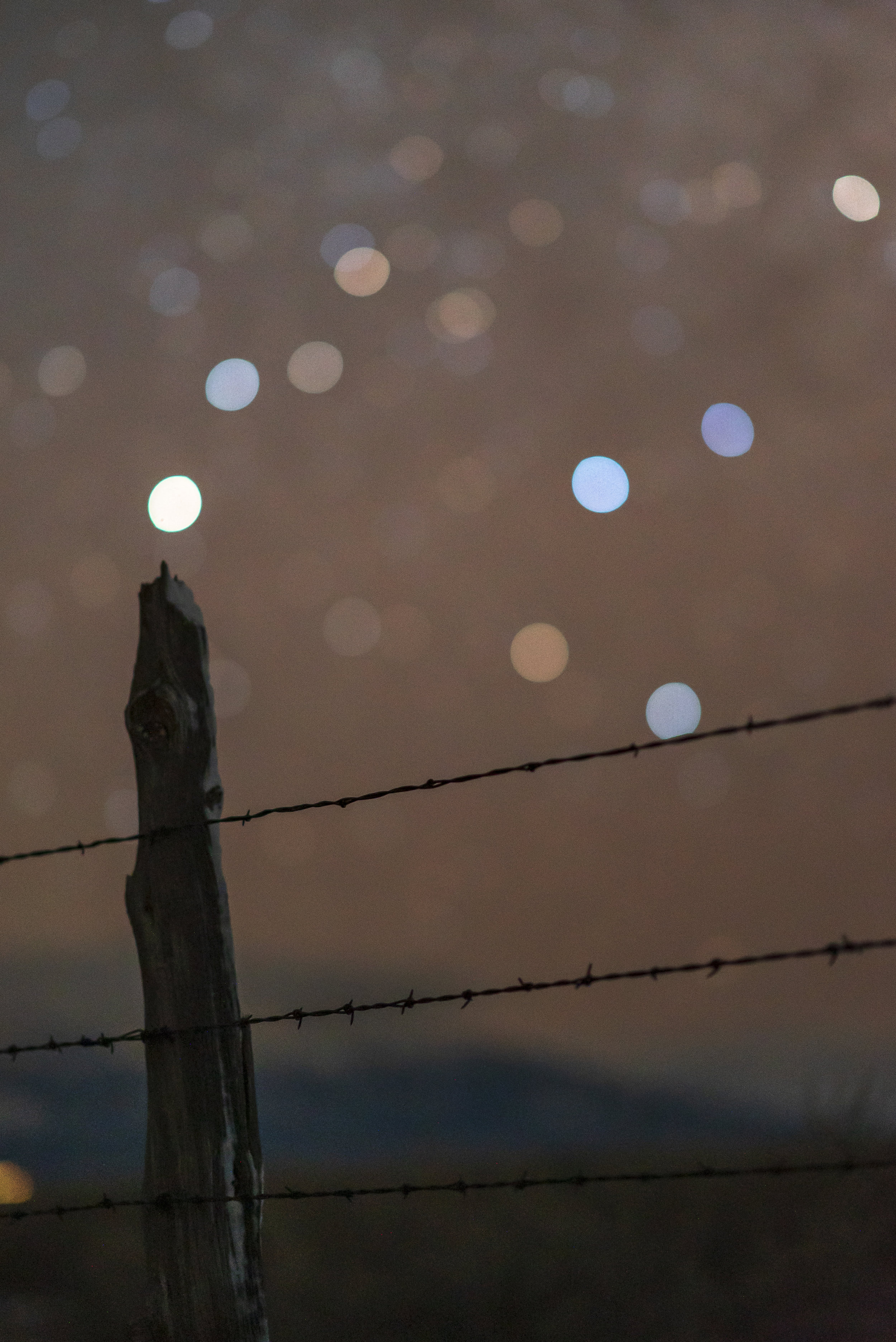
Using a longer lens, 85mm does a lot to compress a scene and can separate the subject from the background. In this case, the subject is a worn our fence post still stung with barbed wire, and the background is Mt. Blanca illuminated by the Milky Way. I wasn’t as careful with this composition as I should have been, but I do like the results.
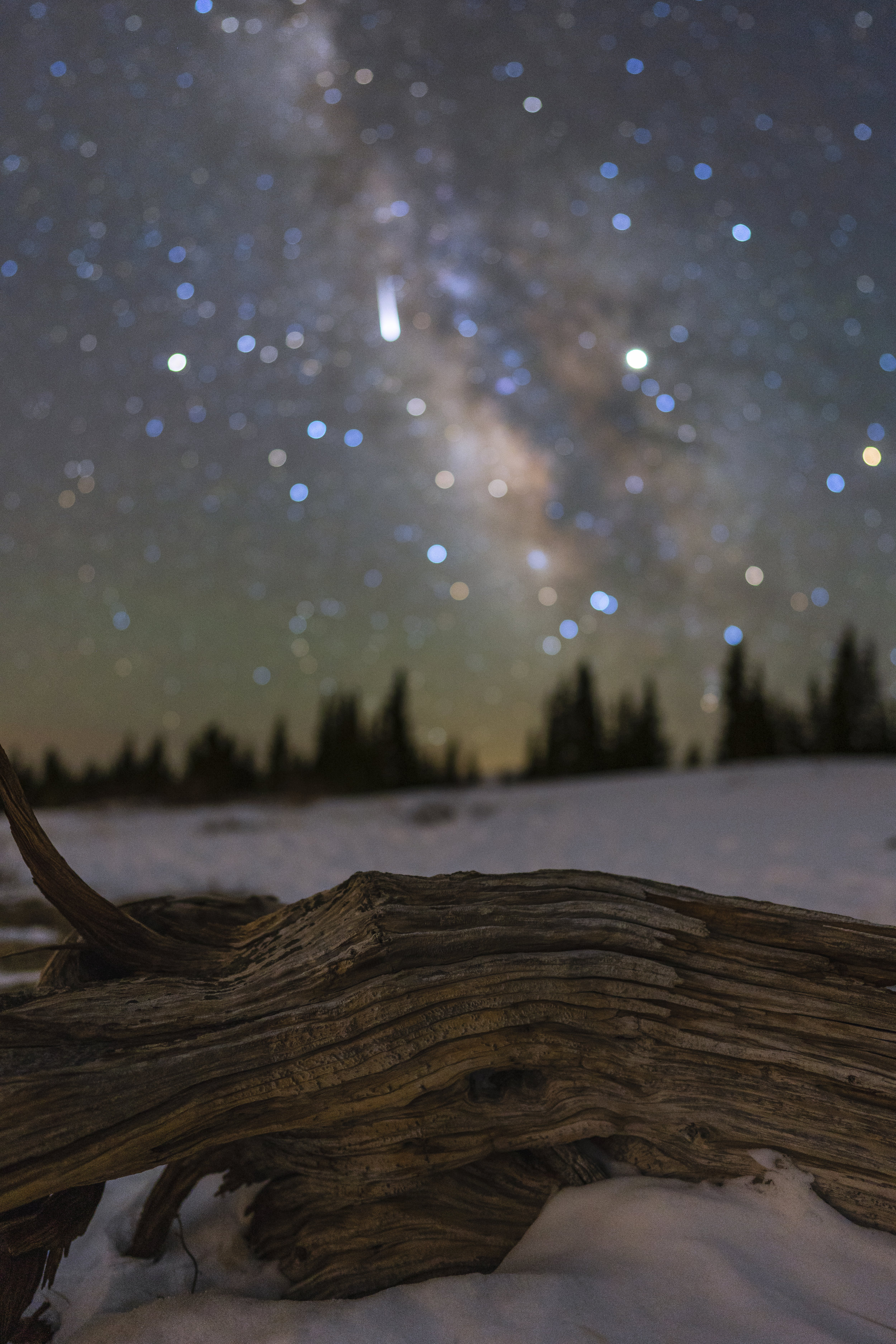
In photography, the term used to describe the out of focus area, the blurry area, is called “bokeh.” It is described in a variety of ways and is used to highlight the subject. I have become intrigued by this technique, especially in a nightscape like this, where the Milky Way itself creates the background. The challenge with this type of shot is having a subject, in this case the trunk of a long dead tree, but interesting enough AND be still enough, as the shutter will remain open for as many as 20 seconds.
So, I decided to set this up, as a fairly simple composition. And, while I’ve caught shooting stars, really meteors, before in a frame, I’ve never had one be so bright and distinct. I think it is because of the defocused nature the night sky itself.
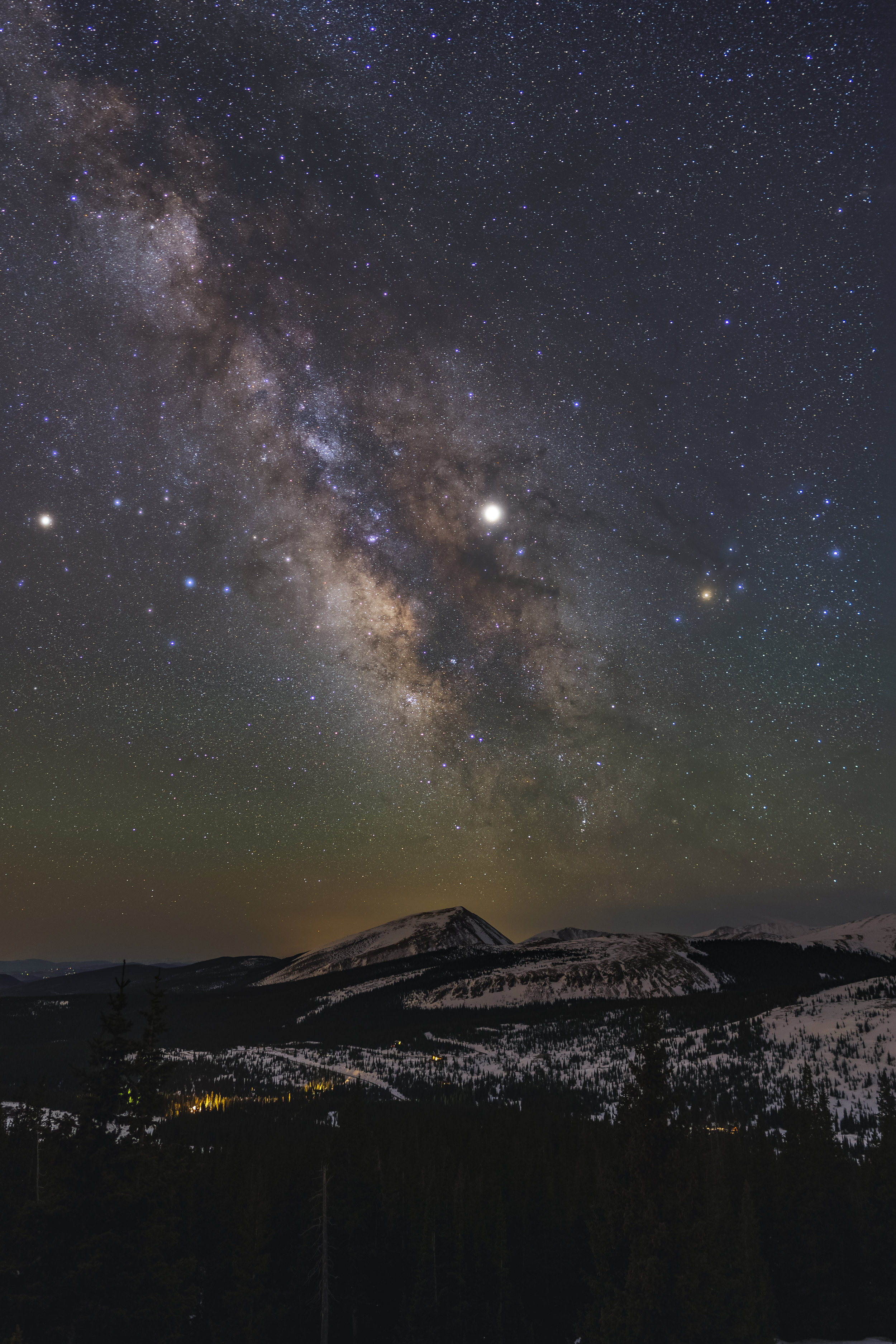
That's Jupiter, near the center of the frame. That’s another lonely soul, up in the middle of the night. That’s the core of the Milky Way, the way I’d initially intended to shoot it.
The composition is compromised of 35 images stacked together to give clarity and reduce distracting elements referred to as “noise.” I’m certainly not expert at this work, but I do enjoy it, and I do feel that overall the results are improving.
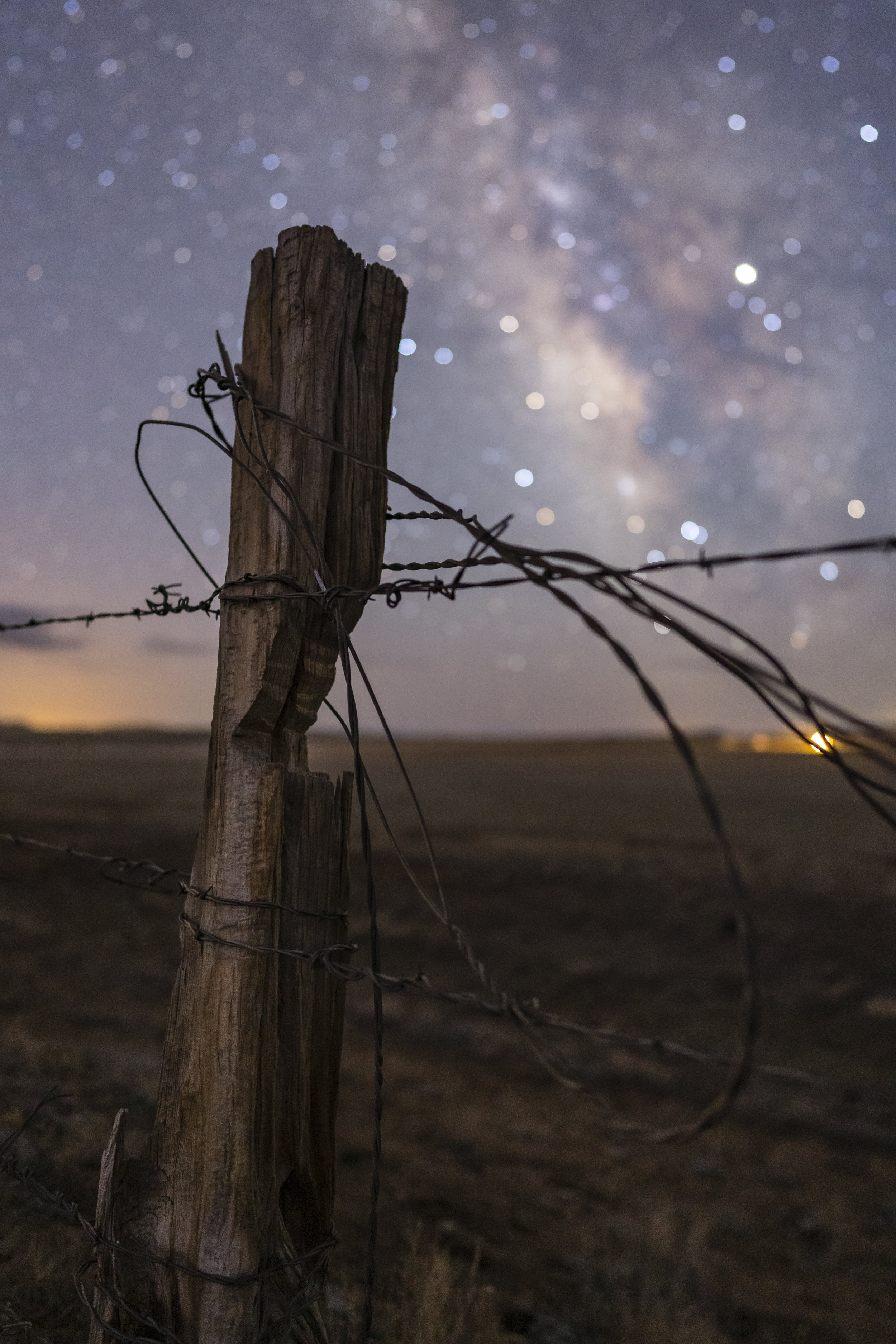
National Geographic received a lot of bad publicity recently for some Milky Way images that were published in their magazine. The images actually violated the publications own rules, and they have since taken the images down and the photographer’s work is not getting any credit.
That said, I think it’s import to disclose the work. I do try to be honest about what I shoot, and what I share. I think I’ve been honest about the fact that I do edit my images; there is color and definition that the eye doesn’t necessarily see, that the camera does. And, your phone is in fact a computer, so even the image that you snap with it is processed by the software before you actually see it. The hashtag #nofilter is actually pretty meaningless, unless the image was captured as an ARW file, and that is pretty difficult to do.
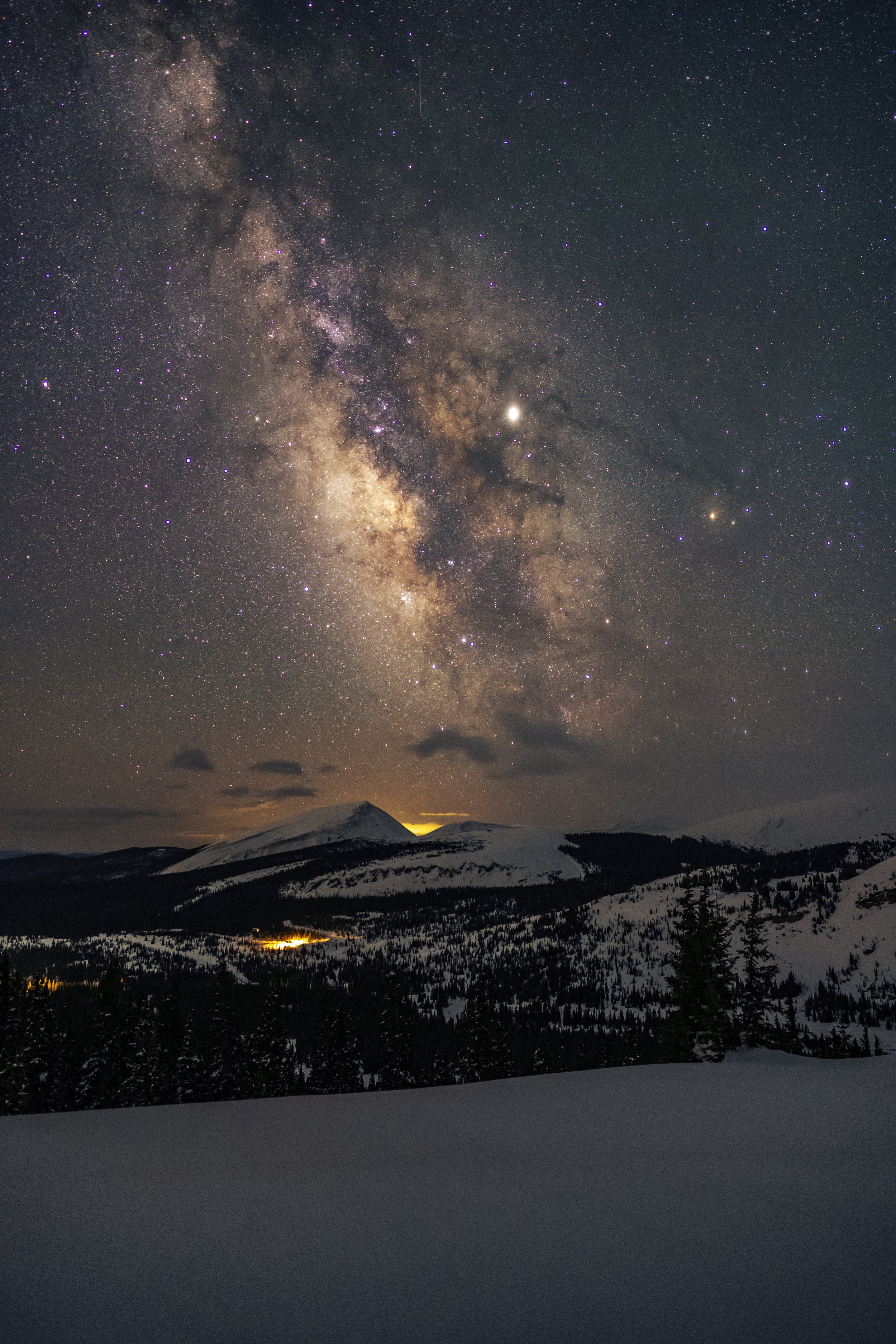
The post-processing of this type of work is equally time-intensive and rewarding. I’ve been reading about and experimenting with some different techniques to clear up my overall image quality and to create more luminescent core of the Milky Way.
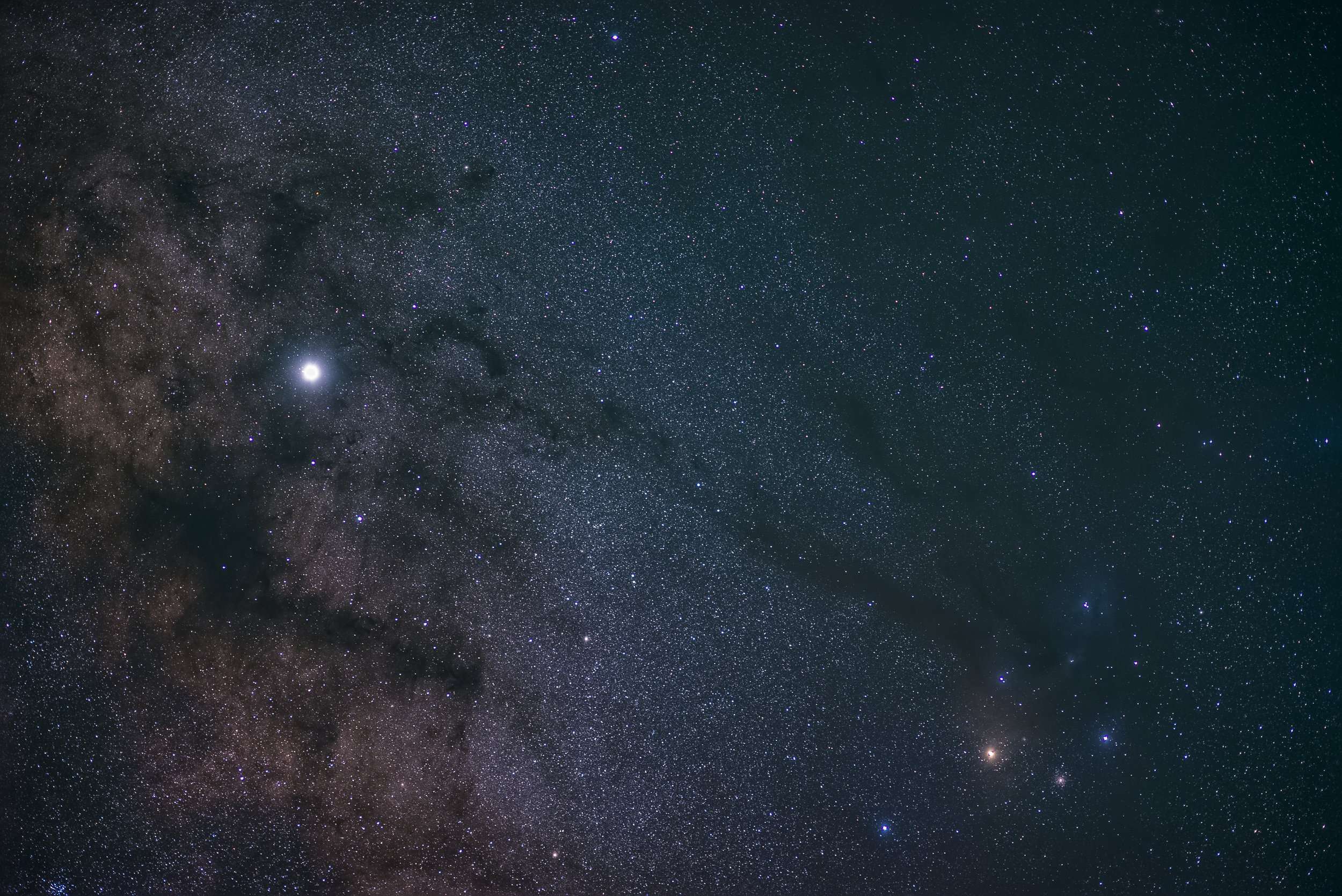
Extreme work, both on the composition and editing ends of this image. The is a series of shot into the Dark Horse Nebula, which currently has the planet Jupiter sitting right in the heart. Off to the west lies Antares, at the heart of the Constellation Scorpius, and the Rho Ophiuchi.
All totaled, this represents 80, 3 second compositions shot over a of about 6 minutes.
ISO 12,800 | F/1.4 | 3 secs. - 85mm

Camped out along the Rio Grande, it just took a short, quick hike up to the plateau to find the unencumbered view of the galactic core. This was shot was initially made from 30 images stacked together, then reduction and contrasting filters added to bring out the gaseous bands of the the core, including the Dark Horse Nebula and the Rho Ophiuchi, with Antares at the center. Shot at 50mm, I’m definitely going to work to improve this technique.
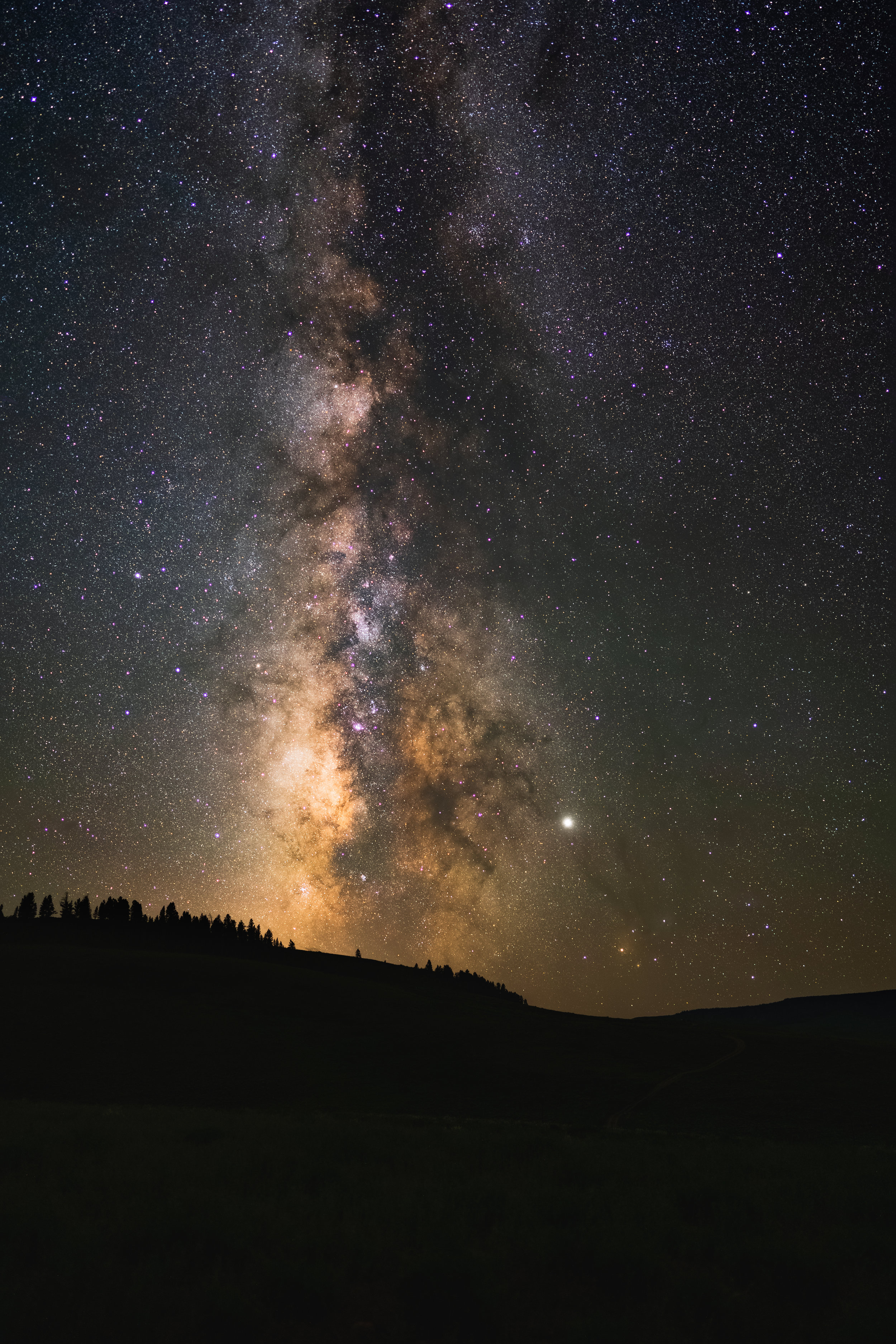
This spot, just north of Almont, Colorado, has produced some brilliant wild flower compositions during the daylight. Our heavy snows, and cooler, and wetter, spring nurtured a bloom that has been seen for some time. So, waking up after the moon had set, and find the sky aglow with the Milky Way core, I decided to point my camera up instead of down, and was rewarded with some of the darkest skies yet.
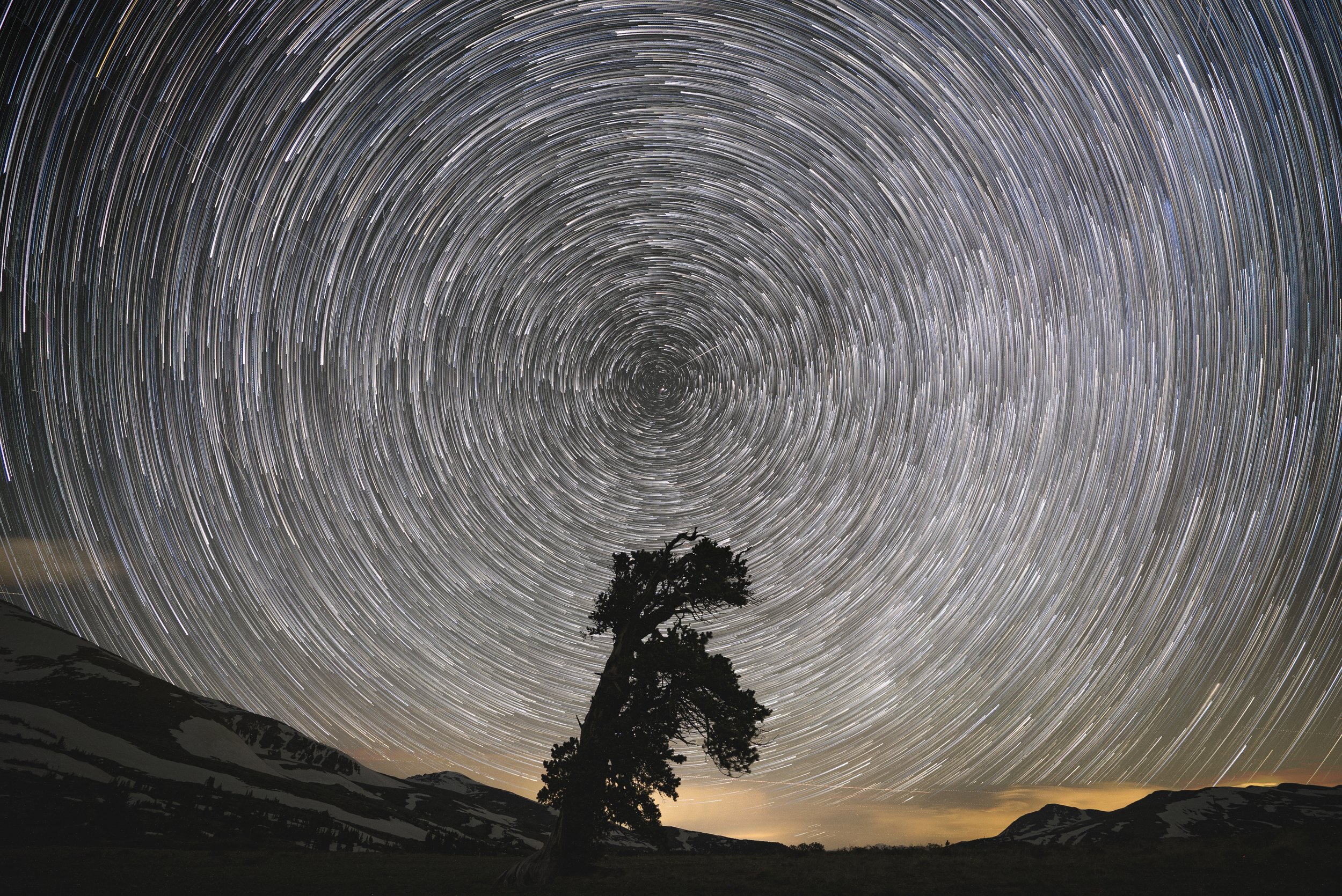
Two hours with a thousand year old tree, a night that puts things in perspective.

85mm makes a significant difference when photographing the night sky. Capturing the detail of the Milky Way core and the Dark Horse Nebula over Independence Pass is a treat of immeasurable joy.

Jupiter is about to land, and the Dark Horse is racing up South Maroon Peak, an amazing sight to capture on a late July night.
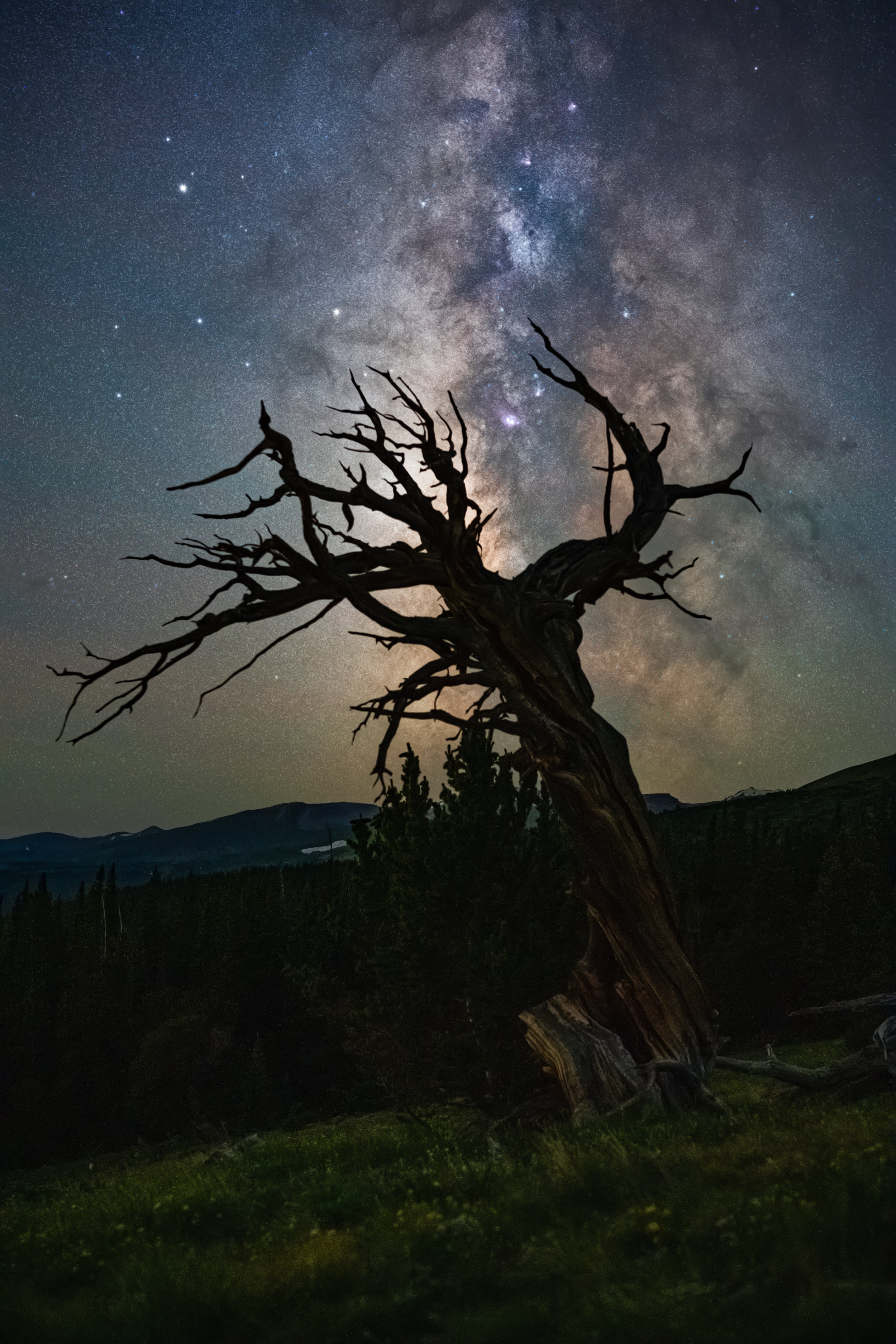
The mid-summer Milky Way framed by one of my favorite trees.

At 24mm the framing couldn’t be much more perfect. The heavy snows sent avalanches racing down the mountains all winter long. Debris and logs were left chocking lakes and streams all summer long. For me, a pocket of calm water gifted me a reflecting pool to frame our galaxy.

There are some moments that will outlast others. Some experiences that stretch from moments and seconds to minutes and hours. Most nights that I’ve shot the Milky Way involve not only the dark, but some other cold and a harshness that leaves you stinging and in awe of so many wonders. This was was different. For the rarest of times, it was still, and deathly still I’ve only experienced one other my time in my life. But this stillness was the type that did put me in awe; no wind, no clouds, no disturbances whatsoever… And then the meteors, streaking across to top of the sky. I didn’t catch any of the biggest in my frames, but I swear I saw the biggest most brilliant one in my life.
These conditions, this is why I return. This is why I continually hunt for the images and scenes. They each inspire an awe, and they are each unique, and silently terrifying in their own way.
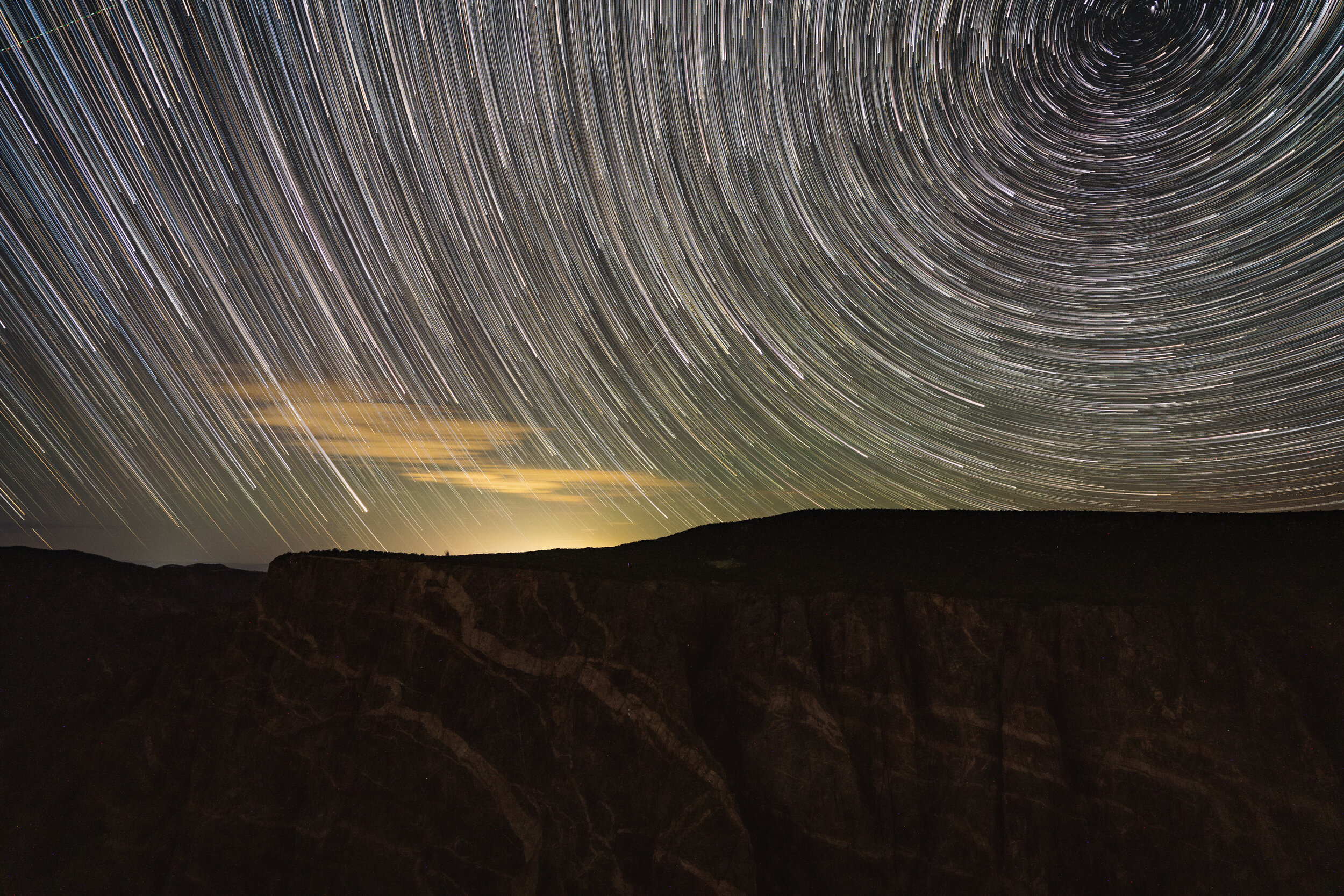
I’ve been thinking about this composition for a while, having sat on the side of the Painted Wall as many times as I have the past few years, and really wanted to see what I could produce.
It was the darkest of dark nights, and walking around for the long hours in the middle of it gave me an even deeper respect for this place.

This composition seemed really difficult, but while waiting for the for the Core to rise above the horizon I decided to walk away from the lake and found a place to sit that is usually packed with tourists using the bus service to reach the lake.
Nights like this a reminder of the gentleness that can exist.
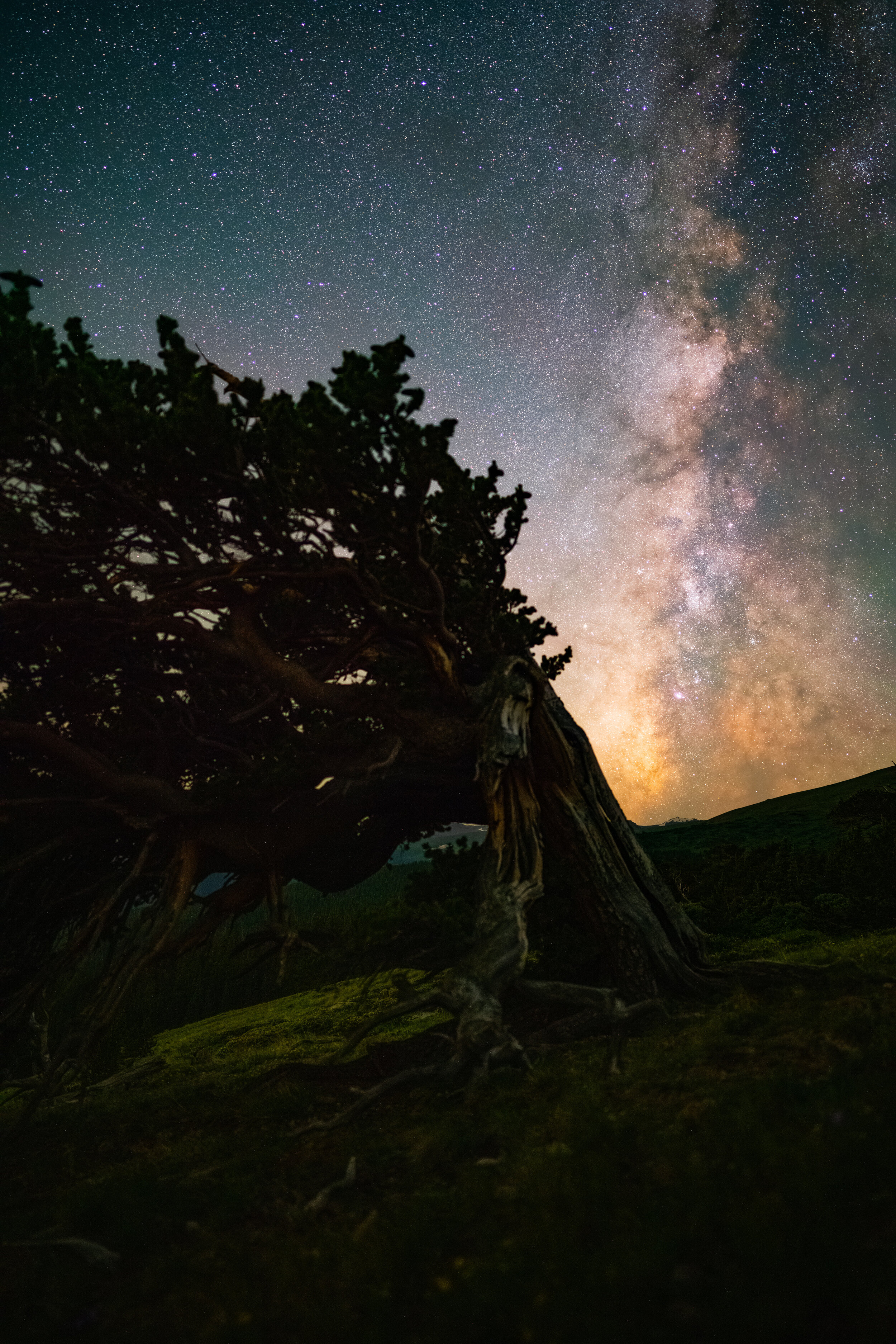
I do spend a lot of nights in the back of my car, it seems to be the only way to effectively travel and capture sunrises and sunsets, and milky shots like this. Unorthodox, yes. Fulfilling, definitely.
Made from 27 light frames by Starry Landscape Stacker 1.8.0. Algorithm: Min Horizon Noise

Maybe I do take too many images… I forgot about this composition… my last night of photographing the fall colors, sleeping under the stars on a hillside above Crested Butte. It has some work still, but I like it, regardless.

These Bristlecones are shaped over their lifetime. It seems apparent especially when you find one with so many branches and so many shoots. To stand tall and weather the conditions for 1,000 years, there has to be some ability to bend.

Cold nights, wind well beyond a real comfort level, frozen fingers, foggy camera lenses… This is what feeling grateful feels like.

tCan’t believe it has been so long since I shot a time-lapse, but I really do like the results of Orion descending in the winter sky.


It’s always shocking just how much a small amount of moisture can disturb a nighttime image. The wind was blowing just enough snow around on the ground to diffract the incoming light, but more difficult to contend with was the mass of clouds over the front range some 70 miles away.
These clouds reflected to urban corridor light of Denver, Boulder and Ft. Collins smothering the bottom edge of the Galactic Core as it rose above the horizon. But, while the vibrancy of the starlight might have been diminished, the intensity of the night seen was not less enjoyable.
North Park, Colorado

This is a stack of images that was used for a time-lapse. This time the trails of the stars are highlighted, and the image was cropped to feature the small farm at night and the lights of Steamboat on the other side of the mountains.

While the clouds were busy obscuring the Galactic Core, the North Star was clear except for a small portion off to the east. The massive snow mound speaks to the wind that blows throw the moutains.

At the very end of window for shooting the core of the Milky Way, the Dark Horse Nebula made an appearance from behind the clouds that had been hiding it all night.
Editing these different compositions seems to be a never ending experiment. Each night offers just some different effect in the color scheme, and trying to bring any sort of uniformity to the final product is somewhat maddening, to the say the least. Maybe I just need to be more selective about when I shoot and what I ultimately edit.

East of Denver the skies get dark pretty quickly. It is only 35 miles to the dark edge of the light pollution, but low lying clouds can conspire, reflecting the ambient light from the metro areas along the Front Range, as well as small communities that dot the Great Plains of Eastern Colorado.
While not the cleanest image, the clouds add to the human element that’s often missing, as to the distant windmills blinking their red beacons in honest admission to their efforts and their obtrusion on the landscape. 50 images taken from a longer time lapse, edited in Lightroom and Photoshop.

I haven't successfully captured the Milky Way any place other than the mountains of Colorado. I was hoping the Eastern Plains would prove fruitful for an early season panorama, and while it this ended a technically clean composition, comprised of 13 different images stacked into two different rows and stitched together, the conditions didn't really favor it.
But, beauty is in the eye of the beholder, and this images does capture the conditions, the setting and the mood rather well. So, the “faint appearance” is the genuine appearance, the shot I was there for.

Jupiter rising up over the eastern horizon…

There’s very little air traffic right now, so the skies are remaining remarkably clear. Finally had a cloudless night, too, so exposure balance and overall composition and image quality is much more to my liking.
151 images of a wind turbine, shot at 16mm, color graded in Lightroom, stacked in StarStaX.

This dilapidated fence post resides a few miles east of Denver, along a stretch of road that has very little traffic. Finding it was accidental, but it makes a perfect compliment to the 2019 version from the San Luis Valley.

Finding an empty railroad track perfectly situated under the rising galactic core made the night’s adventuring all worthwhile. Capturing the sight was icing on the cake.
50 images shot at 24mm, stacked in Starry Landscape Stacker.

25 Stacked images - 400mm, crop mode, 600mm equivalent.
ISO 800 | F/6.3 | 1/800 sec.
September, 2019

10 Stacked images - 400mm
ISO 200 | F/5.6 | 1/200 sec.
March, 2020

5 Stacked images - 400mm, crop mode equivalent 600mm
ISO 400 | F/5.6 | 1/500 sec.
March, 2020

35 Stacked images - 400mm - crop mode, Clear-Image Zoom, 1200mm equivalent.
ISO 400 | F/11 | 1/640 sec.
March, 2020

2020 Pink Moon setting behind Chief Hosa Mountain
April, 2020
ISO 100 | F/9 | 1/60 sec. - 450mm

My patio has gotten a lot of attention lately. I don’t have a great view to the east, and none whatsoever to the west, but as the moon gets higher in the night sky, it become visible above the neighboring buildings. This has given the chance to shoot more than a few times recently, and practice some new editing techniques. Like a lot of good images, photographs of the moon usual involve multiple frames either stacked, or stitch together to gather the data necessary for a dynamic, and detailed, final image.
It’s a process, like so many things. And, a progress in work.

Squaw Pass Road
April, 2020
ISO 200 | F/5.6 | 1/1250 sec. - 400mm

Juniper Pass
April, 2020
ISO 100 | F/5.6 | 1/800 sec. - 600mm

Now, Andy did you hear about this one? Tell me are you locked in a punch?
This song came out in 1992, the same year that Hurricane Andrew devastated South Florida. Prior to the release of that song, and a month before the hurricane hit Miami, another Andrew made an appearance - MY Andrew. My son…
Andy are you goofing on Elvis? Hey, baby, hey baby, are we losing touch?
April, 2020
ISO 400 | F/5.6 | 1/500 sec. - 400mm

I’ve been working on this style of composition for a couple of seasons now, and it’s an interesting to look back and reflect on how these images have gotten better - both in quality and diversity, through a combination of both technique and equipment.
Regardless, its always beautiful under a starry night…

There isn’t the symmetry to make this a more majestic composition, but it was also a very accidental find while scouting for different views of the Milky Way on the Eastern Plains.
Made up of 6 horizontal images, shot a 16mm and stitched together; but I do like the detail and the colors that came out of otherwise a pretty simple set of photographs.

An early morning moon, driving back from a night of Milky Way compositions.

Deciding to forgo sleep and drive 120 miles in the middle of the night, then walk around for multiple hours alone, finding different compositions and simply stargazing can simultaneously lead the mind to wander, but also provide a calm counterpoint allowing thoughts to sift and distill.
While one element brought about a deeper connection to the immediate circumstance, driving creativity, another element rolling backwards through the decade. I’m not sure if I came to any real conclusion on it all, but I was happy to be outside for part of May 18th, my brother’s birthday. That’s always a good day.
ISO 6400 | F/1.4 | 10 sec. - 24mm
30 images shot at 24mm, stacked in Starry Landscape Stacker, edited in Lightroom and Photoshop.

Not always my wisest choices, hiking out into the dark with a headlamp, a backpack, and a vague idea about the trail, but when the muse grabs ahold it must be honored - maybe that will be my undoing.
ISO 6400 | F/1.4 | 10 sec. - 24mm
30 images shot at 24mm, stacked in Starry Landscape Stacker, edited in Lightroom and Photoshop.

A closer look at the at the Galactic Core - May, 2020
ISO 12800 | F2.8 I 10 secs - 35mm
15 images stacked in Starry Landscape Stacker, processed in Lightroom

Couldn’t believe the fortune of two trips in a row, with weather this clear, and more importantly an abandoned road. I was able to shoot to sets from this location, but further later on the traffic wasn’t as forgiving.
ISO 6400 | F/1.4 | 10 sec. - 24mm
30 images shot at 24mm, stacked in Starry Landscape Stacker, edited in Lightroom and Photoshop.

Still working on this technique, gathering enough images to form the clear arch of the early season Milky Way - this composition is made out two rows of images, 5 on the bottom, 6 on top. There are 5 images in each position, making 55 total images to create the final composition. I’m guessing one more row on top, of 7 sets. So many things to think about with out in the middle of the night.
ISO 12800 | F/2.8 | 10 sec. - 16mm
55 images shot at 16mm, stacked in Starry Landscape Stacker, edited and stitched together in Lightroom and Photoshop.

I always forget how much I enjoy working with these images of the Milky Way Core, and the Dark Horse Nebula. This final image is made up of 120, 2 second exposures captured over about 6 minutes.
The images get a first edit in Lightroom, the are saved and aligned in a second program, Starry Landscape. Once the 120 are stacked into one, more adjustments are done in Lightroom to bring out the vibrancy and then the image is edited in Photoshop to remove distracting stars.
I know this seems counterintuitive, but removing the smaller stars allows for the luminosity, the glow of the nebula to come through.
Besides shooting, the editing can take about an hour if the computer isn’t too bogged down on other tasks. I’ve edited this image start to finish twice today, partly because I wasn’t entirely happy with the first results, and partly because I overlooked one of the steps inadvertently. Definitely happy with the final results, though I missed the mark on the framing that I’d intended initially.
Images captured from Loveland Pass, May 2020.
ISO 12800 | F/1.4 | 2 sec.
120 images at 85mm, stacked in Starry Landscape Stacker, edited in Lightroom and Photoshop

I still don’t have the panorama that I’m hoping for, and probably running out of time this year. The full arch is rising earlier and earlier in the night, meaning it is too “light,” what’s known as Nautical Twilight, and the starts on the northern bow are washed out. But, I think I’ve learned by lesson on framing and image gathering for 24mm.
This final images is made up of 3 rows horizontal images, five images in the bottom, six images in the middle, 7 images in the top. Next time will shoot 7 images for each row. I’ve also learned to be more deliberate about the tripod and the ball-head that the camera attaches to. There’s a lot of data lost because of the asymmetry of the original frames; but I do like the detail and the colors that came out of otherwise a pretty simple set of photographs.
ISO 3200 | F/1.4 | 8 sec. - 24mm
90 images shot at 24mm, stacked in Starry Landscape Stacker, edited and stitched together in Lightroom and Photoshop.

These are especially gratifying images, dark, otherworldly surroundings, the calmest of the calm in the middle of the night, a sense of solitude being away from any real centers of population; there’s just so much about astrophotography that I enjoy and appreciate.
With travel starting to open up, it’s still hard to feel comfortable about being out and around other people, so this kind of situation not only suites my temperament, it suites the situation.
ISO 6400 | F/1.4 | 8 sec. - 24mm
30 images shot at 24mm, stacked in Starry Landscape Stacker, edited in Lightroom and Photoshop.

I feel like Cottonwood Pass is Colorado’s last great pass. It was just recently paved, and even though it is closed for winter months due to avalanche danger and maintenance costs, I’m sure it is faint to become a more and more popular way to access the West Elk mountains.
I’ll continue to work on my panoramic images, especially these Milky Way compositions. Our skies have been holding a lot more moisture than usual, maybe due to a June monsoon system. I’m hoping to get one with less air glow, with colors in the cooler side of the temperature spectrum. This was a simpler set, testing out a new lens. I may have not been as careful with my overlap as usual, but there is very little distortion in the final image.
Cottonwood Pass - June, 2020
ISO 6400 | F/1.8 | 15 sec. - 20mm
30 images shot at 20mm, stacked in Starry Landscape Stacker, edited and stitched together in Lightroom and Photoshop.

Space is fascinating, there’s no real way to deny that. One of the things I’ve most enjoyed on this journey with photography is being able to capture the stars at night in a way I’d never even dreamed possible.
I can distinctly remember an early morning in the Spring of 1970, when my grandfather took my brother and I out in the early morning hours to witness the Bennett Comet. While my child’s memory may not be so clear, it’s an event I appreciate more and more.
16 years later, a college professor invited a group of us out on a cold spring morning to view Halley’s Comet. The weather obscured the first few attempts, but finally we got a break and we were all able to view that amazing sight.
In 1996, the Hale-Bopp Comet appeared in the evening skies. It was so large and distinct that for nights on end we could stand on the sidewalk in our north Denver neighborhood and see the Comet withe our eyes.
This spring there have been two comets, which astronomers had hoped would be visible through the summer months, but both gave way to nature’s greater forces. Then, a third discovery was made, the NEOWISE Comet appeared! This most recent galactic adventurer is visible just before dawn in the northeast skies. It’s best to be away from any strong source of light, but it will be visible to the naked eye regardless.
I got up early this morning and went to one of my favorite sunrise spots, and got to witness with my own eyes my fourth Comet in my lifetime.
ISO 400 | F/1.8 | 1 sec. - Sony FE 135 GM
July, 2020

Viewing comet is a breathtaking sight. Capturing a still image, is a fortunate event. Creating a time-lapse of the comet crossing the heavens, a truly unique experience.


So far, I’ve made four separate trips to shoot the 2020 Comet know as NEOWISE. It has been an early morning event thus far, with the comet making it’s first appearance around 3:30 am. The conditions on the Front Range have been less than ideal, as we have had an excess of ozone and smog which makes viewing the comet a real challenge, while also plaguing the camera’s sense of color. But, if you are to wait until later, when the comet climbs hight in the sky, if becomes smaller, much like the effect of the rising moon, and thus somewhat less dramatic as it is nearly impossible to frame it against any interesting features in order to witness it’s scale.
The comet does begin to move to the evening skies before it starts to leave our solar system, so hoping for some more opportunities to view and capture it.
ISO 800 | F/1.4 | 1.6 sec. - Sony FE 85 GM
30 images stacked in Starry Landscape Stacker, edited in Lightroom and Photoshop
July, 2020

Finding the Milky Way on any night is a treat these days. Years of living in the city leave my longing for the dark, night sky that brings out the most vibrant detail of the Galactic Core. So, to find the Milky Way, on a cloudless night, high in the Rocky Mountains, with a still body of water in front of it is almost too much to ask for?!
I’ve been utilizing Loveland Pass for astrophotography quite a lot this spring and now summer. It is quiet, especially with people not traveling as much, and it is one of the closest locations to get to to find truly dark skies. The added bonus of the small set of lakes to create the nearly perfect mirror for reflecting the night sky is just a really nice added bonus!
ISO 6400 | F/1.8 | 13 sec. - 20mm - Sony SEL 20mm/F1.8G
30 images shot at 20mm, stacked in Starry Landscape Stacker, edited in Lightroom and Photoshop.

In spite of the immediate fascination with C/2020 F3, the Galactic Core still exists. The comet is such an incredible sight, and the presence of it can lead to great leaps in the imagination.
I decided to shoot a time lapse on a recent night our, as I haven’t created one in quite a while. So many beautiful things in the night sky, it’s humbling to see it all.
ISO 6400 | F/2.8| 15 sec.
Time lapse was shot at 16mm at F/2.8 and comprised of 360 total images. with final edits made in Lightroom and Photoshop.


Something to be said about the Milky Way reflecting off of a quiet mountain lake.
ISO 6400 | F/1.8 | 13 sec. - 20mm - Sony SEL 20mm/F1.8G
30 images shot at 20mm, stacked in Starry Landscape Stacker, edited in Lightroom and Photoshop.
July, 2020

There is a real satisfaction in revisiting a location over and over again. As the seasons change the character of the setting can change so much, especially when you add the dynamism of the night sky.
This beautiful Bristlecone, itself over 1,000 years old, has witnessed many night skies, and will undoubtedly witness many, many more.
ISO 6400 | F/1.8 | 13 sec. - 20mm - Sony SEL 20mm/F1.8G
30 images shot at 20mm, stacked in Starry Landscape Stacker, edited in Lightroom and Photoshop.

Interrupted Communication - whenever our communication channels fail, it’s generally a human error, the result of our desire to be heard, even though we may be better off if we’re the ones doing the actual listening. The consequences can be dire at worse, problematic at best.
ISO 6400 | F/1.8 | 13 sec.
30 images shot at 20mm, stacked in Starry Landscape Stacker, edited in Lightroom and Photoshop.

Another view of the favorite tree.
ISO 6400 | F/1.8 | 13 sec.
30 images shot at 20mm, stacked in Starry Landscape Stacker, edited in Lightroom and Photoshop.

Having spent the night before shooting different compositions of the stars, and attempting to capture the comet, I wasn’t as quick to get to my alarm as I should have been. As well, when setting up my camera to capture this set of images, I failed to reset one of the features and inadvertently captured them at 202mm instead of 135.
ISO 1600 /|\ F/1.8 \|/ 1 sec.
135mm - 50 images stacked in Starry Landscape Stacker, edited in Lightroom and Photoshop.

In 1990 the ten-year census was taking place, and as a hungry college student I seized on the opportunity to make a few extra dollars that semester. While most of the canvassing was meant to be walking door-to-door the different city blocks throughout Weld County, the biggest and least densely populated portion of Weld County happened to be the communities of Grover, New Raymer and the like, which surrounded the then Pawnee Grasslands.
Even though this task would add actual time to my day, the thought of getting paid mileage and my hourly to drive out to the grasslands and begin the canvassing process made absolute sense to me; I’d get paid to explore!
While the buttes themselves are no longer the haven of 30 years ago, wind generators and pump-jacks sharing a noisy footing on the landscape, the horizon still bends in that way the demonstrates scale, that our human structures simply can’t. The landscape still says “you may encroach, but you will not be permanent.”
I’ve rarely visited this spot in the intervening time. Though recently Adi and Andrew and I headed out for their engagement photos. And, with C/2020 now inhabiting morning and evening skies, it seemed like a good opportunity to explore the area a bit more.
ISO 1600 /|\ F/1.8 \|/ 1 sec.
135mm - 50 images stacked in Starry Landscape Stacker, edited in Lightroom and Photoshop.


The conditions for capturing the NEOWISE Comet varied so much during it’s trip around Earth. From pre-dawn moments beginning at 3:30am, to great evening spectacles that started around 11:00 pm, trying to shoot a clear, detailed image of the C/2020 F3 was definitely one of the greater challenges I’ve encountered in my brief photographic journey.
This particular image is one of the early morning captures shot in mid-July from close to Denver. The final composition is made up of 50 images shot at 400mm, there is no crop, just the fullest expanse of the comet and its tail to fill up the image frame.
ISO 800 | F/5.6 | 1 sec.
50 images shot at 400mm, stacked in Starry Landscape Stacker, edited in Lightroom and Photoshop.
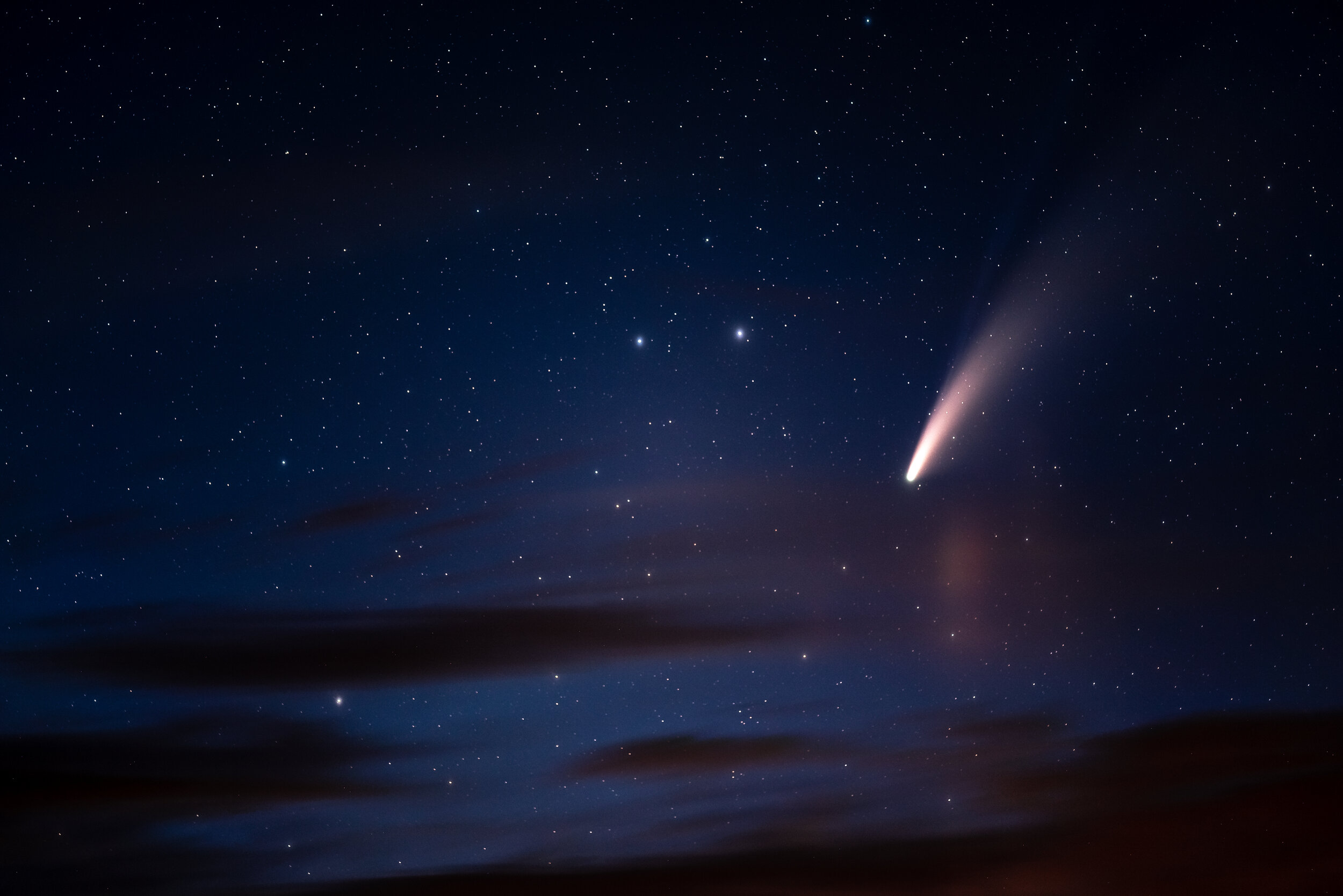
One thing about the comet is really fascinating, it’s caused me to shoot more Blue Hour images in the last two weeks than I think I ever actually have?!
The comet presents itself so differently in all of the different light; it’s hard to not be fascinated by the changing aspects of the light, as well as the different focal lengths.
I have not used a true telephoto lens, 200mm or longer, as that will take utilizing a tracker to get the optimal images. The images captured using a longer focal length have a better chance of capturing the second tail that is becoming more and more vibrant as the spectacle continues. It seems we have a few more days to enjoy it, too.
This was shot on a Friday night, as the last evidence of the day disappeared. I was shooting another time lapse, but the combined images when blended into a movie showed significant flickering again. This was the second incidence with that camera producing an uneven product, so I took a few images to stack as I really like the colors in the final shot. I think I solved the issue of the flickering, too and will test it out tonight.
ISO 1600 /|\ F/1.4 \|/ 1.6 sec.
85mm - 30 images edited in Lightroom, and Photoshop. Made from 30 light frames by Starry Landscape Stacker 1.8.0. Algorithm: Min Horizon Noise

This night was one of the last ones to see the NEOWISE Comet over the Front Range of Colorado. Unfortunately the clouds made conditions along Juniper Pass less than ideal, but to the south the clouds were suspiciously absent.
I haven’t shot over Mt. Evans for a few years, in fact it was one of my earlier sites to shoot the Milky Way, and looking at the progress in the past three season of attempting to shoot the Galactic Core I’m very pleased with the work.
ISO 6400 | F/1.8 | 13 sec.
30 images shot at 20mm, stacked in Starry Landscape Stacker, edited in Lightroom and Photoshop.

Not an overly complicated image, but certainly one that accurately reflects the beauty and stillness of this particular night. I’d been able to prop myself up at close to 13,000 feet in the Rocky Mountains, far, far away from the glare of city lights, so I was able to capture the night sky in a very pure and pristine state.
This is one of my more traditional night sky images, a set of stacked images, 50 in this case, with a star-reduction technique in post-processing to remove the distracting stars, and leave the stars of Ursula Major as the most prominent features along with the comet.
ISO 6400 | F/1.8 | 10 secs. - 20 mm
July, 2020

Nebulosity - The characteristic of being nebulous; cloudiness (measured in octas.)
Admittedly, and selfishly, this is the reason I bought a tracker. I wanted this image. I’ve shot the night sky many dozens of times since taking up photography three years ago. In that collection of nights-capes there are at least a dozen nights where I’ve focused solely on the Dark Horse Nebula, or this, the Rho Ophiuchi.
Each of those previous attempts were stacked compositions, multiple images, between 50 and 90, of one to two seconds and a very high ISO. And those have been good images, I’ve been personally happy with what came out of that nights work.
But this, THIS is a tracked image. This is a single image shot for 140 seconds, at a much lower ISO with the aperture closed down just a bit. This image allows for the nebulosity, the gases around the stars, Antares being the bright yellow off-center, to truly stand out, and show their dimensionality.
This is a first attempt at tracking the Rho, but I’m so satisfied with how it turned out. I’ll certainly make adjustments to my settings the next time, close the aperture a bit to sharpen things up, opening up the shutter to compensate, take three or more images at a time and stack them to see how much cleaner the overall composition can be.
It seems we’ll miss out on NEOWISE departing the solar system, as clouds have been dominating the night sky here. But the next clear night, I’ll point my camera again into the stars and see what beauty lies there.
ISO 800 | F/2.8 | 140 sec.
135mm - single tracked image, edited in Lightroom and Photoshop.

While I won’t go into all of the technical details of this particular image at this point, I’ll simply leave it that this is a “tracked” image, meaning the camera was set to follow the “movement” of the night sky in juxtaposition of the earth. What this would mean normally then is the the blurring of the landscape. So, the camera is stopped from moving and still image is captured of the landscape and the two images are “blended” together using a couple of different pieces of software on the computer.
The biggest benefit of this is a sharper, cleaner, better composed final image, even if it is a bit more work. It also means that more lenses can be used to create completely different scenes of the night sky. In the end, this is my favorite image of the comet, and I can’t believe what a highlight it brought to the night sky, especially in this summer of so many challenges.
ISO 800 | F/2.8 | 140 secs. - 135mm
July, 2020 - Mosquito Pass

One of Colorado’s quieter passes most of the time, this was the route sued my the infamous Father Dyer making treks between the mountain communities of Alma, Buckskin Joe, Fairplay, and Leadville. His treks included not only caring for the miners and families of the community both spiritually and physically, he was also carried the mail and messages between these communities and the outside world.
This is still an active mining region, though the most famous sites, like the North London Mine, and most famous residents, like Father Dyer and “Baby Doe” Tabor are only found in memories and the few monuments to their existence. This stillness in the basis is humbling, and a certain reverence for those who have lived and left their tracks here permeates the night.
ISO 6400 | F/1.8 | 13 sec.
30 images shot at 20mm, stacked in Starry Landscape Stacker, edited in Lightroom and Photoshop.
July, 2020

After some time away from the night sky, it felt so good to be out under the stars last night, shooting for a few hors and then sleeping in the back of the car. Colorado is currently experiencing a rash of late season wildfires, and while the human cost has been low, large swaths of dry forest are burning away.
The smoke from the fires brought out some interesting hues in all the images, and while I’m guessing the results won’t match the clarity of other compositions, it was good to look through the view finder while the coyotes sang and the stars danced.
ISO 6400 | F/1.8 | 13 sec. - 20mm - Sony SEL 20mm/F1.8G
30 images shot at 20mm, stacked in Starry Landscape Stacker, edited in Lightroom and Photoshop.

The Milky Way, vertical in the night sky, marks a distinct change in the season. Occurring towards the end of summer, for me this signals the beginning of the school year, which also means less time for photography. The night’s sky has such an appeal, even with the smoke from the forest fires, the stars are brilliant and offer the peaceful counter-point to the hectic changes taking place.
SO 6400 | F/1.8 | 13 sec. - 20mm - Sony SEL 20mm/F1.8G
30 images shot at 20mm, stacked in Starry Landscape Stacker, edited in Lightroom and Photoshop.

Many of the Bristlecones in this particular grove have lived just over a thousand years. That would mean the sprouted to life when Mesa Verde was on the rise, and southwest agrarians could take advantage of greater than usual rainfall. This rainfall was channeled and reserved for drier times in the year, and crops and population flourished.
A sudden change in the weather patterns ended this wetter period in the southwest, driving populations out of the more concentrated areas, with no real clear understanding of where they went. The author Craig Childs describes this migration in amazing detail in the book “House of Rain,” and while he specifically states he’s not an archeologist, just a mere observer, he offers evidence of migrations that occurred over the previous millennia, with travelers trekking north to south, from the central plateau of what is not northern Mexico, into the Four-Corners regions of the Southwest United States, as seasonal and yearly cycles disrupted life in one area and offered better prospects in another.
Are we in a similar position? Are seeing unprecedented climate events just the warnings we should be looking for? Did this grove only survive because of one climatic shift? Will it fall victim to the fires sprouting up now, that the rains won’t squelch? What foolish folly are we repeating in the time of peril. Certainly our lack of compassion isn’t our only crutch.
SO 6400 | F/1.8 | 13 sec. - 20mm - Sony SEL 20mm/F1.8G
30 images shot at 20mm, stacked in Starry Landscape Stacker, edited in Lightroom and Photoshop.

A “quick overnight trip to Crested Butte,” thats how summer actually began, and that was 12 weeks ago. We’ve finished the second week of school, and will start in-person classes this week.
After dropping off work in Salida, it just made sense to head out for a least a night, and do some shooting, as it’s been a couple of weeks since my last outing, and Labor Day is usually a weekend I’ve stayed close to town, at most spending a day on the motorcycle or bicycle, but generally resting up for the big push through to Thanksgiving. Crested Butte wasn’t my first thought, but knowing I needed to be back in the city for Sunday morning, Crested Butte because the best choice.
Traveling into the mountains in late summer is a different experience; it’s a slower pace, and this year especially a much less congested experience. The colors are different, with the flowers have withered and the Aspen color a few weeks away, but the light can still be quite bright, and depending on the weather, the skies can be much drier. The bright light with the higher contrast helps create dynamic black & white scenes, and the clearer night skies can allow the Milky Way to glow.
So, for 36 hours I framed around the contrasting light and dreamed of the galactic core. A few more cumulus clouds might have added depth to the sky, and using the tracker would have reduced the night sky noise. But, getting to escape, and operate on a different schedule, that’s what was really needed - that’s where the satisfaction would really lie.
A single night, at 12,000 feet, that’s what the mountains offered, and that’s what I would take in.
ISO 6400 | F/1.8 | 13 sec. - 20mm - Sony SEL 20mm/F1.8G
30 images shot at 20mm, stacked in Starry Landscape Stacker, edited in Lightroom and Photoshop.

Heading through Gothic, on the way to Schofield Pass, the East River grows from trickle to a torrent as the many snowfields and springs let loose of their hold of all they’ve stored. By September, the East River is back to a trickle, and the meadows and peaks are yearning for their fresh coat of snow.
This last trip out - I’m still not sure what it means. I know I’ve thoroughly enjoyed this place but really not certain what else it holds.
ISO 6400 | F/1.4 | 10 sec. - 24mm - Sony SEL 24mm/F1.4GM
30 images shot at 24mm, stacked in Starry Landscape Stacker, edited in Lightroom and Photoshop.

Just past the Halloween Full moon, which I missed. I did try to capture it but misjudged it’s alignment as it was rising, so while I didn’t capture the rising moon, it was beautiful to watch and just enjoyable to be outside and take it in.
This was a very pretty moonrise regardless, and it was good to have the cameras out and be looking through the viewfinder.
ISO 400 | F/11 | 1/500 sec. - 560mm - Sony SEL 100-400/F4.5-5.6GM
Single image shot at 400mm with TC 1.4, and the Sony a7riv creating an equivalent 560mm, edited in Lightroom and Photoshop.

Still missing Milky Way season, but planning on getting out to shoot Orion and some of the other deep sky features. Always good to practice from the porch with the longer lens and then patiently edit a batch, while also giving inspiration to what to shoot next.
ISO 200 | F/9 | 1/400 sec. - 560mm - Sony SEL 100-400/F4.5-5.6GM
15 images shot at 400mm with TC 1.4, and the Sony a7riv in crop mode creating an equivalent 840mm, edited in Lightroom and Photoshop.

Its strange to think about the gaps in our lives - they times that we set things down, or make a transition and let something go that has been dear to us before we comfortably pick up the new thing that is rushing towards us.
I haven’t been out to really shoot for nearly three months, but know every time a camera is in my hands, it is what I want to be doing the most. A quick impatient stack of the waxing moon, captured from the alley behind my apartment on November night, in 2020.
ISO 400 | F/11 | 1/400 sec. - 560mm - Sony SEL 100-400/F4.5-5.6GM
15 images shot at 400mm with TC 1.4, and the Sony a7riv in crop mode creating an equivalent 840mm, edited in Lightroom and Photoshop.

Early winter night sky has it’s own features, Orion’s Belt being is an easy one to spot.
The shorter days just means you can take advantage of more night photography options.
An old fence post on the Eastern Plains offers a sense of familiarity to the scene in our every changing world.
ISO 6400 • F/1.4 • 10 sec.
24mm. 30 images edited in Lightroom & Photoshop, stacked in Starry Landscape Stacker.

I don’t usually shoot star trails until the Spring when the skies are the clearest, but when the Muse arrives you have to follow it. The shorter winter days, as we careen towards the Solstice, mean we can take advantage of more night photography opportunities, and this old fence post on the Eastern Plains offers a sense of familiarity in our every changing world.
ISO 800 • F/2.8 • 30 sec. - 150 images @ 16mm

Early winter night sky has it’s own features, Orion’s Belt being is an easy one to spot.
The shorter days just means you can take advantage of more night photography options.
An old fence post on the Eastern Plains offers a sense of familiarity to the scene in our every changing world.
ISO 6400 • F/1.3 • 13 sec.
20mm. 30 images edited in Lightroom & Photoshop, stacked in Starry Landscape Stacker.

Always a treat to spend time under the stars, even more so when the Geminids appear!
The time lapse is made up of approximately 245 images, each 30 seconds long, shot in consecutive order. The alignment is just off as I’d intended the North Star to be positioned at the top of the tree, so much for my impatience.


I’ll write more on this topic later, but for now, Saturn and Jupiter, ending the day.
This composition is the result of 12 vertical images shot left to right, at 135mm. Images were edited and then stitched together in Lightroom. The original file is 145MB, making it ideal for a large panorama or triptych.
ISO 200 | F/1.8 | .4 sec. - Sony FE 135 GM
December, 2020

I thought I was early enough to capture the setting nebula, but the show was brilliant enough without it.


Watching the Milky Way Dance on top of Mt. Evans - July, 2020


Truly one of the most spectacular site of the year. Capturing a set of still images to compile into a time-lapse just added to the magic of it.


These “shoulder seasons,” the ones that aren’t quite winter and aren’t quite spring - for astrophotographers it is late October through February, we can’t see the core of the Milky Way, but other objects and constellations are visible. So different compositions get attention, different skills get practiced.


I genuine dilemma when you capture and process too many Milky Way compositions and then forget about some of your favorites altogether. This one, late June night on top of Cottonwood Pass resulted in hundreds of images. All were edited and some posted on various social media platforms, but for some reason they didn’t make it to my webpage. Well, at least this one is rectified.
ISO 6400 | F/1.8 | 13 sec. - 20mm - Sony SEL 20mm/F1.8G
30 images shot at 20mm, stacked in Starry Landscape Stacker, edited in Lightroom and Photoshop.
Cottonwood and the Dark Horse

While I’d set out to gather a few different night sky composition, I didn’t realize just how challenging it would all be. The first location along Ute Pass was too late in the sky for a proper sequence. The second, though a promising composition, was hindered more by traffic lights than I’d anticipated, and by exposure settings that just didn’t work for the shot. Fortunately as there was still time in the night sky to shoot one more sequence.
Driving west up onto the Pass, I stopped to scout different shots. Getting to the western side of the Pass I found this composition - a large snow field, surrounded by pine trees, with the top of a high ridge off in the distance, but best of all, the North Star was clearly visible high in the sky above the whole setting.
The challenge was that this spot is right along the road, with no real shoulder to safely park in. This would mean parking a distance away, and then standing next to the camera while it recorded the scene, 500 frames in total, or leaving the camera setting by itself on a cold winter night, along the highway, a lone witness to the traversing night sky. With pretty significant trepidation, I chose the latter option. I was able to use better settings on the camera, traffic offered a grateful respite, and I even found time to catch up on a little sleep.

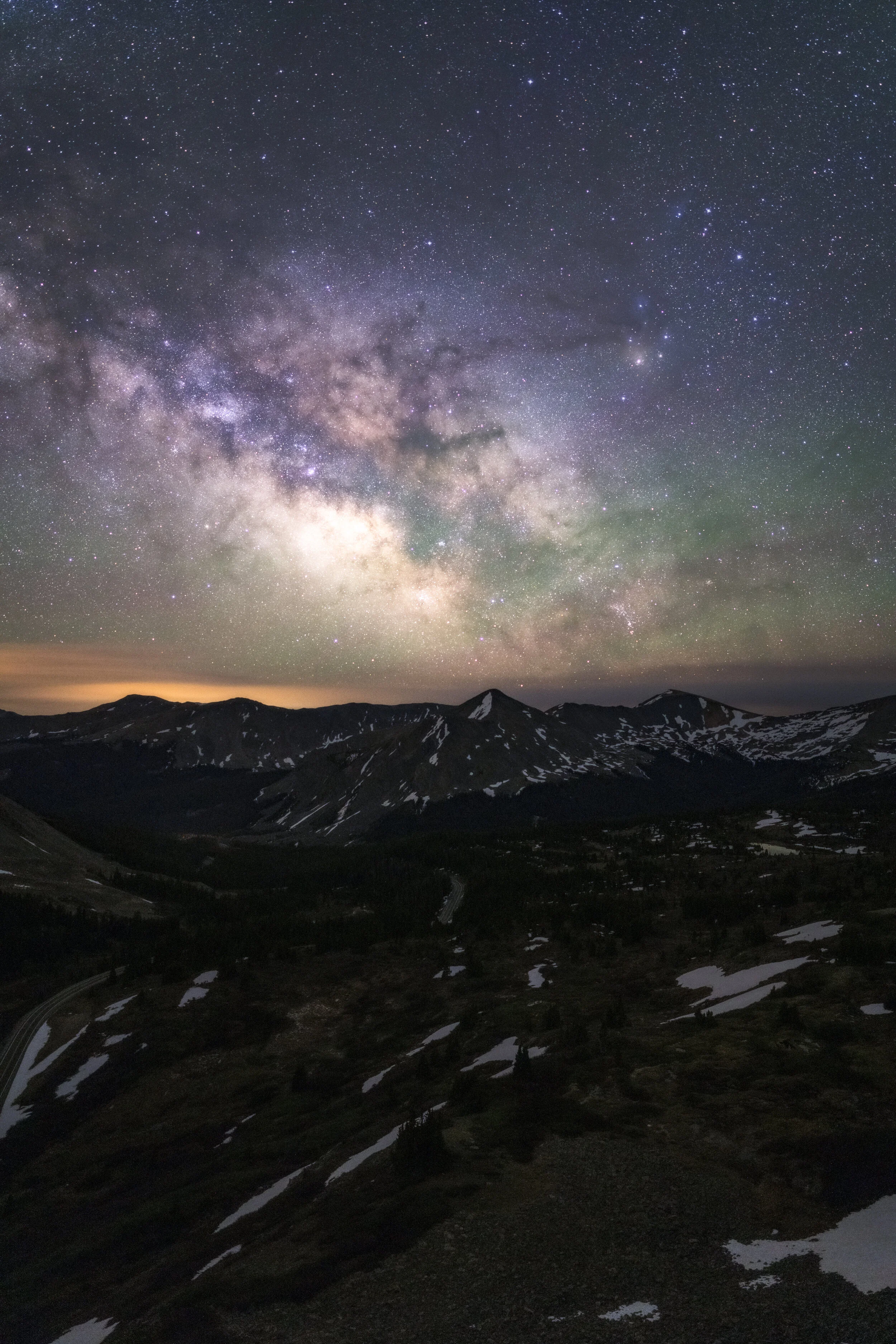
ISO 6400 | F/1.4 | 10 sec. - 24mm - Sony SEL 24GM
5 images shot at 24mm, stacked in Starry Landscape Stacker, edited in Lightroom and Photoshop.
A corner of the a panoramic image. Made from 5 light frames by Starry Landscape Stacker 1.8.0. Algorithm: Min Horizon Noise
Cottonwood and the Dark Horse

The Galactic Core is a breathtaking sight. The four months out the year that we don’t see it there are many other objects, but this is the composition I think about the most. Hoping this is the first of many nights under the stars in the next few months.
Galactic Host - ISO 6400 | F/1.4 | 10 sec. - Sony a7riii - Sony FE 24GM
35 Images - Stacked in Starry Landscape Stacker, and edited in Lightroom and Photoshop - 35MB image

Panoramas are challenging to capture. Add in the complexity of astrophotography, which involves challenges around settings and conditions, creating a worthy final image can have many more hurtles.
While not an overly compelling composition, this stand of young Aspen shoots, silhouetted on the high prairie of central Colorado under the arch of the Milky Way demonstrates that patience can be rewarded, and good technique can provide a beautiful piece of work.
This composition is the result of 45 vertical images shot left to right, at 24mm. Images were edited and then stitched together in Lightroom. The original file is 77MB, making it ideal for a large panorama or triptych.
ISO 6400 | F/1.4 | 5 sec. - Sony FE 24GM
April, 2021

Taking in the galactic core in early April, 2021 on the high plains of Colorado. Hoping this is the first of many nights under the stars in the next few months.
Galactic Host - ISO 6400 | F/1.4 | 10 sec. - Sony a7riii - Sony FE 24GM
35 Images - Stacked in Starry Landscape Stacker, and edited in Lightroom and Photoshop - 35MB image

It seems the night sky has been unusually elusive this year. But finding a single clear night sky can make up for any number of missed opportunities. Getting to explore Colorado's lesser known, empty spaces, seeing some for the first time, punctuated this particular night. This was a new spot, and can't wait to see more of this place.
700 images shot with Sony a7riii and Sony FE 24GM. Edited in Lightroom and rendered in Photoshop
April, 2021 - Salida, Colorado


Light pollution, wind turbines, gleaming iron rails - all under the brilliant glow of the Galactic Core. The Dark Horse and Rho Ophiuchi stand out in the new season core as it tracks across the night sky.
ISO 6400 | F/1.4 | 8 sec. - Sony a7riii - Sony FE 24GM
35 Images - Stacked in Starry Landscape Stacker, and edited in Lightroom and Photoshop - 35MB image
April, 2021

Truly dark skies are more than an hour out of the metro area, and they can be found west or east of the city. Last spring I started to explore these areas of east of town, with railroad tracks, wind turbans, and derelict fence posts.
This night under the stars, with remnants of the most recent snow storm still on the ground, offered incredibly clear skies and the solitude of the Great Plains.
515 images shot with Sony a7riii and Sony FE 24GM. Edited in Lightroom and rendered in Photoshop
April, 2021 - Limon, Colorado


The second night out for dedicated astrophotography and the location did not disappoint. Blurry stars and weather-worn fences compliment each other to tell a story that we won’t know the ending for.
ISO 6400 | F/1.4 | 8 sec. - Sony a7riii - Sony FE 24GM
35 Images - Stacked in Starry Landscape Stacker, and edited in Lightroom and Photoshop - 35MB image
April, 2021 - Cedar Point - Fences I

The second night out for dedicated astrophotography and the location did not disappoint. Blurry stars and weather-worn fences compliment each other to tell a story that we won’t know the ending for.
ISO 6400 | F/1.4 | 8 sec. - Sony a7riii - Sony FE 24GM
35 Images - Stacked in Starry Landscape Stacker, and edited in Lightroom and Photoshop - 35MB image
April, 2021 - Cedar Point - Fences II

The second night out for dedicated astrophotography and the location did not disappoint. Blurry stars and weather-worn fences compliment each other to tell a story that we won’t know the ending for.
ISO 6400 | F/1.4 | 8 sec. - Sony a7riii - Sony FE 24GM
35 Images - Stacked in Starry Landscape Stacker, and edited in Lightroom and Photoshop - 35MB image
April, 2021 - Cedar Point - Fences III

The second night out for dedicated astrophotography and the location did not disappoint. Clear skies, the Dark Horse Nebula and weather-worn fences compliment each other to tell a story that we won’t know the ending for.
ISO 6400 | F/1.4 | 8 sec. - Sony a7riii - Sony FE 24GM
35 Images - Stacked in Starry Landscape Stacker, and edited in Lightroom and Photoshop - 35MB image
April, 2021 - Cedar Point - Fences IV

Nebulosity - The characteristic of being nebulous; cloudiness (measured in octas.)
I’ve shot the night sky many dozens of times since taking up photography four years ago. In that collection of nights-capes there are at least a dozen nights where I’ve focused solely on the Dark Horse Nebula, or this, the Rho Ophiuchi. The luminosity that is present in the nebula is one of my favorite night sky features, and while it is both a challenge to capture and edit, I always enjoy to opportunity use a creative license to produce a final composition.
Antares dominates the scene with its yellow shade and the dominant gas clouds around its center provide a unique glow on a clear night.
Images captured over Cedar Point, April 2021.
ISO 6400 | F/1.8 | 1.6 sec.
75 images at 135mm, stacked in Starry Landscape Stacker, edited in Lightroom and Photoshop

The second night out for dedicated astrophotography and the location did not disappoint. Clear skies, the Dark Horse Nebula and weather-worn fences compliment each other to tell a story that we won’t know the ending for.
ISO 6400 | F/1.4 | 8 sec. - Sony a7riii - Sony FE 24GM
35 Images - Stacked in Starry Landscape Stacker, and edited in Lightroom and Photoshop - 35MB image
April, 2021 - Cedar Point - Fences V

The “super-moons” haven’t been as prolific as last year, in fact this is actually the first one we’ve had. With COVID restrictions lifted I was able to get to a rooftop finally and didn’t need to make a mad dash up the mountain before going into work like last year.
The weather gave a least a little bit of a break this morning, but the moonrises have been clouded over and I think that was the best opportunity for a moon over Mt. Evans.
April, 2021
ISO 200 | F/6.3 | 1/500 sec. - 900mm
Sony a7riv & Sony FE 200-600G - shot at 600mm in aps-c mode for 900mm effective focal length.

The “super-moons” haven’t been as prolific as last year, in fact this is actually the first one we’ve had. With COVID restrictions lifted I was able to get to a rooftop finally and didn’t need to make a mad dash up the mountain before going into work like last year.
The weather gave a least a little bit of a break this morning, but the moonrises have been clouded over and I think that was the best opportunity for a moon over Mt. Evans.
April, 2021
ISO 200 | F/6.3 | 1/500 sec. - 600mm
Sony a7riv & Sony FE 200-600G

The “super-moons” haven’t been as prolific as last year, in fact this is actually the first one we’ve had. With COVID restrictions lifted I was able to get to a rooftop finally and didn’t need to make a mad dash up the mountain before going into work like last year.
The weather gave a least a little bit of a break this morning, but the moonrises have been clouded over and I think that was the best opportunity for a moon over Mt. Evans.
April, 2021
ISO 200 | F/6.3 | 1/500 sec. - 600mm
Sony a7riv & Sony FE 200-600G

The third night out for dedicated astrophotography and it was a chance to return to one of my favorite locations and it did not disappoint. The clear skies, and the Dark Horse Nebula over a blanket of high-alpine snow made for some compelling composition both above tree-line and while nestled in the Bristlecone.
ISO 6400 | F/1.4 | 8 sec. - Sony a7riii - Sony FE 24GM
35 Images - Stacked in Starry Landscape Stacker, and edited in Lightroom and Photoshop - 35MB image
May, 2021 - South Park Colorado - Dark Horse I

The third night out for dedicated astrophotography and it was a chance to return to one of my favorite locations and it did not disappoint. The clear skies, and the Dark Horse Nebula over a blanket of high-alpine snow made for some compelling composition both above tree-line and while nestled in the Bristlecone.
ISO 6400 | F/1.4 | 8 sec. - Sony a7riii - Sony FE 24GM
35 Images - Stacked in Starry Landscape Stacker, and edited in Lightroom and Photoshop - 35MB image
May, 2021 - South Park Colorado - Dark Horse II

The third night out for dedicated astrophotography and it was a chance to return to one of my favorite locations and it did not disappoint. The clear skies, and the Dark Horse Nebula over a blanket of high-alpine snow made for some compelling composition both above tree-line and while nestled in the Bristlecone.
ISO 6400 | F/1.4 | 8 sec. - Sony a7riii - Sony FE 24GM
35 Images - Stacked in Starry Landscape Stacker, and edited in Lightroom and Photoshop - 35MB image
May, 2021 - South Park Colorado - Dark Horse III

A slow start to the Milky Way season, but any clear night out under the star is well worth the effort. One of the first compositions of the night, shot while letting the time-lapse run on the ridge in the foreground and the core of the Milky Way just beginning to climb over the Cupid, Grizzly and Arapahoe. The bright light on the right edge of the frame was the back of the other camera, shooting the 680-image sequence that we be used to create the time-lapse.
ISO 6400 | F/1.4 | 8 sec. - Sony a7riii - Sony FE 24GM
25 Images - Stacked in Starry Landscape Stacker, and edited in Lightroom and Photoshop - 35MB image
May, 2021 - Loveland Pass Colorado - Milky Way II

Shooting the early season galactic core is a problematic proposition, weather can either make or break the result. Usually, Loveland Pass is shot from the east, with photographers climbing the ridge of Cupids Peak in order to gain the vantage point over the basin. I decided to take on the western ridges for this night. The early portion is a marked trail, but it quickly dissolves into snow back and mud while climbing to 13,000 feet.
This all started with a boot-pack straight up the face of the ridge, and turned into a hike along frozen tundra and the wind-swept slope. I placed the time-lapse camera a little lower than I'd originally hoped, but the climbing and descending, and then climbing to retrieve it was of so rewarding as the Milky Way arched across the night sky on the ridge of the Continental Divide, under a moonless night. There's no question that life continues well into the dark, whether we want to witness it is the real question.
680 images edited in Lightroom and rendered in Photoshop
Sony a7iii - Sony FE 20G
May, 2021 - Colorado
Loveland Pass Milky Way Time-lapse - Sony a7iii & Sony FE 20G


A slow start to the Milky Way season, but any clear night out under the star is well worth the effort. This compositions came towards the middle of the night, shot while letting the time-lapse run on the ridge below, as I decided to climb up the ridge that night, hoping to gain a more dynamic perspective on an otherwise quiet night. A few shooting stars passed across the sky, but none bright enough to be recorded by the camera.
ISO 6400 | F/1.4 | 8 sec. - Sony a7riii - Sony FE 24GM
25 Images - Stacked in Starry Landscape Stacker, and edited in Lightroom and Photoshop - 35MB image
May, 2021 - Loveland Pass Colorado - Milky Way II

A slow start to the Milky Way season, but any clear night out under the star is well worth the effort. One of the last compositions of the night, similar to shots from last year, but the night sky held onto some different hues, though just as inspiring as ever.
ISO 6400 | F/1.4 | 8 sec. - Sony a7riii - Sony FE 24GM
25 Images - Stacked in Starry Landscape Stacker, and edited in Lightroom and Photoshop - 35MB image
May, 2021 - Loveland Pass Colorado - Milky Way IV

My fourth full night out for astrophotography felt different then the previous three. We celebrated graduation for our seniors this week, which is always a humbling experience. Working with adults who for whatever reason did not graduate as planned, and hearing their inspirations and motivations for finally returning to complete this last step always draws perspective on our own circumstances - I walk away from these events filled with gratitude.
Maybe this is why I was a bit more motivated this night, climbing much higher on the western ridge of the pass than I have previously. I haven’t been in as good of physical condition recently as I have in the past, but I am healthy, and I don’t want to fall into the habit of making excuses. So, I pushed. Then benefit of nighttime in the mountains is the snow that remains will refreeze, making for a firmer, more stable surface to hike on.
Another motivation this particular night was that I wasn’t alone. There was a group parked at the top of the pass and the seemed to be in pursuit of the same objectives of capturing the night sky. As well, there was plenty of traffic over the pass and the night crew was out grooming the local sky area, the snow-cats lighting the mountain and basin as they coordinated their moves during the night.
A total of 50 images were used to create the panorama - images were shot in a single row made up of 10 frames, each frame made up of 5 photos to reduce noise. Final images size is close to 90MB. Images were batch edited in Lightroom, then stacked in Starry Landscape Stacker. Final edits were made both in Photoshop and Lightroom.
ISO 6400 | F/1.4 | 8 sec. - 24mm - Sony a7iii & Sony FE 24GM - 50 images stacked and stitched together to create this Milky Way Panorama.
May, 2021 - As always, thank you for the support and for joining me on this adventure.

Shooting the waxing moon, high above the Mile High City.
Single image of the Waxing Moon, mid May, 2021
ISO 400 | F/9 | 1/640 sec. at 900mm - Sony a7iii & Sony FE 200-600G

Really a challenge to capture, especially as the with clouds that would prefer to obscure the whole event. I checked conditions a couple of times during the night, finally getting up at 4:30 to see if there was any chance of seeing the lunar eclipse. This was one of the earlier shots in the series, captured just as the clouds to clear, but leaving a mysterious veil over the moon as the earth start to position itself between the two.
Pretty fascinating to see the faint stars stretched out the right in conjunction with the full moon.
Single image of the Waxing Moon, mid May, 2021
ISO 400 | F/6.3 | .6 sec. at 600 mm - Sony a7iii & Sony FE 200-600G

The moon is just hard to shoot. Whether as a still image, stacked or tracked, and even in a time-lapse like this, they are all just challenging to capture, period.
Looking forward to the May Super Moon - Lunar Eclipse, it felt good to be practicing the with the composition and technique, and fortunately to be able to capture a substantial sequence of images like this. When the lunar eclipse did arrive the next day, so did the clouds. I was able to capture a number of still images, but not a set of images like this.
540 images edited in Lightroom and rendered in Photoshop
Sony a7iii - Sony FE 135GM
May, 2021 - Denver, Colorado
Denver (Pre) Super Moon - Sony a7riii & Sony FE 135GM


Really a challenge to capture, especially as the with clouds that would prefer to obscure the whole event. I checked conditions a couple of times during the night, finally getting up at 4:30 to see if there was any chance of seeing the lunar eclipse. This ended up as the best shot of the night, when the clouds gave way for about five minutes, before coming in to cancel the whole show.
Single image of the Waxing Moon, mid May, 2021
ISO 800 | F/9 | .6 sec. at 1260 mm - Sony a7riii & Sony FE 200-600G, 1.4TC

A quick trip to the mountains to do some work necessitated an overnight stay. I headed up early to capture the Milky Way one night in one location, and was rewarded with a second night in another.
ISO 6400 | F/1.8 | 13 sec. - Sony a7riii - Sony FE 14GM
20 Images - Stacked in Starry Landscape Stacker, and edited in Lightroom and Photoshop - 35MB image
June, 2021 - Loveland Pass Colorado - 14mm

With June arriving in a mix of rain and heat, it's hard to say what the conditions will be like up in the High Country. Of course the wildflowers need these two elements to crawl out of their winter hibernation, but shooting the stars at night can be a challenge with humidity reducing the star's clarity, and the warmth effecting the camera's sensor.
With a couple of days of work set aside in Alma, I decided to head back to a know spot and add some more footage to an already lengthy night-time video. The sky remained clear on the south side of the pass, and the wind only blew in a few small bursts. Traffic was much heavier that previous nights, which is pretty evident over the course of the three hours of shooting.
720 images edited in Lightroom and rendered in Photoshop
Sony a7iii - Sony FE 20G
June, 2021 - Colorado
Loveland Pass Milky Way Time-lapse - Sony a7iii & Sony FE 20G


A quick trip to the mountains to do some work necessitated an overnight stay. I headed up early to capture the Milky Way one night in one location, and was rewarded with a second night in another.
ISO 6400 | F/1.8 | 10 sec. - Sony a7iiii - Sony FE 20G
20 Images - Stacked in Starry Landscape Stacker, and edited in Lightroom and Photoshop - 35MB image
June, 2021 - Loveland Pass Colorado - 20mm

Normally there is a very complicated editing process involved when creating star-trail images such as this. The usual process of capturing 200 to 300 images and then editing each and adding them into either Photoshop or a different stacking program can take up to, and often times over, an hour. But this is a single image, photographed for just about 45 minutes.
The difference in the two techniques for capturing start-trails boils down to taking multiple images or a single image - in the case of multiple images you can have a few bad images but still end up with a beautiful final image, but with much more work. The single image is more susceptible to anomalies in the frame, but also a bump or shaky tripod that can ruin everything.
In either case the image should be made over multiple hours, as the Earth spins only about 15 degrees each hour, revealing relatively short star trails like this image. But, this was a first attempt and there will be many more after this.
ISO 320 | F/5.6 | 2405 sec. approximately 45 minutes - at 14mm
Sony a7riii, Sony FE 14GM - June, 2021

A quick trip to the mountains to do some work necessitated an overnight stay. I headed up early to capture the Milky Way one night in one location, and was rewarded with a second night in another.
ISO 6400 | F/2.5 | 5.5 sec. - Sony a7iii - Sony FE 50G
25 Images - Stacked in Starry Landscape Stacker, and edited in Lightroom and Photoshop - 35MB image
June, 2021 - Loveland Pass Colorado - 50mm

A quick trip to the mountains to do some work necessitated an overnight stay. I headed up early to capture the Milky Way one night in one location, and was rewarded with a second night in another.
ISO 6400 | F/1.8 | 13 sec. - Sony a7riii - Sony FE 14GM
20 Images - Stacked in Starry Landscape Stacker, and edited in Lightroom and Photoshop - 35MB image
June, 2021 - Loveland Pass Milky Road - 14mm

A quick trip to the mountains to do some work necessitated an overnight stay. I headed up early to capture the Milky Way one night in one location, and was rewarded with a second night in another.
ISO 6400 | F/1.8 | 10 sec. - Sony a7iiii - Sony FE 20G
20 Images - Stacked in Starry Landscape Stacker, and edited in Lightroom and Photoshop - 35MB image
June, 2021 - Windy Ridge - 20mm

A quick trip to the mountains to do some work necessitated an overnight stay. I headed up early to capture the Milky Way one night in one location, and was rewarded with a second night in another.
ISO 6400 | F/1.8 | 10 sec. - Sony a7iiii - Sony FE 20G
20 Images - Stacked in Starry Landscape Stacker, and edited in Lightroom and Photoshop - 35MB image
June, 2021 - Time Travelers - 20mm

A quick trip to the mountains to do some work necessitated an overnight stay. I headed up early to capture the Milky Way one night in one location, and was rewarded with a second night in another.
ISO 6400 | F/1.8 | 13 sec. - Sony a7riii - Sony FE 14GM
20 Images - Stacked in Starry Landscape Stacker, and edited in Lightroom and Photoshop - 35MB image
June, 2021 - Windy Ridge - 14mm

Not quite as perfect a placement as Loveland Pass, the North Star sits a little too far to the west here. But the overnight traffic from Hoosier Pass, and the residence below add to the effect of movement during the night in the 2 hour long exposure.
ISO 320 | F/7.1 | 6,265 sec. approximately 145 minutes - at 16mm
Sony a7riv w/ Sony FE 1635GM
June, 2021 - North Star - Hoosier Pass

A quick trip to the mountains to do some work necessitated an overnight stay. I headed up early to capture the Milky Way one night in one location, and was rewarded with a second night in another.
ISO 6400 | F/1.8 | 13 sec. - Sony a7riii - Sony FE 14GM
20 Images - Stacked in Starry Landscape Stacker, and edited in Lightroom and Photoshop - 35MB image
June, 2021 - Galactic Reflections - 14mm

A quick trip to the mountains to do some work necessitated an overnight stay. I headed up early to capture the Milky Way one night in one location, and was rewarded with a second night in another.
ISO 6400 | F/1.8 | 13 sec. - Sony a7riii - Sony FE 14GM
20 Images - Stacked in Starry Landscape Stacker, and edited in Lightroom and Photoshop - 35MB image
June, 2021 - Words Fail You - 14mm

A quick trip to the mountains to do some work necessitated an overnight stay. I headed up early to capture the Milky Way one night in one location, and was rewarded with a second night in another.
ISO 6400 | F/1.8 | 13 sec. - Sony a7iii - Sony FE 14GM
20 Images - Stacked in Starry Landscape Stacker, and edited in Lightroom and Photoshop - 35MB image
June, 2021 - Como Overlook - 14mm

A quick trip to the mountains to do some work necessitated an overnight stay. I headed up early to capture the Milky Way one night in one location, and was rewarded with a third night in another.
This time I wanted to isolate the Dark Horse Nebula and the Rho Ophiuchi cluster, as well I wanted to practice with the star tracker some more.
ISO 320 | F/4 | 368 sec. approx. 6 minutes - Sony a7riv w/ Sony FE 50G
Single Tracked Image - Shot use the Move Shoot Move tracker, 6 minute exposure for the sky, edited in Lightroom and Photoshop - 65MB image
June, 2021 - Como Overlook - Dark Horse Nebular - 50mm

A quick trip to the mountains to do some work necessitated an overnight stay. I headed up early to capture the Milky Way one night in one location, and was rewarded with a second night in another.
ISO 800 | F/5.6 | 374 sec. - Sony a7iii - Sony FE 14GM
Single Tracked Image - Shot use the Move Shoot Move tracker, 6 minute exposure for the sky, six minute exposure for the foreground, blended in Photoshop, edited in Lightroom and Photoshop - 35MB image
June, 2021 - Como Overlook - 14mm

A quick trip to the San Juans to look at the early season Lupine lead me to a favorite overlook and a chance to shoot the Milky Way on a clear night.
The Lupine and Mule Ears are in abundance right now, and hopefully the rain returns to nourish them through after this round of intense heat. Campers at the base of the road we up into the late hours, as the camp fire at the center of the frame would attest.
ISO 6400 | F/1.8 | 13 sec. - Sony a7iii - Sony FE 14GM
20 Images - Stacked in Starry Landscape Stacker, and edited in Lightroom and Photoshop - 35MB image
June, 2021 - Last Dollar Road - 14mm

With summer well on its way and a trip to visit family in Northern Michigan planned, I knew that I wanted to take advantage of the many photographic opportunities that Michigan provides. I love the mountains of Colorado that are now my home, but the water just brings out so many opportunities.
Even though the skies aren’t nearly as dark in the Midwest, there are so many amazing nightscapes to be inspired by, especially Mary Beth Kiczenski aka @ShelbyDiamondstar on Instagram. If you don’t follow her work, you really should give it a look, she really does create on a whole-nother level.
I didn’t bring my tracker for this trip, and while heading back across the Straits I asked my mom, whose birthday I am home to celebrate, if she could spare a few minutes on our trip North. While the glow of the galactic core and the Dark Horse aren’t as intense as I’d like them to be, the conditions were perfect and the final composition is pretty amazing.
ISO 3200 | F/1.4 | 8 sec. - 20 images edited in Lightroom and Photoshop, stacked in Starry Nightscape Stacker - final image cropped to 35mm equivalent focal length.
Sony a7riii w/ Sony FE 24GM

This wasn’t the best dark-sky location, with its neighboring campground, but shooting north over Lake Huron creating an inky-black background to highlight the colors of the circling stars.
One of the things I’ve always appreciated about Michigan is it’s multi-lingual heritage. Unfortunately that heritage is marked by real tragedy, but flipping between French, Ojibwa, Iroquoian and English, as well as subtle incursions of Spanish made be more curious about culture and the stories that tie us together.
This particular lighthouse, just a few miles east of where I spent a lot of my childhood summer’s is a Franco name quit literally meaning “point of little boats.” The name comes to mean that only small boats should come near the cost, as the waters along this section of Lake Huron are very shallow, and that the reef running our more than two miles from the coast would easily wreck the larger sailing boats that made their way along the cost. The light itself is one of the older, active lighthouses in the state, being built in 1848 and finally electrified in 1956.
ISO 800 • F/5.6 • 30 sec. - 245 images @14mm

Back at it - a beautiful trip to Michigan followed by a beautiful night in Colorado enjoying the Summit County charm.
ISO 6400 | F/1.8 | 10 sec. - 20 images edited in Lightroom and Photoshop, stacked in Starry Nightscape Stacker
Sony a7iii w/ Sony FE 20/1.8
Galactic Core Pass Lake - July, 2021

Back at it - a beautiful trip to Michigan followed by a beautiful night in Colorado enjoying the Summit County charm.
ISO 6400 | F/1.4 | 8 sec. - 20 images edited in Lightroom and Photoshop, stacked in Starry Nightscape Stacker
Sony a7riii w/ Sony FE 24/1.4
Galactic Core Pass Lake - July, 2021

Back at it - a beautiful trip to Michigan followed by a beautiful night in Colorado enjoying the Summit County charm.
ISO 320 | F/6.3 | 7260 sec. - single image captured over 2 hours, edited in Lightroom and Photoshop
Sony a7riii w/ Sony FE 14/1.8
Star-trails Pass Lake - July, 2021

Back at it - a beautiful trip to Michigan followed by a beautiful night in Colorado enjoying the Park County charm.
ISO 6400 | F/1.8 | 13 sec. - 20 images edited in Lightroom and Photoshop, stacked in Starry Nightscape Stacker
Sony a7riii w/ Sony FE 20/1.8
Galactic Core Oliver Twist Lake - August, 2021

Back at it - a beautiful trip to Michigan followed by a beautiful night in Colorado enjoying the Park County charm.
ISO 6400 | F/1.8 | 15 sec. - 20 images edited in Lightroom and Photoshop, stacked in Starry Nightscape Stacker
Sony a7iii w/ Sony FE 14/1.8
Galactic Core Mosquito Range - August, 2021

Back at it - a beautiful trip to Michigan followed by a beautiful night in Colorado enjoying the Park County charm.
ISO 6400 | F/1.8 | 15 sec. - 20 images edited in Lightroom and Photoshop, stacked in Starry Nightscape Stacker
Sony a7iii w/ Sony FE 14/1.8
Galactic Core Mosquito Range - August, 2021

When your friends invite out for a weekend in Steamboat, you just have to figure out a way to say, “YES!”
ISO 6400 | F/1.8 | 15 sec. - 20 images edited in Lightroom and Photoshop, stacked in Starry Nightscape Stacker
Sony a7iii w/ Sony FE 14/1.8
Galactic Core over Fletcher’s Barn - August, 2021

Always a joy to head into Wyoming for Labor Day. This year, while still cool, proved to be extremely calm, allowing for some incredible night sky images, this one included. Unfortunately the 3 hour exposure did get produced this night, as an oversight while setting up the photograph let to too wide of an aperture and way too much light reaching the sensor.
ISO 320 | F/8 | 4720 sec. - single image captured over 2 hours, edited in Lightroom and Photoshop
Sony a7riv w/ Sony FE 14/1.8
Star Trails - Mirror Lake - September, 2021

Always a joy to head into Wyoming for Labor Day. This year, while still cool, proved to be extremely calm, allowing for some incredible night sky images, this one included. There was a spot high above the highway and the surrounding landscape that offered not only unique views, but a real sense of solitude under a brilliant night sky.
ISO 6400 | F/1.4 | 8 sec. - 20 images, edited and stacked in Lightroom and Photoshop
Sony a7riii w/ Sony FE 24/1.4
Galactic Core - Marie Lake - September, 2021

Always a joy to head into Wyoming for Labor Day. This year, while still cool, proved to be extremely calm, allowing for some incredible night sky images, this one included.
Mirror Lake was disturbed a bit by the find, but shooting north into the Milky Way offered the a clear view of the Andromeda Galaxy, a first attempt to intentionally photograph this night sky feature
ISO 6400 | F/1.4 | 8 sec. - 20 images, edited and stacked in Lightroom and Photoshop
Sony a7riii w/ Sony FE 24/1.4
Galactic Core - Marie Lake - September, 2021

When your friends invite out for a weekend in Steamboat, you just have to figure out a way to say, “YES!”
ISO 6400 | F/1.8 | 15 sec. - 20 images edited in Lightroom and Photoshop, stacked in Starry Nightscape Stacker
Sony a7iii w/ Sony FE 14/1.8
Elk River Finding Sleep - September, 2021
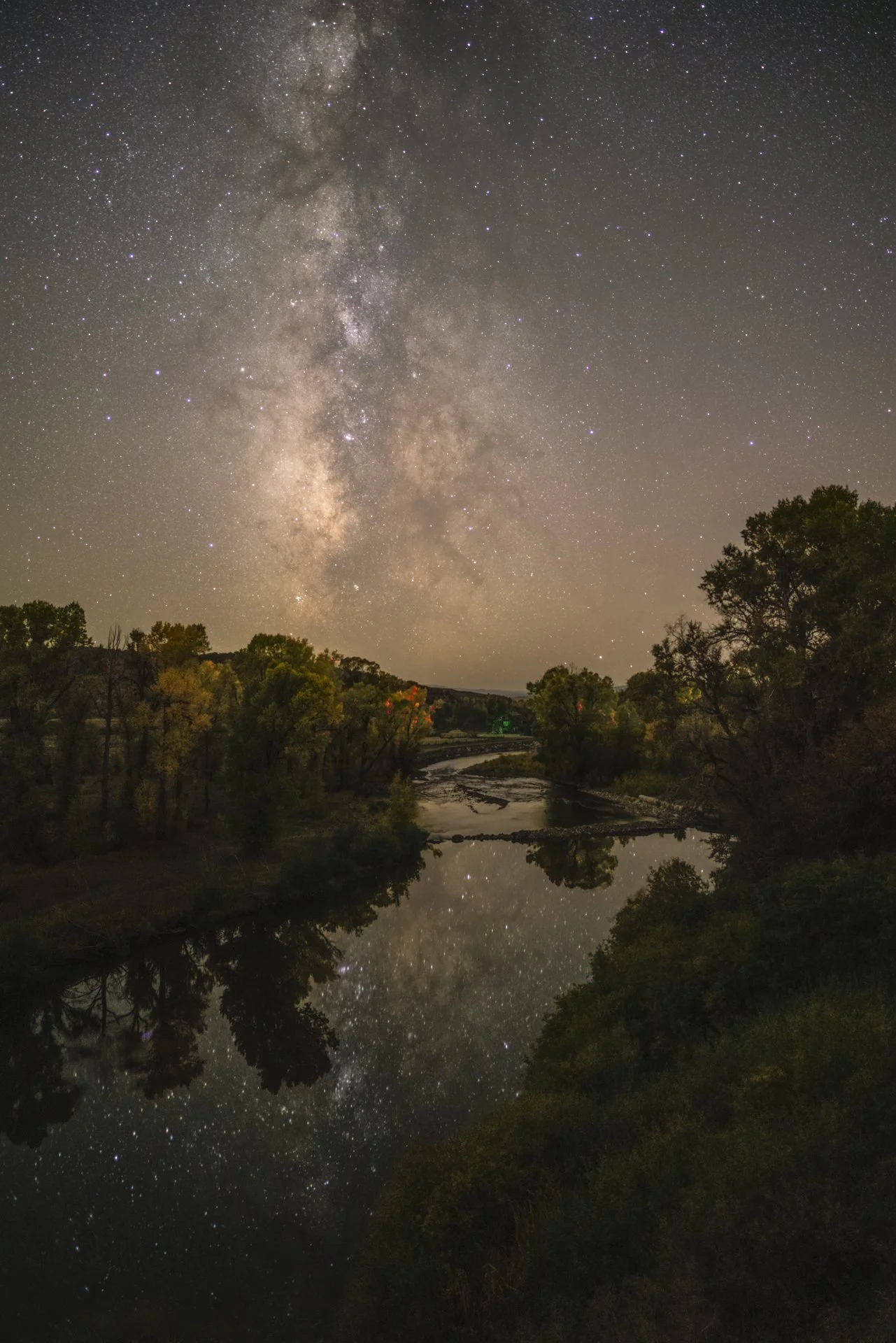
When your friends invite out for a weekend in Steamboat, you just have to figure out a way to say, “YES!”
ISO 6400 | F/1.4 | 8 sec. - 20 images edited in Lightroom and Photoshop, stacked in Starry Nightscape Stacker
Sony a7riii w/ Sony FE 24/1.4
Elk River Finding Sleep - September, 2021

Back to the night skies and longer nights with the end of daylight savings and with the Solstice just seven weeks away. Ice has covered about 1/3 of Echo Lake, and I'm sure it will be completely covered before the week is out.
The sky remained mostly clear, with the thin, cirrus clouds picking up the light from Denver to the east. Venus is now aligned with the center of the Galactic Core, and the glow off of the ice and water made for a stunning effect. Traffic wasn't too heavy, but the flights coming out of Denver kept the sky interesting over the course of the two hours of shooting.
Looking forward to the new Sony a7iv, though the Nikon Z6ii and Z7ii have some compelling features for time time-lapse and night photography. If you have any experience with those, drop a comment below.
505 images edited in Lightroom and rendered in Photoshop
November, 2021 - Colorado
Echo Lake & Venus Time-lapse - Sony a7iii & Sony FE 20G

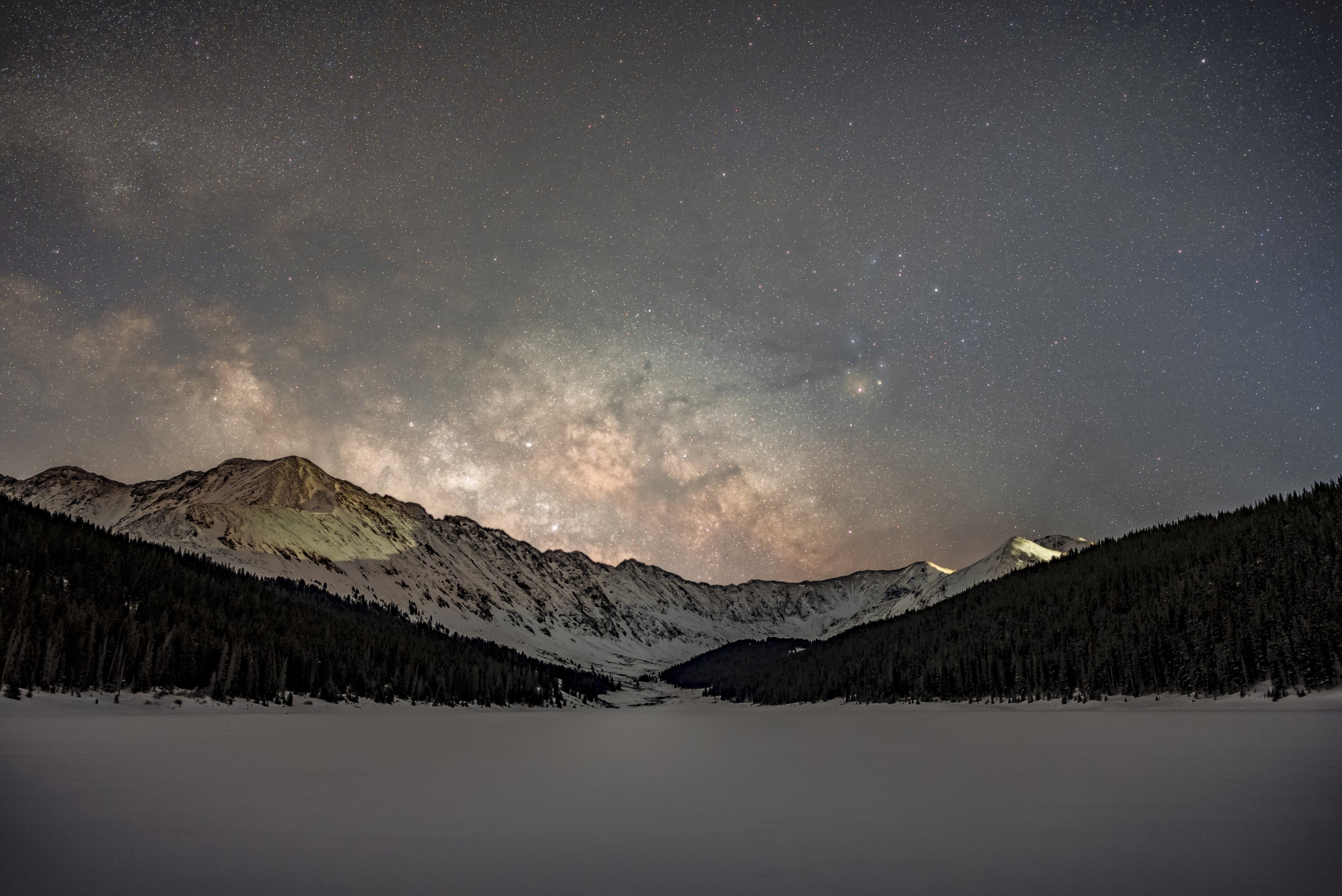
Early season Milky Way - a joyfully cold overnight stay high in the Rockies, piling out a warm car just before dawn to capture the rising Galactic Core the Continental Divide.
ISO 6400 | F/1.4 | 8 sec. - 20 images edited in Lightroom and Photoshop, stacked in Starry Nightscape Stacker
Sony a7siii w/ Sony FE 24/1.4
February, 2022

March went by much faster than I expected, and while drone flights were more common than photography sessions, the highlights for March included some absolutely incredible sunrises, the Worm Moon setting over the Continental Divide and the reemergence of the Milky Way made the lack of sleep and the cold conditions worthwhile
Hoping to get more stargazing soon, as well as drone images, both fulfill different creative outlets; staring up at the moving celestial bodies, or hanging out with a birds-eye view of the Rocky Mountains just can't be beat.
All images capture on the Sony a7siii with a combination of lenses, included the Sony FE100-400GM, Sony FE24-105G, Sony FE50G, Sony FE35GM, and Sony FE24GM. Sunrise and sunset images captured in Aperture Priority at F/8 and auto-ISO. Milky Way captured at ISO 6400, F/1.4 and 8 seconds.


March didn’t seem to offer optimal conditions or optimal timing for astrophotography and that’s just how things work out sometimes. April opened up with better opportunities and as always it’s worth losing a little sleep to watch the stars track across the sky.
ISO 6400 | F/1.4 | 6 sec. - 20 images edited in Lightroom and Photoshop, stacked in Starry Landscape Stacker
Sony a7riii w/ Sony FE 35/1.4
April, 2022

March didn’t seem to offer optimal conditions or optimal timing for astrophotography and that’s just how things work out sometimes. April opened up with better opportunities and as always it’s worth losing a little sleep to watch the stars track across the sky.
ISO 6400 | F/1.8 | 15 sec. - 20 images edited in Lightroom and Photoshop, stacked in Starry Landscape Stacker
Sony a7riii w/ Sony FE 14/1.8
April, 2022

March didn’t seem to offer optimal conditions or optimal timing for astrophotography and that’s just how things work out sometimes. April opened up with better opportunities and as always it’s worth losing a little sleep to watch the stars track across the sky.
ISO 6400 | F/1.4 | 6 sec. - 20 images edited in Lightroom and Photoshop, stacked in Starry Landscape Stacker
Sony a7riii w/ Sony FE 35/1.4
April, 2022

The May full moon is known as the Flower Moon, and this year was extra special because of the Lunar Eclipse.
Sony a7riii & Sony FE200-600G
EXIF: ISO 200 | F/8 | 1/30 sec ~ 600mm

The May full moon is known as the Flower Moon, and this year was extra special because of the Lunar Eclipse.
Sony a7siii & Sony FE100-400GM
EXIF: ISO 1600 | F/6.3 | .8 sec ~ 100mm

The May full moon is known as the Flower Moon, and this year was extra special because of the Lunar Eclipse.
Sony a7riii & Sony FE200-600G
EXIF: ISO 6400 | F/9 | 1 sec ~ 840mm

I get to the end of each Milky Way season and think that I just haven’t captured enough star trail photos. I have three so far this season and this is my favorite so far. I definitely plan to shoot more, hopefully a few over the water.
ISO 320 | F/8.0 | 8068 sec. - single image captured over 2 hours, edited in Lightroom and Photoshop
Sony a7riii w/ Sony FE 14/1.8
Star Trails on Loveland Pass - May, 2022

The Galactic Core, along with the Dark Horse, rising over Loveland Pass makes such a compelling if not nerve wracking composition. US 6 is a vital link not only through Colorado, but across the country, especially for the tandem trailer semis and hazardous material loads that are banned from passing through the Eisenhower and Johnson Tunnels thousands of feet below.
It takes between three and five minutes for the camera to shoot the sequence of images need to create the final composition, and each second is spent with ears open and my hand ready to snatch up the camera at the first sign of any vehicle.
ISO 6400 | F/1.4 | 6 sec. - 20 images edited in Lightroom and Photoshop, stacked in Starry Landscape Stacker
Sony a7riii w/ Sony FE 35/1.4
June, 2022

With summer starting it’s a bit easier to get out for an overnight and to get caught up on the ongoing projects in life. A night under the stars, even if I slept through most of the time lapse this stack of images was taken from.
ISO 6400 | F/1.8 | 10 sec. - 20 images edited in Lightroom and Photoshop, stacked in Starry Landscape Stacker
Sony a7siii w/ Sony FE 20/1.8
June, 2022

The Galactic Core, along with the Dark Horse, rising over Lenawee and Grizzly, compelling summits along the Continental Divide.
A deeply frozen and buried Pass Lake is just beginning to thaw, and will hopefully provide beautiful reflections of the soon enough.
ISO 6400 | F/1.4 | 6 sec. - 20 images edited in Lightroom and Photoshop, stacked in Starry Landscape Stacker
Sony a7iii w/ Sony FE 35/1.4
June, 2022

Night photography hasn't been as prolific as I was hoping it would be, but summer is rapidly approaching and that should offer up more opportunities.
Sony a7siii Time Lapse | Summer Astro Short
Colorado - June, 2022


The Galactic Core, along with the Dark Horse, rising over Lenawee and A-Basin, compelling summits along the Continental Divide.
The previous week this ridge was packed with snow. But a week of warm, dry weather removed much of it making the hike up much easier. Definitely found a great spot to shoot from, spending a few hours high along the Continental Divide is always a beautiful adventure.
ISO 6400 | F/1.4 | 6 sec. - 20 images edited in Lightroom and Photoshop, stacked in Starry Landscape Stacker
Sony a7riii w/ Sony FE 35/1.4
June, 2022

Traveling is always a highlight of summer and since Michigan has so many beautiful settings to take in the night sky. The weather didn’t always cooperate but these interruptions made for far more dramatic scenes than I could have ever imagined.
SONY - ILCE-7SM3 w/ FE 20mm F1.8 G
EXIF: ISO 6,400 | f/1.8 | .10 sec. ~ 20mm

Traveling is always a highlight of summer and since Michigan has so many beautiful settings to take in the night sky. The weather didn’t always cooperate but these interruptions made for far more dramatic scenes than I could have ever imagined.


Traveling is always a highlight of summer and since Michigan has so many beautiful settings to take in the night sky. The weather didn’t always cooperate but these interruptions made for far more dramatic scenes than I could have ever imagined.
SONY - ILCE-7SM3 w/ FE 20mm F1.8 G
EXIF: ISO 6,400 | f/1.8 | .10 sec. ~ 20mm

Traveling is always a highlight of summer and since Michigan has so many beautiful settings to take in the night sky. The weather didn’t always cooperate but these interruptions made for far more dramatic scenes than I could have ever imagined.
SONY - ILCE-7M3 w/ FE 24mm F1.4 GM
EXIF: ISO 6,400 | f/1.4 | .08 sec. ~ 24mm

Traveling is always a highlight of summer and since Michigan has so many beautiful settings to take in the night sky. The weather didn’t always cooperate but these interruptions made for far more dramatic scenes than I could have ever imagined.
SONY - ILCE-7M3 w/ FE 24mm F1.4 GM - 20 images stacked with StarryLandscape, edited in Lightroom and Photoshop.
EXIF: ISO 6,400 | f/1.4 | .08 sec. ~ 24mm

Traveling is always a highlight of summer and since Michigan has so many beautiful settings to take in the night sky. The weather didn’t always cooperate but these interruptions made for far more dramatic scenes than I could have ever imagined.
SONY - ILCE-7M3 w/ FE 24mm F1.4 GM - 20 images stacked with StarryLandscape, edited in Lightroom and Photoshop.
EXIF: ISO 6,400 | f/1.4 | .08 sec. ~ 24mm
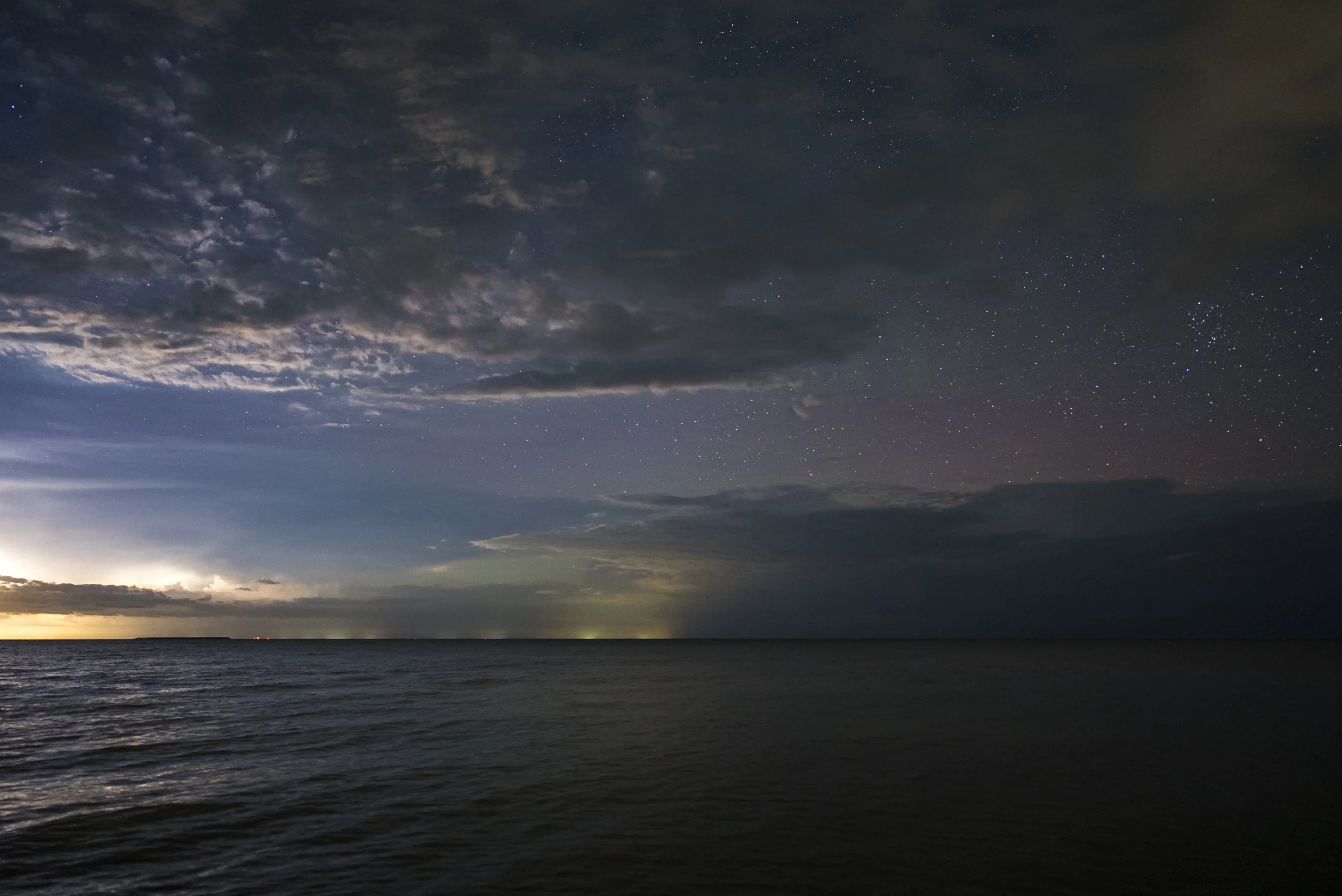
Traveling is always a highlight of summer and since Michigan has so many beautiful settings to take in the night sky. The weather didn’t always cooperate but these interruptions made for far more dramatic scenes than I could have ever imagined.
SONY - ILCE-7SM3 w/ FE 24 F1.4 GM
EXIF: ISO 3,200 | f/1.4 | 8 sec. ~ 24mm

Traveling is always a highlight of summer and since Michigan has so many beautiful settings to take in the night sky. The weather didn’t always cooperate but these interruptions made for far more dramatic scenes than I could have ever imagined.
SONY - ILCE-7M3 w/ FE 35 F1.4 GM
EXIF: ISO 6,400 | f/1.4 | 5 sec. ~ 35mm

Traveling is always a highlight of summer and since Michigan has so many beautiful settings to take in the night sky. The weather didn’t always cooperate but these interruptions made for far more dramatic scenes than I could have ever imagined.
SONY - ILCE-7M3 w/ FE 35 F1.4 GM
EXIF: ISO 3,200 | f/1.4 | 5 sec. ~ 35mm

Traveling is always a highlight of summer and since Michigan has so many beautiful settings to take in the night sky. The weather didn’t always cooperate but these interruptions made for far more dramatic scenes than I could have ever imagined.
SONY - ILCE-7MS3 w/ FE 24mm F1.4 GM - 20 images stacked with StarryLandscape, edited in Lightroom and Photoshop.
EXIF: ISO 6,400 | f/1.4 | .08 sec. ~ 24mm

Colorado has some of the best views of the night sky. The best part of this is often that these views are located high up in the Rockies, in places that can take a real commitment whether on foot or in 4Runner.
SONY ILCE-7RM3 w/ FE 35mm F1.4 GM - single image tracked with MoveShootMove tracker, edited in Lightroom and Photoshop.
EXIF: ISO 640 | f/2.8 | 248 sec. ~ 35mm

Colorado has some of the best views of the night sky. The best part of this is often that these views are located high up in the Rockies, while others can be viewed in plain sight. The High Plaines are home to dark sky, and this one holds the tributaries for the South Platte river, one of the Wests great arteries.
SONY ILCE-7RM3 w/ FE 35mm F1.4 GM - 20 images stacked with StarryLandscape Stacker, edited in Lightroom and Photoshop.
EXIF: ISO 6400 | f/1.4 | 8 sec. ~ 35mm
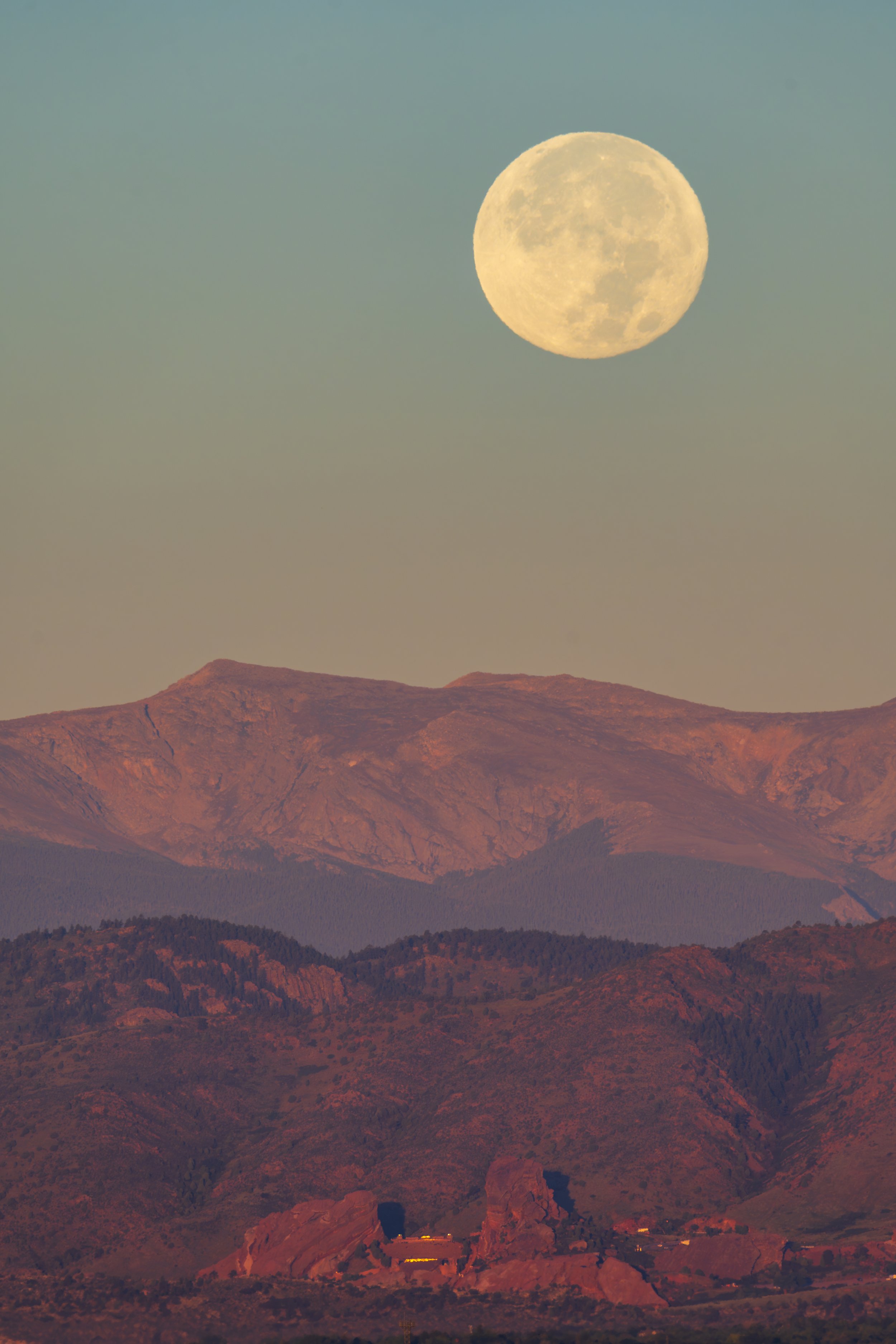
I always enjoy photographing the moon with the telephoto lens - the ability to create compositions with strong foregrounds, Red Rocks Amphitheater in this case, is compelling scene.
Apri, 2023

A second solar storm in 2023 unleashed the rare opportunity to witness the Northern Lights as far south as Arizona! On the plains east of Denver cloudy skies made for an imperfect view, but nonetheless an incredible one.
April, 2023
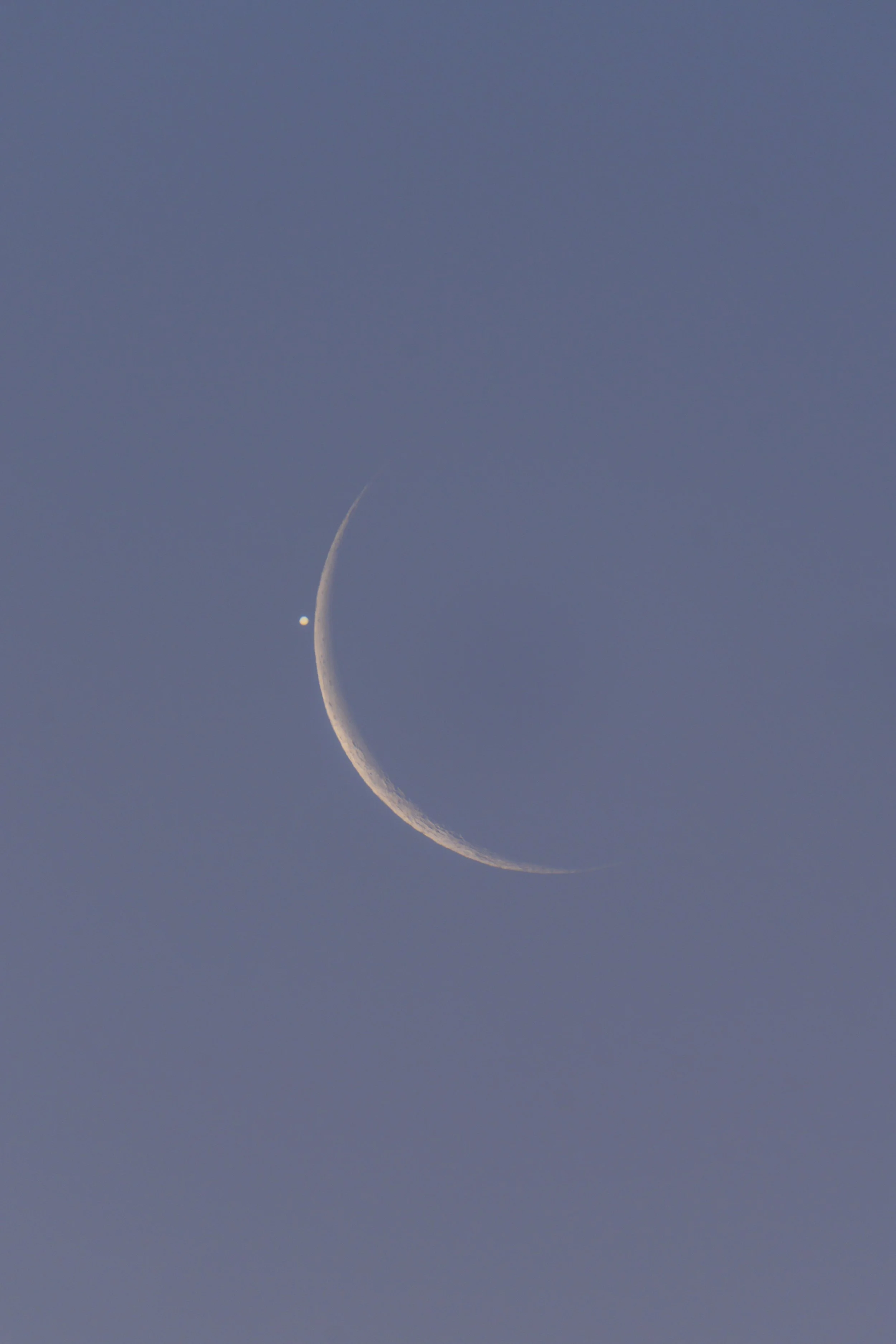
A little bit different view of the moon with Jupiter lining up next to a beautiful crescent.
Jupiter Occultation - May, 2023
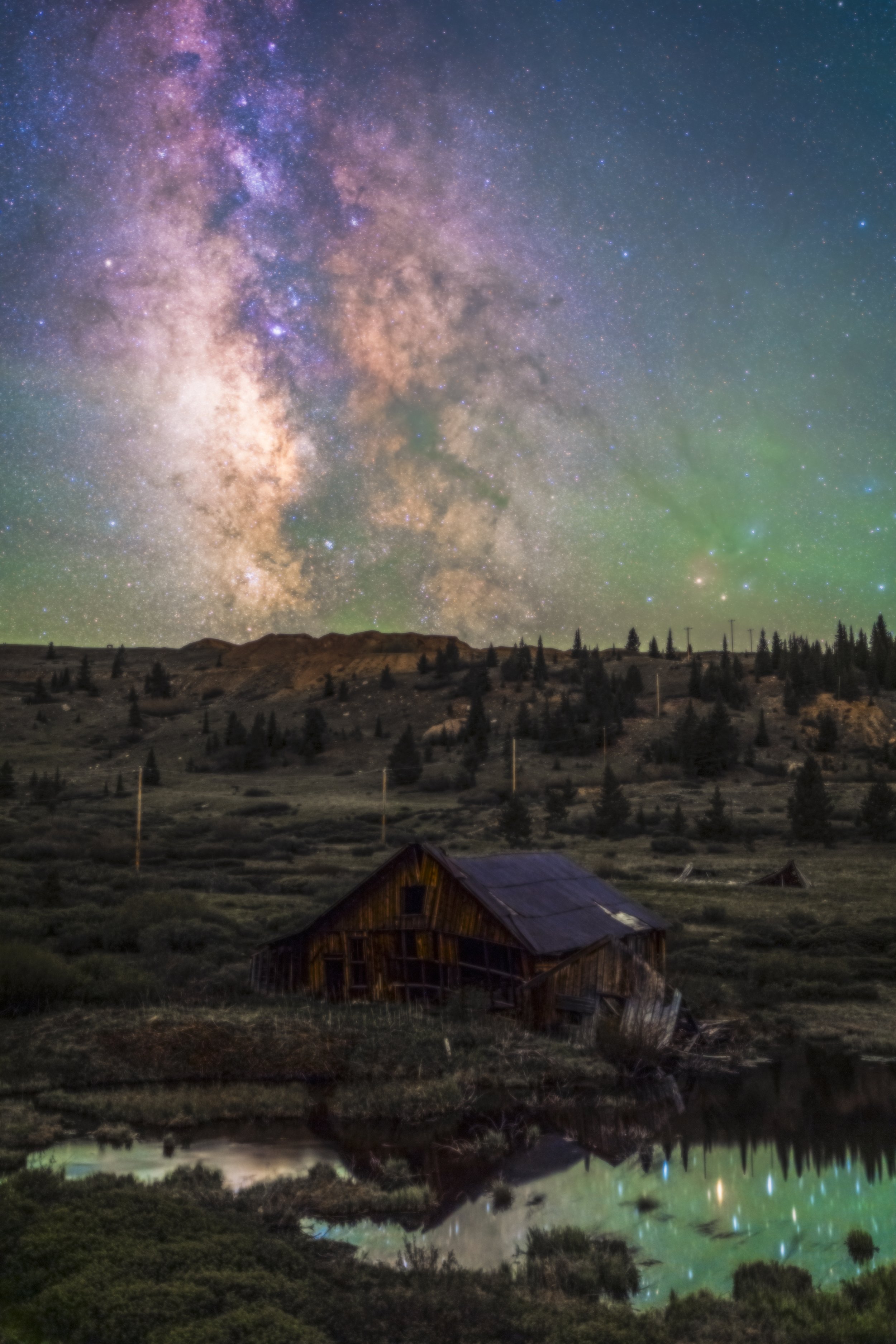
The setting may have changed but the scene is timeless - the core of the summer Milky Way resting over a high alpine meadow. The remnants of the centuries old mining district returning slowly to the land.
June, 2023

So many wonderful compositions along Windy Ridge. This pair of Bristlecone took a little long to get to, but provided a different frame for the early summer Milky Way.
June, 2023

So many stars, so many brilliant reflections - June, 2023 offered a brief pause to stare at the night sky.
June, 2023

A late evening alert on an Aurora app sent me out on a chase for a a clear view of the northern horizon. I found a spot near Fisherman's Island that I hadn't been to in many, many years. It worked out quite well!
August, 2023

A late evening alert on an Aurora app sent me out on a chase for a a clear view of the northern horizon. I found a spot near Fisherman's Island that I hadn't been to in many, many years. It worked out quite well!
August, 2023
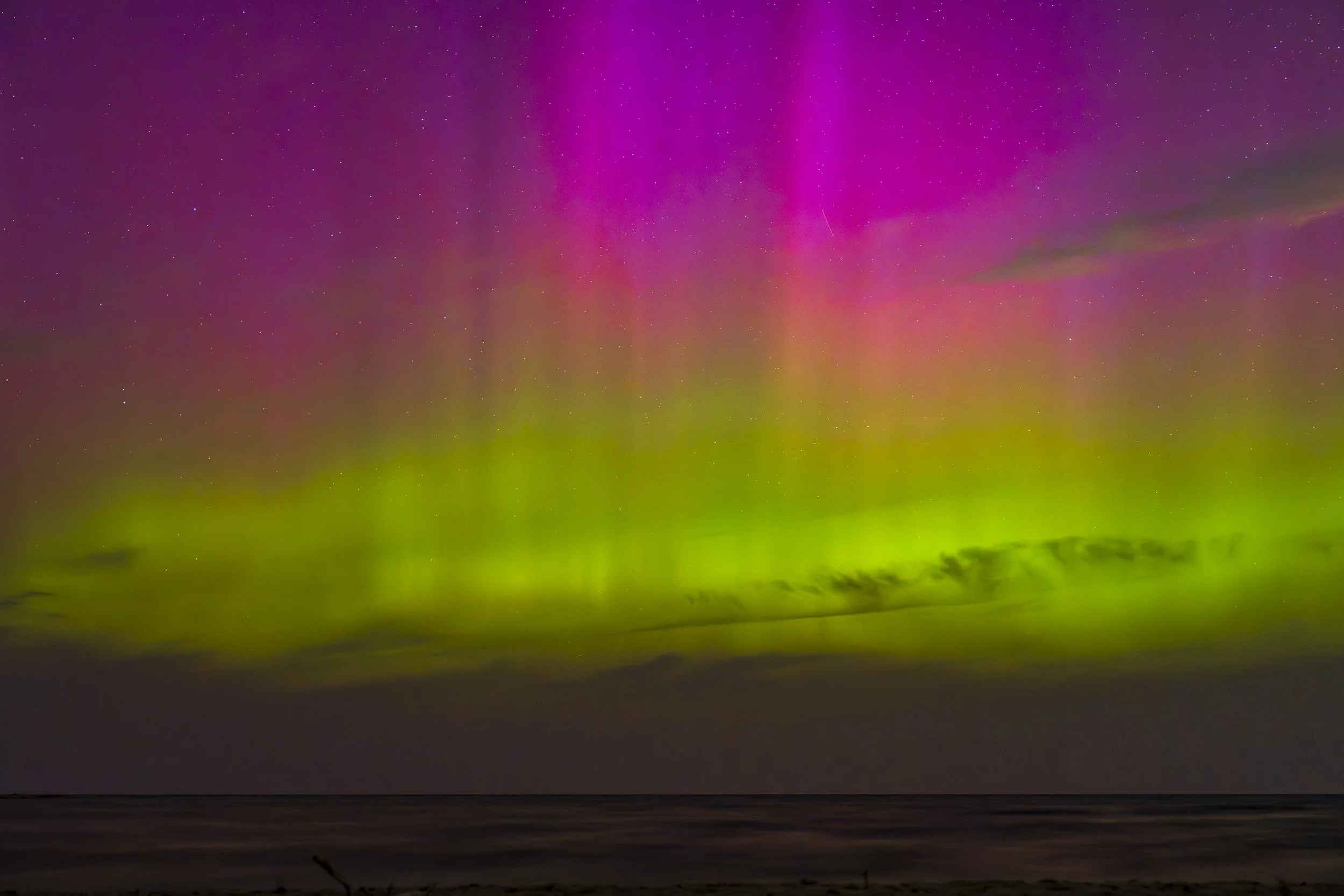
A late evening alert on an Aurora app sent me out on a chase for a a clear view of the northern horizon. I found a spot near Fisherman's Island that I hadn't been to in many, many years. It worked out quite well!
August, 2023
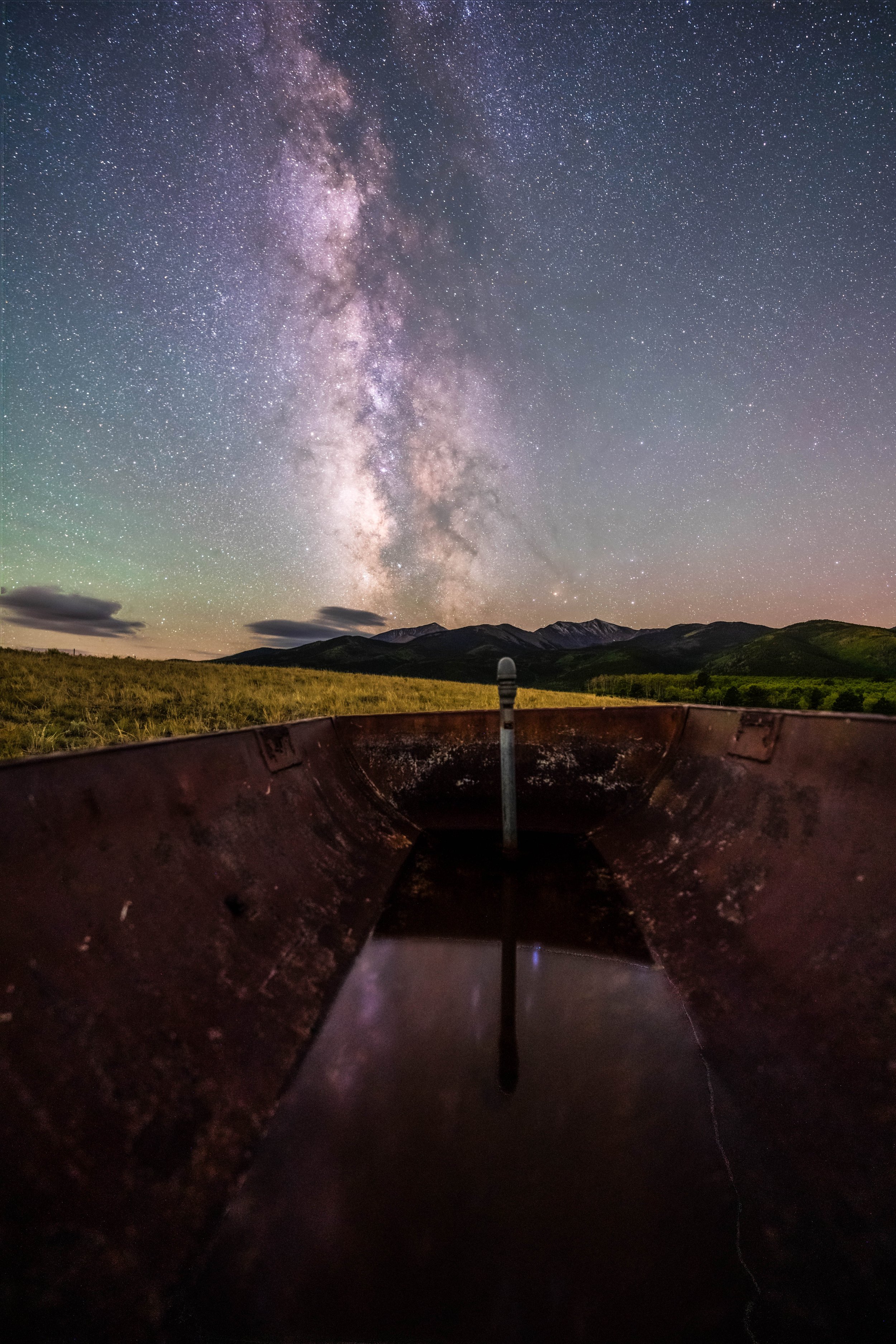
The old stock trough has seen a number of sights, from the deep winter snows, to the thousands of head of cattle that have lapped the refreshment of its cool water. Tonight the Milky Way danced on its waters.
September, 2023
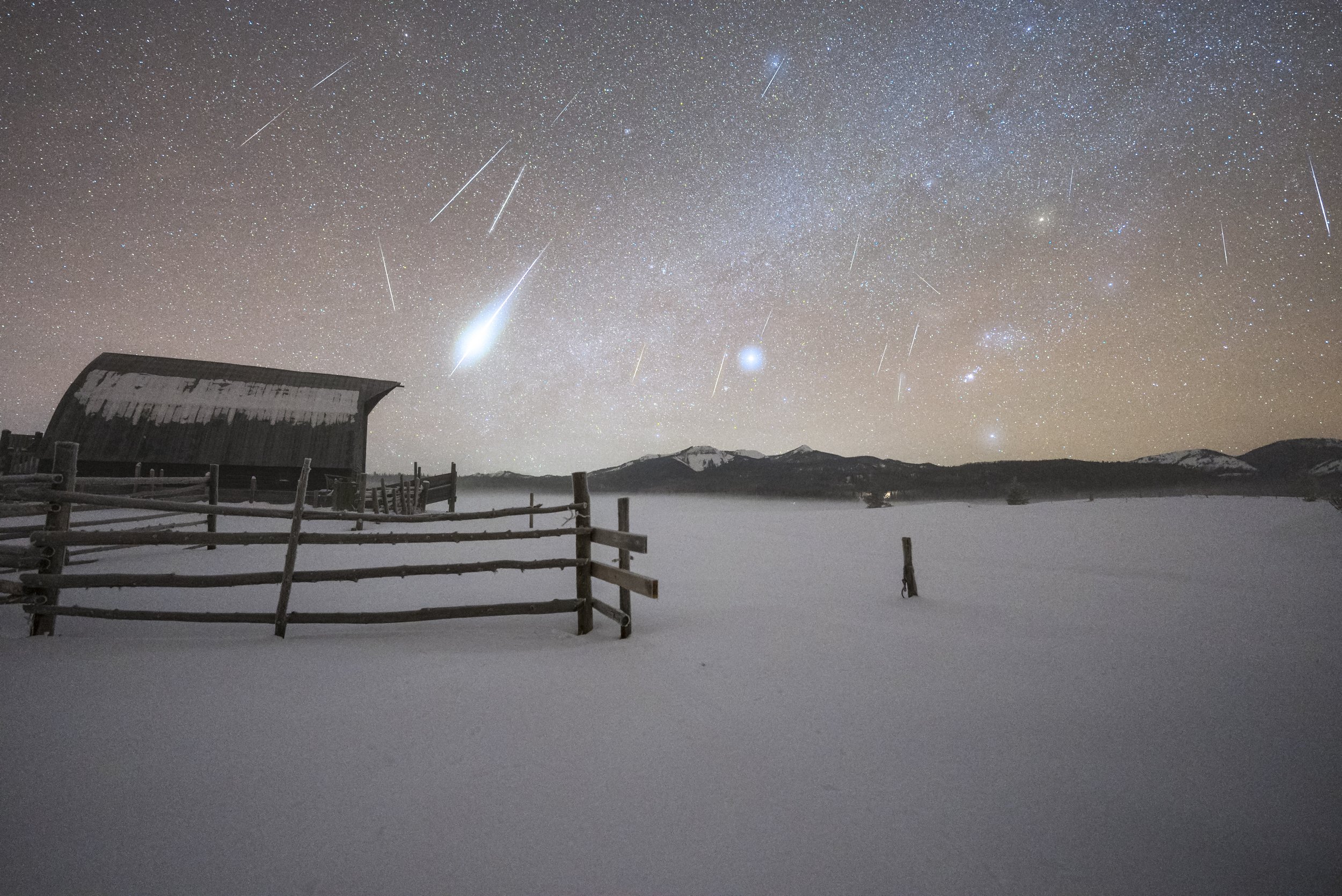
Two, breathtaking displays from the Gemini Meteor shower, one in Steamboat, the other on the shoulder of Mt. Blue Sky.
December, 2023

Two, breathtaking displays from the Gemini Meteor shower, one in Steamboat, the other on the shoulder of Mt. Blue Sky.
December, 2023
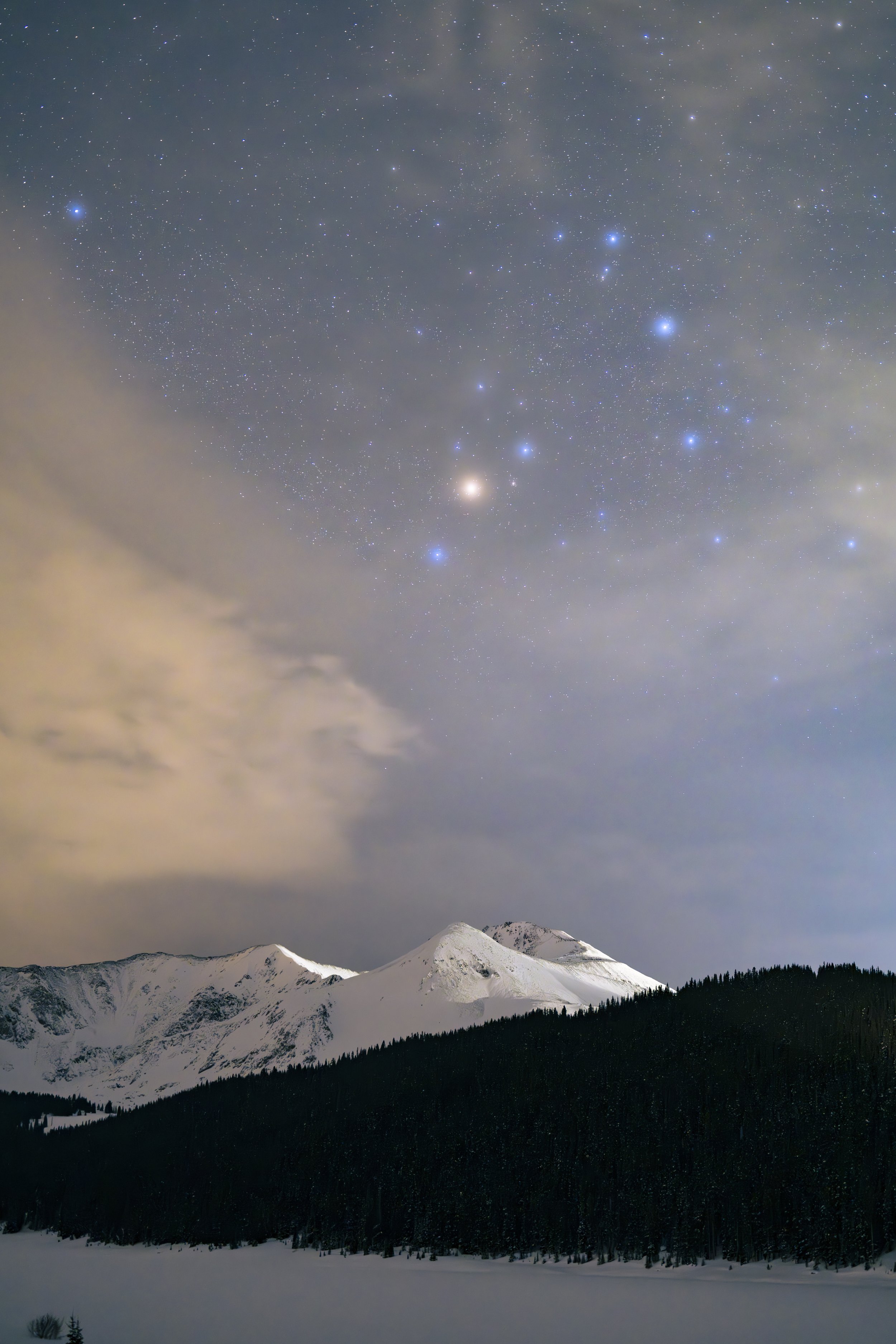
I missed last year's early season Milky Way, and even though this spring hasn't been prolific, a night out on the ice of Clinton Reservoir is a good reminder of both the tranquility and vulnerability contained in such moments.
Foxes and coyotes joined me a different points in the evening and long walks along the icy shore revealed the ever changing structure of the mountain lake.
February, 2024